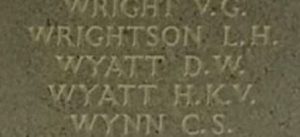Brynmawr is a market town situated in the historic county of Breconshire and is now part of Blaenau Gwent. The town is situated at the head of the South Wales Valleys and grew with the development of the local coal mining and iron industries in the early 19th century from its original settlement, which was named Gwaun Helygen, which sat on the border between the counties of Monmouthshire and Breconshire. The original village lay on the turnpike road from Abergavenny to Merthyr Tydfil and was surrounded with areas rich in coal deposits. With the development of Nantyglo ironworks, Gwaun Helygen was chosen as an ideal area for a settlement and houses sprang up rapidly to cope with the influx of workers. The men and women of Brynmawr who fell during both World Wars are commemorated on the Brynmawr Cenotaph, which is situated in Market Street. The cenotaph was unveiled in October 1927 by Major Wilfred Russell Bailey, originally to commemorate the local people who had died in the First World War, but had the names of the fallen of the later Second World War added following the end of that conflict. There are also memorials in some of the various churches and chapels in the town, which will be added on separate pages of this website as time allows.
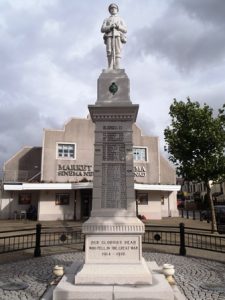
The Great War, 1914-1918
Bert Abraham, Private, 28376, South Wales Borderers. Bert was born in 1896, the son of Philip Abraham and Elizabeth Abraham (nee James), of 25, Gladstone Street, Brynmawr. He worked as a coal miner prior to enlisting at Brynmawr into the South Wales Borderers during the summer of 1915. Bert was drafted to Salonika during the spring of 1916, joining the 7th Battalion, South Wales Borderers, which was attached to 67 Brigade, 22nd Division. Large battles were fought in August 1916, at the battle of Horseshoe Hill, then in September 1916 at the battle of Machukovo. Between 24 April and 9 May 1917 the Division fought at the battle of Doiran, but no gains were made by the Allies, so both sides remained stagnant over the coming months. Bert contracted malaria soon afterwards and died at a Casualty Clearing Station on 13 August 1917. The 21-year-old was buried in Sarigol Military Cemetery, Kriston, Greece.
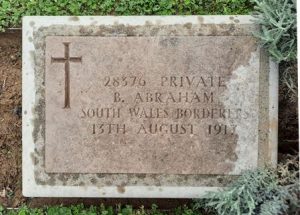
Richard Percy Adams, Captain, South Wales Borderers. Richard was born in Brynmawr in 1865, the son of Hannah Adams. He studied to become a teacher before taking up a post at Brynmawr County School, and became a member of the local Volunteer Battalion, South Wales Borderers. In 1908, following the creation of the Territorial Army, Richard transferred to the newly formed Brecknockshire Battalion, South Wales Borderers and he regularly attended every annual TA summer camp over the coming years. Richard resided at 201, King Street, Brynmawr, and was commissioned as Second Lieutenant into the Brecknocks just prior to the war. The battalion was attached to the Welsh Division and moved to Pembroke Dock upon mobilisation. It was then withdrawn from the Division, entraining at Neyland, and on 29 October 1914 sailed from Southampton for Bombay aboard the SS Dilwari, where the battalion transhipped and sailed for Aden, arriving on 16 December 1914. The battalion endured a torrid time in the heat of Aden, losing several men to heatstroke. In August 1915 the battalion moved to India on garrison duties, and remained there for the duration of the war. By the time that the Brecknocks returned home, Richard had gained the rank of Captain, however his health had broken down and he was suffering from the long lasting effects of dysentery, resigning his commission as a result in January 1921. Richard’s health continued to wane after the war and he died in hospital at Neath on 7 January 1922, aged 61.
Henry Andrews, Private, 38048, Royal Welsh Fusiliers. Henry was born in Worcester in 1872. He married Caroline Teague in 1898 and by 1911 the couple moved to 21, South Street, Beaufort, where Henry had gained work as a masons labourer. Henry enlisted into the Royal Welsh Fusiliers early in the war, but due to his age, or poor health, was posted to the Labour Corps. He served on home service for the duration of his time in uniform, then was discharged as medically unfit on 27 February 1919. Henry returned home to Beaufort where his health continued to fail, and he died of heart disease on 22 February 1920. The 48-year-old is buried in Brynmawr Cemetery. Henry is not commemorated on the Brynmawr Cenotaph.
James Arnold, Private, 2343, Monmouthshire Regiment. James was born in Blackwood in 1896, the son of James Allen Arnold and Caroline Ann Arnold (nee Whitcombe). The family moved to 170, King Street, Brynmawr by 1901, before settling at 12, Hill Street, Brynmawr. James worked for his father as a grocers assistant prior to enlisting at Abergavenny into the 3rd Battalion, Monmouthshire Regiment. The battalion mobilised at Abergavenny attached to the Welsh Border Brigade, Welsh Division, before moving to Pembroke Dock. On 10 August 1914 the Division moved to Oswestry before moving to Northampton, then spent Christmas at Bury St. Edmunds before moving to Cambridge. In February 1915 the 3rd Monmouth’s left the Welsh Division and landed in France on 14 February, before moving to the Ypres Salient. On 3 March 1915 the battalion joined 83 Brigade, 28th Division. On 8 April the 3rd Monmouth’s relieved a French Division in the sector east of the Polygon Wood to begin its first tour in the trenches. The battalion was relieved four days later, and marched to billets in Ypres, then on 17 April relieved the 5th King’s Own in the front line, to begin a spell which would last for 17 days without relief. On 22 April, just to the north, the Germans launched the first gas attack of the war upon French Colonial troops at Gravenstafel, heralding the opening of the Second Battle of Ypres. James was killed near Polygon Wood on 26 April 1915. The 18-year-old has no known grave and is commemorated on the Ypres (Menin Gate) Memorial, Belgium.
Joseph Booth, Private, 88777, Royal Welsh Fusiliers. Joseph was born in 1897, the son of Charles Booth and Emily Booth (nee Edwards), of 3, Blewitt Square, Brynmawr. He worked as a coal hewer prior to the war. Joseph enlisted into the army at Newport in the summer of 1917. He was drafted to France in the spring of 1918, joining the 2nd Battalion, Royal Welsh Fusiliers. The battalion had been in France attached to 19 Brigade since the outbreak of war, then in February 1918, during the reorganisation of the British Army, was transferred to 115 Brigade, 38th (Welsh) Division, which was holding a section of line in the Sailly-sur-la-Lys sector. The division moved to positions north of Albert, at Bouzincourt Ridge, at the end of March 1918, relieving the battered 2nd and 47th Divisions. It held this sector, carrying out minor operations and trench raids, over the coming months, before taking part in the great offensive of 21 August 1918, and began its advance towards the Hindenburg Line. During that first day, the Division launched an assault across the River Ancre, as part of the greater Allied offensive, and over the coming days captured Thiepval Ridge, Pozieres, Mametz Wood and High Wood, whilst advancing across the old Somme battlefields of 1916. The advance saw the Division take part in several costly assaults over the coming weeks, famously crossing the Canal du Nord, and then once the Hindenburg Line had been breached, the Division advanced north-east, past Le Cateau, towards the Forest of Mormal, forcing the crossing of the River Selle and over the coming days advanced to Englefontaine, on the western edge of the Forest of Mormal. On 4 November 1918 the division launched an assault from the south-eastern side of Englefontaine against the forest, in conjunction with attacks by the 17th and 18th Divisions, on its flanks. Joseph was killed in action during the assault that day, during an action which saw the 2nd RWF suffer heavy casualties. The 21-year-old is buried in Montay-Neuvilly Road Cemetery, Montay, France.
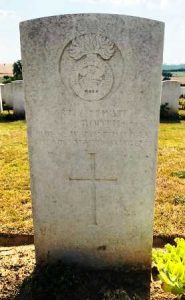
John Charles Bowen, Private, 45026, Northumberland Fusiliers. John was born in 1893, the son of Edward Bowen and Alice Maud Mary Bowen (nee Philpotts), of 5, Griffith’s Row, Nantyglo. His mother died in 1895 and his father remarried to a widow, Sarah Ann Michael (nee Newman), before moving the family to 22, Fitzroy Street, Brynmawr. John worked at the Blaina Collieries prior to enlisting into the Welsh Division Cyclist’s Corps soon after the outbreak of war. The division was the Welsh Territorial Army Division and upon mobilisation moved to Pembroke Dock, to help man the Milford Haven defences. In December the Division moved to Cambridge and then in May 1915 to Bedford, where the Division was numbered to the 53rd (Welsh) Division. On 19 July 1915 the entire Division sailed from Devonport for Imbros and on 9 August 1915 landed at Suvla Bay. The infantry moved off the beaches across the Salt Lake, under shellfire, into the scrub covered Chocolate Hill, but due to a lack of maps and no knowledge of the terrain, many of the units became disorientated, and the situation became chaotic. After the fighting died down, the winter rolled in, and the men first had to endure torrential downpours, which flooded the trenches, before the snow hit, and many men began falling ill in the terrible conditions. The Division was eventually evacuated from Gallipoli in December 1915, moving to Egypt to join the EEF, and helped guard the Suez Canal before taking part in operations to drive the Turks out of the Sinai. John was invalided home at some time and was later posted to France in the summer of 1917, joining the 1/5th Battalion, Northumberland Fusiliers. The battalion was attached to 149 Brigade, 50th (Northumbrian) Division and had been in France since April 1915. John probably joined the battalion whilst the division was holding a sector of line on the Sensée river, near Croisilles, where it was rebuilding following its efforts during the Battle of Arras. At the beginning of October the division was relieved and entrained for Flanders, arriving at Proven by 20 October before advancing via Boesinghe to take up a section of the line facing Passchendaele Ridge four days later. On 26 October the division launched its first assault against the ridge, but made no gains. John was wounded during the assault and was evacuated via the divisional Field Ambulance to Harlebeke, where he died of his wounds on 31 October 1917. The 24-year-old is buried in Harlebeke New British Cemetery, Belgium.
William Charles Bowles, Private, 7286, South Wales Borderers. William, known as Charles, was born in 1885, the son of George Bowles and Mary Bowles (nee Davies), of 1, River Row, Beaufort. He left home as a young man and on 8 April 1902 enlisted at Brynmawr into the South Wales Borderers. William served for about three years, before leaving the army. He married Elizabeth Jane Lloyd in 1907 and the couple set up home at 196, King Street, Brynmawr. William then found work as a Colliers Labourer Roadman, but as a former soldier and army reservist he was mobilised at the outbreak of war, embarking for France with the 1st Battalion, South Wales Borderers and disembarked at Le Havre on 13 August 1914. The battalion was attached to 3 Brigade, 1st Division and entrained for the Belgian frontier, near the town of Mons. The Division then took part in the Battle of Mons on 23 August, following the German invasion of the low countries, and in the epic withdrawal from Mons to the River Marne, where the German drive on Paris was halted. The Germans then withdrew north and took up defensive positions north of the River Aisne, along the Chemin des Dames Ridge and the BEF advanced before launching a frontal attack upon the German positions. The battle ended in a stalemate and both sides dug-in, beginning the line of trenches which was to become known as the Western Front. The BEF then began moving to Flanders on 17 October, before advancing from Poperinghe past endless numbers of refugees and took up positions guarding the strategically vital city of Ypres, the 1st Division taking up positions near Langemarck by 21 October. Later that day the division was attacked by hordes of Germans, mainly young student-soldiers, who were mown down by the highly trained British soldiers. The Germans maintained their attacks over the coming days but were held at bay, sustaining terrible losses, and the line here stabilised, so by 27 October the 1st Division moved to positions near Zandvoorde, guarding the Menin Road. On 31 October 1914 the 1st Division faced its sternest test so far, when the Germans attacked its positions on the Menin Road, behind a fearsome artillery bombardment. Heavy fighting raged over the coming days as the British line was broken, but heroic fighting resulted in the German advance being held and a new front line created. Charles was killed in action on the Menin Road on 2 November 1914. The 29-year-old has no known grave and is commemorated on the Ypres (Menin Gate) Memorial, Belgium.
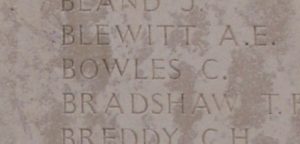
Isaac Britton, Private, 43897, Welsh Regiment. Isaac was born in 1881, the son of Aaron Britton and Mary Britton (nee Williams), of 39, Bailey Street, Brynmawr. His parents had moved to Franklin, Ohio soon after their marriage, and Aaron had fought in the US Civil War before the couple left the US and returned to Brynmawr by about 1872. Isaac married Margaret Taylor in 1908 and the couple set up home at 22, Market Row, Nantyglo. He worked as a coal miner and had served with the Brecknockshire Battalion, South Wales Borderers prior to the war. Isaac enlisted into the army early in 1916 and was drafted to Egypt to join the 8th Battalion, Welsh Regiment. The battalion was the Pioneer Battalion to the 13th (Western) Division and had been evacuated to Egypt from Gallipoli on 8 January 1916, concentrating at Port Said, where it held forward posts in the Suez Canal defences. On 12 February 1916 the Division began to move to Mesopotamia, to strengthen the force being assembled for the relief of the besieged garrison at Kut al Amara. By 27 March, the Division had assembled near Sheikh Saad and came under orders of the Tigris Corps, and then took part in the attempts to relieve Kut. However, after these efforts failed and Kut fell, the British force in the theatre was built up and reorganised. The Division then fought at the Battle of Kut al Amara, then at the capture of the Hai Salient and the capture of Dahra Bend. Isaac was killed during the fighting around the Hai river on 25 January 1917. The 36-year-old has no known grave and is commemorated on the Basra Memorial, Iraq. Isaac is not commemorated on the Brynmawr Cenotaph.
Reginald Brown, Private, 1707, Monmouthshire Regiment. Reginald was born on 17 November 1896, the son of Samuel Brown and Martha Brown (nee Davies), of 24, Hatter Street, Brynmawr. His mother died in 1899, so Reginald was adopted by Augusta Bertie at Nantyglo. By 1911 he was residing with his half-brother, Ernest Davies, at 37, Worcester Street, Brynmawr and was working as a coal miner. Reginald had been a member of the Brecknockshire Battalion, South Wales Borderers prior to the war, but when war was declared, he was posted to the 1/1st Battalion, Monmouthshire Regiment. The battalion mobilised at Stow Hill, Newport as part of the Welsh Border Brigade, Welsh Division before moving to Pembroke Dock. On 10 August 1914 the Division moved to Oswestry before moving to Northampton, then spent Christmas at Bury St. Edmunds before moving to Cambridge. In February 1915 the 1st Monmouth’s left the Welsh Division and embarked for France at Southampton on 14 February, disembarking at Le Havre the following day before entraining for Cassel and marched to billets at Dranoutre. The battalion then moved to Wulverghem and joined 84 Brigade, 5th Division before moving into the trenches for the first time. On 6 April, 84 Brigade moved to Locre to re-join the 28th Division before taking over positions at Frezenberg Ridge. On 22 April, just to the north, the Germans launched the first gas attack of the war upon French Colonial troops at Gravenstafel, heralding the opening of the Second Battle of Ypres. The fighting remained to the north of Polygon Wood until 3 May, when the Germans widened their attacks and the Polygon Wood sector was evacuated by the 28th Division, which fell back on the G.H.Q. line at Potijze. Over the coming days their new positions were shelled mercilessly, then on 8 May the Germans attacked. Despite heavy losses the Division held firm. Reginald was wounded at some time during this terrible period and was invalided back to Britain. Upon recovering, he was posted to Park Hall Camp at Oswestry. On the night of 30 March 1916, Reginald was returning to camp from Oswestry together with two friends, when the men were struck by a train as they crossed the Great Western branch line between Oswestry and Gobowen. Reginald and Allan Young were killed, whilst the third man, Thomas Pugh, was seriously injured and taken to the Oswestry Cottage Hospital. Reginald was 19 years old when he died that night. His body was taken home and he was buried in St. Tudwr’s Churchyard, Myniddislwyn on 5 April. His nephew, Reginald Ernest Davies, emigrated to Pennsylvania in the US and served during the Second World War with the 101st Airborne Division (of Band of Brother’s fame), gaining the awards of the Silver Star, Bronze Star and the Purple Heart as well as the Presidential Unit Citation.
Wilfred Calloway, Private, 26391, Grenadier Guards. Wilfred was born in 1895, the son of John Penarwood Calloway and Sarah Jane Calloway (nee Kelson), of Alma Terrace, Brynmawr. He left home to become an apprentice draper and lodged at Alma House, Newport, then in 1914 returned home, setting up his own drapery business in Somerset Street, Abertillery. Wilfred enlisted into the army in the spring of 1915, joining the Grenadier Guards. Wilfred was drafted to France in the spring of 1917, joining the 2nd Company of the 1st Battalion, Grenadier Guards. The battalion was attached to the 3rd Guards Brigade, Guards Division and was in the Somme sector in February 1917. The Guards followed up the German withdrawal to the Hindenburg Line the following month, reaching Tincourt, east of Péronne, by the middle of April. The 1st Grenadier Guards then spent several weeks resting and training at Tincourt before moving back behind the lines to Corbie and on 30 May entrained for St. Omer, and subsequently marched to Campagne. For the first fortnight in June it remained training at Campagne, and then proceeded to Zudausques, then on 18 June the battalion moved to Herzeele, where it remained until 13 July. The 3rd Guards Brigade then moved up into the line north of Boesinghe, on the left flank of the 38th (Welsh) Division, in order to take part in the opening assault of the Third Battle of Ypres, the Battle of Pilckem Ridge, which was to be launched on 31 July. During the weeks leading up to this battle, the units of the Guards Division rotated between duty in the front line here. On 13 July the 1st Grenadier Guards began a routine tour in the line and helped beat off a German trench raid that night. Wilfred was wounded during the fighting and was evacuated to the 4th Casualty Clearing Station, where he died of his wounds on 18 July 1917. The 22-year-old is buried in Dozinghem Military Cemetery, Belgium.
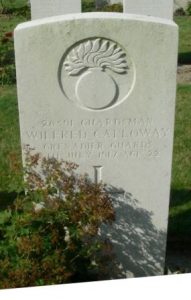
James Challenger, Private, 28375, South Wales Borderers. James was born at Resolven in 1897, the son of Isaac Challenger and Sarah Jane Challenger (nee Weeks). The family moved to the Eagle Inn, Beaufort by 1911 and James found work at the Ebbw Vale Steelworks prior to the war. He enlisted at Brynmawr into the South Wales Borderers in the summer of 1915 and in January 1917 was drafted to Salonika, joining the 7th Battalion, South Wales Borderers. The battalion had formed at Brecon in September 1914, before moving to Seaford to join 67 Brigade, 22nd Division and had been in Salonika since November 1915. James had only been at the front for six weeks when he was killed in action during a routine tour in the trenches on 17 March 1917. The 19-year-old is buried in Karasouli Military Cemetery, Greece.
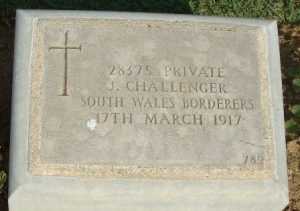
Robert James Clarke, Sergeant, 22484, South Wales Borderers. Robert was born in 1891, the son of Joseph Clarke and Mary Jane Clarke (nee Powell), of 14, Hatter Street, Brynmawr. The family had moved to 42, Bournville Road, Blaina by 1911. Robert worked as a coal hewer prior to the war. He had a son, Reginald, with Maud Brown, of Blaina, born on 13 March 1912, then in 1915, after having enlisted into the army, the couple married. Robert was by now serving with the 11th Battalion, South Wales Borderers, which was at Colwyn Bay attached to the 43rd (Welsh) Division. The Division trained in North Wales before moving to Winchester in the summer of 1915, where the formation became renumbered 115 Brigade, 38th (Welsh) Division. The Division began moving to France on 2 December 1915 and moved to the Nursery Sector near Fleurbaix for trench initiation alongside the Guards Division. The Division then held a sector of the line near Cuinchy before marching south to the Somme sector in June 1916 to take part in the assault on Mametz Wood. The first attack on the wood was launched on a two-battalion front on 7 July, but failed, and the Divisional Commander, Sir Ivor Philipps, was replaced before the Division attacked again on a two Brigade front on 10 July 1916. After two days of ferocious hand-to-hand fighting, the wood was cleared up to its northern edge, before the battered Division was relieved. It then took over a section of the front at Hébuterne before moving to the Ypres Salient and taking over the Canal Bank sector at Boesinghe. The infantry battalions of the Division then began carrying out the normal pattern of rotation in the trenches, four days in the front, four in support and four in reserve, whilst also working on trench improvement, digging new trenches, and carrying out regular patrols and trench raids. On 31 July 1917 the Division launched its famous assault on the Pilckem Ridge, capturing Iron Cross and reaching its objective of the Steenbeek. Robert was killed in action during the assault that day. The 26-year-old is buried in Artillery Wood Cemetery, Belgium. Robert is not commemorated on the Brynmawr Cenotaph.
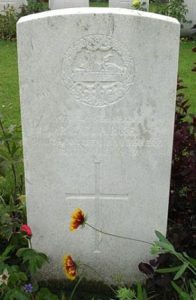
William Ernest Coldrick, Private, 11469, Gloucestershire Regiment. William was born at Highleadon, Gloucestershire in 1894, the son of Kate Coldrick. Following the death of his mother in 1903, he went to live with his uncle, Fred Coldrick, at 50, Edde Cross Street, Ross-on-Wye, then with his aunt, Mary Ann Coldrick, at 15, Hill Street, Brynmawr. William enlisted at Gloucester into the 8th Battalion, Gloucestershire Regiment soon after the outbreak of war. The battalion formed at Bristol in September 1914, moving to Perham Down to join 57 Brigade, 19th (Western) Division. The battalion moved to France on 18 July 1915, and moved with the division to positions near Loos, where it took part in the opening attack of the Battle of Loos on 25 September 1915. The division suffered terrible casualties for no gains during this diversionary attack and rebuilt in the Givenchy sector. At the end of April 1916 the division was relieved and moved back into the 1st Army Training Area at Cresgues, before moving to Vignacourt, in the Somme rear area to begin an intensive training regime, in preparation to take part in the Somme offensive. On 27 June the division moved into support positions and watched the initial assault which began at 05.20 on 1 July 1916. On the following day the division moved forwards into the new front-line and took part in the second wave of the attack on Ovillers-La Boiselle. William was killed in action during the fighting for the village on 3 July 1916. The 22-year-old is buried in Ovillers Military Cemetery, France. William is not commemorated on the Brynmawr Cenotaph.
Stephen Colin, Second Engineer, Mercantile Marine. Stephen was born as Aaron Stephen Pearce in 1888, the son of Clara Maria Pearce, of 99, Worcester Street, Brynmawr. His mother married William Colin in 1891, and the couple set up home at 113, Worcester Street, Brynmawr, where Stephen assumed his stepfathers’ surname. Stephen worked as an engine fitter prior to the war, and lodged with the Gilbert family at 20, Coedcae Place, Pontypool. He went to work as an engineer at the Jarrow shipbuilding yard prior to the war, then enlisted into the Mercantile Marine and with his engineering skills was posted as Second Engineer aboard the Cardiff registered steamship SS Ampleforth. On 21 May 1917 Ampleforth was steaming some fifteen miles off Gozo en-route from Barry to Alexandria, with a mixed cargo of coal and crated aircraft, when she was torpedoed and sunk by the German submarine U65, going down with the loss of four lives. Stephen was 28 years old when he drowned that day. He has no known grave so is commemorated on the Tower Hill Memorial, London. His step-brother, William Colin, was killed on the Somme in 1916.
William George Colin, Private, 53769, Welsh Regiment. William, known as George, was born on 21 October 1895, the son of William Colin and Clara Maria Colin (nee Pearce), of 113, Worcester Street, Brynmawr. He enlisted at Brynmawr into the Welsh Regiment under the name of George Collins during the summer of 1916 and was drafted to France a year later, joining the 9th Battalion, Welsh Regiment, which was on the Somme, attached to 58 Brigade, 19th (Western) Division. George joined the battalion as it was rebuilding following heavy losses during the opening stages of the Somme offensive in July 1916. After a brief rest the 19th Division then took part in an assault from the Heligoland Trenches against Contalmaison in daylight behind a creeping artillery barrage, the first time this strategy was used, suffering heavy casualties again, but reaching the outskirts of the village. The division was then relieved and moved back behind the lines to rebuild, in bivouacs at Baisieux Wood whilst heavy fighting continued around Ovillers and Trônes Wood. During the last few days of September and the first week in October, the British made notable advances to the north of Thiepval and towards Bapaume, capturing the villages of Le Sars and Eaucourt L’Abbaye. Winter then fell upon the Somme, yet the fighting raged on and British attention turned towards the Ancre valley. The 19th Division, which had moved to the Bailleul area to refit, was brought back south at the beginning of October and took part in the final operations which ended with the capture of Beaumont Hamel. On 26 October the 9th Welsh relieved the 9th Loyal’s in the Stuff Redoubt trenches, and endured a very trying period in the line. George was killed in action as the 9th Welsh were about to be relieved here on 5 November 1916. The 20-year-old was originally buried on the battlefield, but his grave was located by a Canadian Burial Party in April 1919 and he was re-interred in Regina Trench Cemetery, Grandcourt, France. His stepbrother, Stephen Colin, was killed at sea in 1917.
Patrick Collins, Private, L. R. Patrick cannot presently be identified. Two men of that name were killed with the Leinster Regiment, and another with the London Regiment, but none have any Welsh ties.
James Augustus Cooper, Private, 26016, Gloucestershire Regiment. James, known as Augustus, was born in 1893, the son of George Cooper and Annie Cooper (nee Thomas), of 140, King Street, Brynmawr. He worked as a coal hewer prior to enlisting at Brynmawr into the Gloucestershire Regiment in the summer of 1915. Augustus was drafted to France in the spring of 1916, joining the 8th Battalion, Gloucestershire Regiment. The battalion was in the Givenchy sector, attached to 57 Brigade, 19th (Western) Division. At the end of April 1916 the division was relieved and moved back into the 1st Army Training Area at Cresgues, before moving to Vignacourt, in the Somme rear area to begin an intensive training regime, in preparation to take part in the Somme offensive. On 27 June the division moved into support positions and watched the initial assault which began at 05.20 on 1 July 1916. On the following day the division moved forwards into the new front-line and took part in the second wave of the attack on Ovillers-La Boiselle. Augustus was killed in action during the fighting for the village on 3 July 1916. The 23-year-old has no known grave and is commemorated on the Thiepval Memorial, France.
Henry Craddock, Private, M/347140, Royal Army Service Corps. Henry was born in Manningham, Yorkshire in 1877, the son of Elizabeth Craddock. His mother married Alfred Allinson two years later and Henry was brought up as his son. He was living at Brynmawr by 1901, when he married Esther Maud Ford. The couple had two sons before Esther’s untimely death in 1910, so Henry started working as a tractor driver and electrician for the fair and by 1911 was living in a caravan at Edinburgh Gardens, Pembroke Dock with their sons. Living with them was sixteen-year-old Alice Edith Hoffman. Henry enlisted into the Army Service Corps on 24 June 1916 and served on the Western Front for almost two years. He was discharged from the army as medically unfit on 29 October 1918 after having contracted tuberculosis. By now he had a child, Thomas George Craddock, with young Alice. Henry died of tuberculosis in hospital in Manchester on 7 November 1921. The 44-year-old is not commemorated by the CWGC as he died after the cut-off date for commemoration. His son, Thomas George Craddock, died whilst a Japanese POW in 1942.
Trevor Cross, Private, 53770, Welsh Regiment. Trevor was born on 19 September 1895, the son of Thomas Cross and Mary Cross (nee James), of 24, Well Street, Brynmawr. He worked as a butcher’s errand boy prior to the war. Trevor enlisted at Brynmawr into the army and was drafted to France in 1916, joining the 9th Battalion, Welsh Regiment, which was on the Somme, attached to 58 Brigade, 19th (Western) Division. George joined the battalion as it was rebuilding following heavy losses during the opening stages of the Somme offensive in July 1916. After a brief rest the 19th Division then took part in an assault from the Heligoland Trenches against Contalmaison in daylight behind a creeping artillery barrage, the first time this strategy was used, suffering heavy casualties again, but reaching the outskirts of the village. The division was then relieved and moved back behind the lines to rebuild, in bivouacs at Baisieux Wood whilst heavy fighting continued around Ovillers and Trônes Wood. During the last few days of September and the first week in October, the British made notable advances to the north of Thiepval and towards Bapaume, capturing the villages of Le Sars and Eaucourt L’Abbaye. Winter then fell upon the Somme, yet the fighting raged on and British attention turned towards the Ancre valley. The 19th Division, which had moved to the Bailleul area to refit, was brought back south at the beginning of October, and took part in the final operations which ended with the capture of Beaumont Hamel. On 26 October the 9th Welsh relieved the 9th Loyal’s in the Stuff Redoubt trenches and endured a very trying period in the line. Trevor was wounded during the final stages of the Somme offensive, on the Ancre, and was evacuated to hospital in Rouen where he died of his wounds on 11 December 1916. The 20-year-old is buried in St. Sever Cemetery Extension, Rouen, France.
David James Davies, Lance Corporal, 10523, South Wales Borderers. David was born in 1887, the son of Edward Davies and Ann Davies, of Upper Gelly, Llanelly Hill. The family later moved to 60, King Street, Brynmawr. David had left home as a young man to enlist into the army and by 1911 was in South Africa with the 2nd Battalion, South Wales Borderers. The battalion was in Tientsin, China at the outbreak of war and took part in a famous operation with the Japanese against the German held port of Tsingtao on 23 September. On 4 December the battalion embarked at Hong Kong and landed at Plymouth on 12 January 1915, entraining for Rugby to join 87 Brigade, 29th Division. On 17 March 1915 the battalion sailed from Avonmouth with the Division, arriving at Alexandria on 29 March, before moving to Mudros. On 25 April 1915 the Division landed at Cape Helles, Gallipoli, as part of the original landing force which had been despatched to try and seize the Dardanelles Straits and force Turkey out of the war. The invasion forces failed to break the Turkish defences and the campaign became bogged down, so after an arduous eight months on the Peninsula the 29th Division was evacuated to Egypt on 11 January 1916, before being transferred to the Western Front, landing at Marseilles on 15 March and entraining for the Somme sector, taking up positions near Beaumont Hamel, facing Y-Ravine. The Division had an arduous time here too over the coming months, before taking part in a suicidal assault on 1 July 1916, on the opening day of the Somme offensive. The 2nd SWB alone suffered some 384 casualties on that day alone. Although severely depleted, the Division remained in the line here over the coming weeks, in trying conditions. The Division was then pulled out of the line to rest and rebuild before moving back into the line and taking part in the latter stages of the Somme offensive. The Division wintered on the Somme, taking part in the advance which followed the German withdrawal to the Hindenburg Line. At the beginning of April, the entire 29th Division moved out of the Somme sector to the Arras sector, and by 9 April took over a section of the line facing Monchy-le-Preux. The Division then began to prepare for the forthcoming Battle of Arras. At dawn on 23 April 1917, the Division launched an assault on Monchy-le-Preux. The 2nd SWB captured the front-line German trench and advanced some 300 yards beyond before consolidating its gains. David was killed in action at some time during the day. The 29-year-old has no known grave and is commemorated on the Arras Memorial, France. David is also commemorated on the Llanelly Hill war memorial.
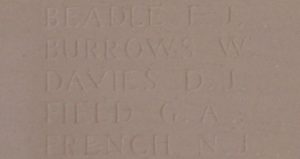
George Davies, Private, 15040, King’s Shropshire Light Infantry. George was born at Bosbury, Herefordshire. He had come to live at Blewitt Square, Brynmawr prior to the war and had fathered a child with Ethel Smith. George enlisted at Hereford into the 5th Battalion, King’s Shropshire Light Infantry soon after the outbreak of war. The battalion had formed at Shrewsbury before joining 42 Brigade, 14th (Light) Division at Aldershot, then in November 1914 moved to billets at Chiddingfold. In March 1915 the battalion moved back to Aldershot, then on 20 May 1915 landed at Boulogne with the division, before entraining for Cassel and marching to billets at Erkelsbrugge. A week later the battalion marched via Eecke into the Ypres Salient, where the division took over positions near Zillebeke. The Division was to see its first action during the Action of Hooge, where the Division were the first to be attacked by the German use of flamethrowers. After horrendous fighting the division managed to hold its ground in the support line, but had suffered terrible casualties, before being relieved on 6 August. The division then had a brief respite to rest and refit before moving back into the line on the Menin Road by 24 September, in order to take part in a diversionary attack, the Second attack on Bellewaarde, on the following morning, 25 September 1915. George was killed in action during the day, in a futile assault which saw the 5th KSLI alone suffer sone 430 casualties. He has no known grave and is commemorated on the Ypres (Menin Gate) Memorial, Belgium.
Isaac Davies, Private, 54784, Royal Welsh Fusiliers. Isaac was born at Llanwrtyd Wells in 1886, the son of James Davies and Anne Davies. By 1901 the family had moved to 28, Worcester Street, Brynmawr, where James had found work as a haulier. Isaac worked as a Grocer’s Assistant prior to the war. He enlisted into the Glamorganshire Yeomanry at Tonypandy and after completing his training was transferred to the Royal Welsh Fusiliers. Isaac was drafted to France in the autumn of 1916, joining the 15th Battalion, Royal Welsh Fusiliers, which was at Ypres, holding the Canal Bank sector at Boesinghe, attached to 113 Brigade, 38th (Welsh) Division. The Division had moved there following its epic assault on Mametz Wood in July. Upon its arrival the infantry battalions of the Division then began carrying out the normal pattern of rotation in the trenches, four days in the front, four in support and four in reserve, whilst also working on trench improvement, digging new trenches, and also carrying out regular patrols and trench raids. During the summer of 1917 the Division began training and preparing to take part in the opening offensive of the forthcoming Third Battle of Ypres, or Passchendaele, tasked with the capture of Pilckem Ridge. By 23 July the 15th RWF had completed its training behind the lines and moved back into the front-line at the Canal Bank, to begin its final tour in the line before the attack. Reports then reached battalion HQ that the Germans had withdrawn, so at dawn on 25 July 1917 the battalion sent out a raiding party to verify the intelligence. Unfortunately, the Germans were still in position and the raiding party came under heavy machine-gun fire. Isaac was killed in action that day. The 31-year-old has no known grave and is commemorated on the Ypres (Menin Gate) Memorial, Belgium.
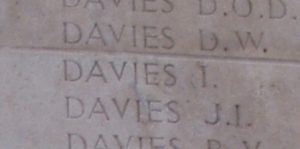
Joseph Davies, Gunner, 4222, Royal Garrison Artillery. Joseph was born in 1873, the son of Margaret Davies. His mother was widowed soon after his birth, and remarried to Joseph Huish, of Brynmawr. Joseph resided at 8, Fitzroy Street, Brynmawr prior to the war and worked as a coal miner. Joseph had enlisted into the Royal Monmouthshire Royal Engineers at Brynmawr on 29 April 1892. The regiment, the oldest Militia unit in the army, ran on the same basis as what was to become the Territorial Army, so members were part time soldiers. Joseph carried out two spells with the RMRE, enlisting again on 22 May 1907, so by the time war erupted he re-enlisted into the regular army, joining the Royal Garrison Artillery at Brynmawr on 15 October 1914. He was then posted to the 41st Battery, RGA, then to the 38th Battery before being sent to Malta to join the 63rd Battery, which formed part of the harbour defences there. After almost two years service, his health began to fail and he was discharged as medically unfit on 14 October 1916, returning home to Brynmawr where he gained work as a stationary engine driver. His health continued to fail him after the war and Joseph went to live with his brother-in-law, at 17, Charles Street, Rogerstone, where he died of heart failure on 5 December 1920. Joseph is not commemorated as a war casualty by the CWGC, nor is he commemorated on the Brynmawr Cenotaph.
Alfred Ernest Dewsbury, Lance Corporal, 6139, South Wales Borderers. Alfred was born at Cannock in 1880, the son of Alice Dewsbury, an 18-year-old domestic servant. His mother gave birth to another son, Percy, two years later, before leaving the area and came to Crickhowell with her younger son, Percy, leaving Alfred with her mother and she gained work as a servant. Alice was imprisoned at Brecon Jail for abandoning her son on 19 January 1885 and upon her release, went back to Cannock, where she married Thomas Haughton in 1893. Percy was raised in care before emigrating to the USA in 1899, whilst Alfred enlisted into the army, serving during the Boer War of 1899-1902 with the 2nd Battalion, South Wales Borderers. He served for several years with the regiment, but by 1911 had left the army and was lodging at 16, Iron Row, Tredegar, where he worked as an underground coal haulier. Alfred married Johanna Morgan, of 17, Bailey Street, Brynmawr in 1913. As a former soldier, he was an Army Reservist, so was mobilised upon the outbreak of war, joining the 1st Battalion, South Wales Borderers. He embarked for France with the 1st Battalion, South Wales Borderers and disembarked at Le Havre on 13 August 1914. The battalion was attached to 3 Brigade, 1st Division and entrained for the Belgian frontier, near the town of Mons. The Division then took part in the Battle of Mons on 23 August, following the German invasion of the low countries, and in the epic withdrawal from Mons to the River Marne, where the German drive on Paris was halted. The Germans then withdrew north and took up defensive positions north of the River Aisne, along the Chemin des Dames Ridge and the BEF advanced before launching a frontal attack upon the German positions. The battle ended in a stalemate and both sides dug-in, beginning the line of trenches which was to become known as the Western Front. Alfred was wounded at some time, possibly during later fighting at Ypres, and returned to Britain. By the time he had recovered fitness, the 2nd Battalion, South Wales Borderers had returned following service in China, so Alfred joined the battalion at Rugby, where it had joined 87 Brigade, 29th Division. On 17 March 1915 the battalion sailed from Avonmouth with the Division, arriving at Alexandria on 29 March, before moving to Mudros. On 25 April 1915 the Division landed at Cape Helles, Gallipoli, as part of the original landing force which had been despatched to try and seize the Dardanelles Straits and force Turkey out of the war. The invasion forces failed to break the Turkish defences and the campaign became bogged down. Alfred was killed in action at Geoghegan’s Bluff on 19 June 1915, during a Turkish artillery bombardment. The 34-year-old was buried in Twelve Tree Copse Cemetery, Gallipoli.
Arthur James Dowding, Lance Corporal, 225665, Monmouthshire Regiment. Arthur was born in Abergavenny in 1887, the son of William Dowding and Emily Dowding (nee Thomas). The family had moved to 13, George Street, Brynmawr by 1893, and became members of Brynmawr Calvary Baptist Church. Arthur left home as a young man and joined the Post Office in 1907, becoming a postman in Newport. He enlisted at Blackwood into the 1/1st Battalion, Monmouthshire Regiment on 4 August 1914. The battalion mobilised at Stow Hill, Newport as part of the Welsh Border Brigade, Welsh Division before moving to Pembroke Dock. On 10 August 1914 the Division moved to Oswestry before moving to Northampton, then spent Christmas at Bury St. Edmunds before moving to Cambridge. In February 1915 the 1st Monmouth’s left the Welsh Division and embarked for France at Southampton on 14 February, disembarking at Le Havre the following day before entraining for Cassel and marched to billets at Dranoutre. The battalion then moved to Wulverghem and joined 84 Brigade, 5th Division before moving into the trenches for the first time. On 6 April, 84 Brigade moved to Locre to re-join the 28th Division before taking over positions at Frezenberg Ridge. On 22 April, just to the north, the Germans launched the first gas attack of the war upon French Colonial troops at Gravenstafel, heralding the opening of the Second Battle of Ypres. The fighting remained to the north of Polygon Wood until 3 May, when the Germans widened their attacks and the Polygon Wood sector was evacuated by the 28th Division, which fell back on the G.H.Q. line at Potijze. Over the coming days their new positions were shelled mercilessly, then on 8 May the Germans attacked. Despite heavy losses the Division held firm. The battalion had suffered such heavy losses that on 27 May it was merged with the 1/2nd and 1/3rd Monmouth’s in 84 Brigade. Arthur was shot in the shoulder whilst in the trenches at Vierstraat on 14 June 1915 and was treated at the 44th Field Ambulance before being sent to the 1st Canadian General Hospital at Wimereux. On 17 June he returned to England vis Hospital Ship and whilst on leave married Mildred Mary Way, of Cardiff. Arthur then embarked at Southampton for France again on 10 December 1915, re-joining the 1/1st Monmouth’s, which by then had become the Pioneer Battalion to the 46th (North Midland) Division. The division was sent to Egypt soon afterwards, embarking at Marseilles on 4 January 1916, but a month later embarked to Alexandria to return to the Western Front, moving to positions on the Somme. Here the Division took part in a diversionary Attack on the Gommecourt Salient on 1 July 1916, which was intended to draw attention away from the main attack on the Somme, but suffered terrible casualties. The division then rested and refitted for several months at Arras, returning to the Somme at the end of 1916 to take part in Operations on the Ancre. During March 1917 the Division followed the German Retreat to the Hindenburg Line, and then fought in the Battle of Arras, taking part in the Battle of Hill 70. In 1918 the Division took part in the Advance in Flanders, and then moved south, where it was tasked with the breaking of the Hindenburg Line. The division fought at the Battle of the St Quentin Canal at the end of September, where its 137 Brigade completed one of the finest feats of arms in British military history, forcing the crossing of the St Quentin Canal at Riqueval on 29 September. With the mighty Hindenburg Line now breached, the Division continued its advance. The 1st Monmouth’s had moved into position on 2 October, in preparation to join the offensive and at dawn on 3 October 1918 launched an assault against the villages of Ramicourt and Montbrehain, as part of the Battle of the Beaurevoir Line. Arthur was killed in action during the assault that day. The 31-year-old has no known grave and is commemorated on the Vis-en-Artois Memorial, Haucourt, France. Arthur is commemorated on the Brynmawr Calvary Baptist Church Memorial but not on the Brynmawr Cenotaph.
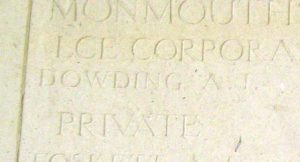
William Downey, Private, 267446, Monmouthshire Regiment. William was born in 1884, the son of John Downey and Elizabeth Hannah Downey (nee Davies), of 82, Worcester Street, Brynmawr. He married Frances Jones at Brynmawr in 1912 and the couple set up home at 280, King Street, Brynmawr. William enlisted into the Brecknockshire Battalion, South Wales Borderers at Brecon on 19 October 1914 and was posted to the newly formed 2/1st Brecknocks. The battalion left Brecon for Dale, in Pembrokeshire in April 1915 to join the Milford Haven garrison, then at the end of 1915 moved to Bedford to join the 68th (2nd Welsh) Division. William embarked for France on 30 July 1916, and was posted to the 2nd Battalion, Monmouthshire Regiment, which was attached to the 29th Division. The Division had suffered terrible casualties at Beaumont Hamel, during its assault on Y-Ravine on 1 July 1916 and, although severely depleted, the Division remained in the line here over the coming weeks, in trying conditions. On 27 July the Division entrained for Flanders, detraining at Proven before relieving the 6th Division at Ypres. The Division held the line here over the coming weeks as it rebuilt its strength and the 2nd Monmouth’s worked hard on improving trenches and digging new communications trenches. The battalion then worked on the Menin Road, erecting elephant shelters, then on 4 October the Division was relieved and entrained south for the Somme once more, moving to Trônes Wood, before joining the latter stages of the Somme offensive. The Division wintered on the Somme, with the 2nd Monmouth’s working on road repairs around Montauban, then at Ginchy, Flers and Morval. The 2nd Monmouth’s moved into reserve at the end of December and moved to Fourdrinoy, where the men trained in infantry assault manoeuvres. On 12 January 1917 the battalion began marching back into the battle area, taking over positions near Morval, and began supplying working parties around Montauban once more. William became ill due to the terrible conditions at the time and was evacuated via the 60th Field Ambulance to the 2/2nd London Casualty Clearing Station. He was then invalided home aboard the Hospital Ship St. Patrick after being diagnosed as suffering from trench fever. After almost four months recuperating, he embarked for France again on 15 June 1917 and was reposted to the 2nd Battalion, Monmouthshire Regiment, which was by now at Ypres. The 29th Division was in support of the 38th (Welsh) Division when it launched its assault on the Pilckem Ridge on 31 July 1917. The 2nd Monmouth’s were then put to work laying a light railway track to connect the old front line to the newly captured positions over the coming days. William was killed whilst carrying out this work on 6 August 1917. The 33-year-old is buried in Bleuet Farm Cemetery, Belgium.
Frederick Edwards, Private, 25609, South Wales Borderers. Frederick was born in 1889, the son of Llewellyn Edwards and Martha Edwards (nee Hughes), of 193, King Street, Brynmawr. He worked as a coal miner hewer prior to the war. Frederick enlisted at Brynmawr into the South Wales Borderers during the spring of 1915 and was drafted to Gallipoli on 25 November 1915, joining the 2nd Battalion, South Wales Borderers, which was attached to 87 Brigade, 29th Division. The division remained here until evacuation to Egypt on 11 January 1916 and then moved to the Western Front on 15 March 1916, taking over positions near Beaumont Hamel. The Division took part in its first major action in France on the opening day of the Somme Offensive on 1 July 1916, suffering terrible casualties and refitted in the Ypres Salient before returning to the Somme to take part in the Battle of Le Transloy, suffering heavy casualties again. In the Spring of 1917 the division fought at the Battle of the Scarpe, which was part of the Arras Offensive, and then moved to Ypres, taking part in the Battle of Langemarck, and also saw further fighting during the remainder of the Passchendaele offensive, before moving to Cambrai. Here the division fought at the Battle of Cambrai in November and December 1917 before moving back to Flanders early in 1918. The German Spring Offensive hit the British on the Somme on 21 March 1918, and hit in Flanders just weeks later, on 9 April. The 29th Division was caught up in desperate fighting as it helped defend Bailleul, suffering terrible casualties once more. Frederick was captured by the Germans during this period and was taken to a POW Camp at Schlitz, in Germany. Frederick took ill whilst in captivity and died at Schlitz on 29 October 1918. The 30-year-old was originally buried at Schlitz Town Cemetery, but in December 1923 his grave was exhumed and he was re-interred in Niederzwehren Cemetery, Kassel, Germany. His brother, Joseph, had died earlier that year after being invalided from the army.
Joseph Edwards, Private, 18004, South Wales Borderers. Joseph was born in 1882, the son of Llewellyn Edwards and Martha Edwards (nee Hughes), of 193, King Street, Brynmawr. He worked as a coal miner hewer prior to the war. Joseph enlisted at Brynmawr into the 5th Battalion, South Wales Borderers on 29 September 1914. The battalion formed at Brecon in September 1914, before moving to Park House Camp, near Tidworth to join 58 Brigade, 19th (Western) Division. In December 1914 the battalion moved to Basingstoke in billets, then on 10 January 1915 became converted to the Pioneer Battalion for the 19th Division. The Division completed its training at Bulford and Perham Down, before embarking for France and landing at Le Havre on 16 July 1915. The entire 19th Division then moved to the Nursery Sector at Calonne for trench initiation alongside the Dehra Dun Brigade. The infantry battalions of the division then began carrying out the usual routines of rotating in the trenches: four days in the front line; four in support; and four in reserve, interspersed with training regimes and carrying out working parties and trench raids. Just south, the British launched a great offensive around the town of Loos on 25 September 1915, and the 19th Division was ordered to attack from its positions at the same time, to attempt to draw enemy attention away from the main battle area. The assault was a disaster, and heavy casualties were suffered by the 19th Division for no gain. The following year the Division moved to the Somme, where it took part in the second wave of the attack on Ovillers-La Boiselle on 1 July, capturing the village at heavy cost. It then fought through the Somme Battles of Pozieres and the Ancre in 1916. Joseph was shot in the arm on 2 February 1917, whilst the division was still on the Somme, and was evacuated back to Britain for treatment. Upon recovering he was posted to Sniggery Camp, but his health began to fail and he reported sick on 25 July, complaining of pains in his hip and right leg. Joseph was treated at the Seaforth Hospital before being transferred to Llandrindod Wells Hospital. He was then transferred to the 3rd Western General Hospital at Cardiff before being discharged from the army as medically unfit due to heart disease on 26 November 1917 and returned home to Brynmawr. His health rapidly declined, and Joseph died of heart disease at home on 12 April 1918. The 36-year-old was buried in Brynmawr Cemetery. His brother, Frederick, died as a POW in Germany later that year.
John Thomas Edwards, Sergeant, 39059, South Wales Borderers. John was born at Tipton, Staffordshire on 27 July 1889, the son of Joseph Edwards and Elizabeth Edwards. John and his brother Joseph moved to Brynmawr as young men to find work as coalminers. John married Eliza Davies on 12 February 1912 and the couple set up home at Eagle Cottage, Beaufort Hill, Beaufort. John enlisted at Brynmawr into the South Wales Borderers and was drafted to France in the Spring of 1917, joining the 1st Battalion, South Wales Borderers, which was attached to 3 Brigade, 1st Division. The Division had followed the German retreat to the Hindenburg Line in early 1917 and was then briefed for an operation on the Flanders Coast, being relieved at the end of May 1917 and by the middle of June had taken over their new positions on the coast. While the Division was holding the line near Coxyde, the Passchendaele offensive was launched on 31 July 1917, but had got bogged down, so at the beginning of November the Division was transferred to Ypres, to join the great push for Passchendaele Ridge. The Division took up positions near Valour Farm, on the lower edge of the ridge, by 9 November and prepared to launch an assault on the following morning. The objectives were a series of ruined farms which had been fortified by the Germans and at dawn on 10 November 1917 the Division launched its assault. The men arose from the trenches and began to advance through thick mud, but the men got caught up in their own artillery barrage. John was killed in action at some time during the day. The 28-year-old has no known grave and is commemorated on the Tyne Cot Memorial, Belgium.
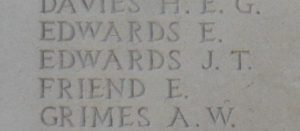
David John Evans, Private, 34235, Suffolk Regiment. David was born in 1883, the son of David C. Evans and Elizabeth Evans (nee Lewis), of 144, Worcester Street, Brynmawr. He had left home by 1911 and was living in Suffolk. David married Mary Elizabeth Gant in 1915 and the couple set up home at Victoria Cottage, Boxford, Suffolk, where their son, David, was born. David enlisted at Bury St. Edmunds into the Suffolk Regiment soon after his marriage. He was drafted out to France in the spring of 1917 and was posted to the 8th Battalion, Suffolk Regiment, which was attached to 53 Brigade, 18th (Eastern) Division. By the time David arrived in France, the division had followed the German Retreat to the Hindenburg Line, and was in the Arras Sector. In May the division took part in the Third Battle of the Scarpe, which was part of the Arras Offensive. The division was relieved in June and moved from the Hindenburg line, carrying out a training scheme at Souastre before entraining for Cassel and marching to billets around Steenvoorde. By the end of the month the division had taken up positions in the Ypres Salient and took part in the Battle of Pilckem, where it helped capture Westhoek. The division then saw further fighting at the Battle of Langemarck, before enjoying a brief rest period then by 9 October began moving back into the battle zone, crossing the canal at Boesinghe and took over positions near Poelcapelle. David was wounded here soon after the move and was evacuated to the Casualty Clearing Station at Dozinghem, where he died of his wounds on 14 October 1917. The 34-year-old is buried in Dozinghem Military Cemetery, Belgium. David is not commemorated on the Brynmawr Cenotaph.
John William Gardner, Private, 7080, South Wales Borderers. John was born at Abergavenny on 14 July 1884, the son of Robert Gardner and Martha Gardner (nee Lawrence). He married Sarah Ann Wilson on 27 December 1909 and the couple set up home at 8, Glamorgan Square, Brynmawr. He worked as a coal miner hewer prior to the war and had previously served in the army, so was on the Army Reserve. As a reservist, John was mobilised as soon as war erupted and was posted to the 1st Battalion, South Wales Borderers. He embarked for France with the battalion and disembarked at Le Havre on 13 August 1914. The battalion was attached to 3 Brigade, 1st Division and entrained for the Belgian frontier, near the town of Mons. The Division then took part in the Battle of Mons on 23 August, following the German invasion of the low countries, and in the epic withdrawal from Mons to the River Marne, where the German drive on Paris was halted. The Germans then withdrew north and took up defensive positions north of the River Aisne, along the Chemin des Dames Ridge and the BEF advanced before launching a frontal attack upon the German positions. The battle ended in a stalemate and both sides dug-in, beginning the line of trenches which was to become known as the Western Front. John was killed in action near Vendresse on 26 September 1914, during a day of such severe fighting that the battalion war diary states: ‘The most ghastly day of my life, and yet one of the proudest because my regiment did its job and held on against heavy odds.’ The 30-year-old has no known grave and is commemorated on the La Ferté-Sous-Jouarre Memorial, France.
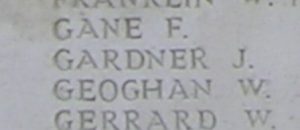
John Henry Gibbon, Driver, 161255, Royal Engineers. John was born in 1892, the son of John Gibbon and Ruth Gibbon (nee Jones), of 151, king Street, Brynmawr. He married Amy Elizabeth Powell on 31 January 1914 and the couple set up home at 4, Queen Square, Brynmawr. John worked as an assurance agent prior to enlisting at Newport into the Royal Engineers on 29 November 1915 and was posted to the Depot at Chatham for training. John then embarked at Southampton on 27 April 1917, disembarking at Alexandria on 23 May and was initially posted from the Depot at Alexandria to the 3rd Signal Squadron, Royal Engineers. On 3 October 1918 John was posted to the 4th Cavalry Division Signal Squadron, but within days he became ill and was sent to the 17th General Hospital at Alexandria. John died there of malaria on 17 October 1918. The 26-year-old is buried in Alexandria (Hadra) War Memorial Cemetery, Egypt.
George Golding-Hann, Private, 54208, Royal Welsh Fusiliers. George was born in Kerridge, Cheshire in 1879, the son of George Golding Hann and Sarah Ann Golding Hann (nee Eyres). The family had moved to 2, Sychfos Row, Ebbw Vale by 1884. George found work as a coal miner after leaving school. He married Esther Ann Whitcombe in 1901 and the couple resided at 18, Mount Pleasant Square until her premature death in 1910. He then remarried to Florence Rosina Cordingley in 1911 and the couple lived at 7, Dumphries Place, Brynmawr. George enlisted at Abergavenny into the Monmouthshire Regiment early in 1915. He was drafted to France in the summer of 1916 and posted to the 9th Battalion, Royal Welsh Fusiliers, which was attached to 58 Brigade, 19th (Western) Division. The Division had wintered on the Somme and in February followed the German withdrawal to the Hindenburg Line. During the middle of March 1917 the Division was relieved from the line and began to move north, taking over positions in the Ypres Salient, and on 7 June took part in the assault on Messines Ridge, which was famously preceded by the blowing of a series of 19 huge underground mines. The division attained its objectives before digging into the Black Line, and remained here over the coming days, consolidating its gains. George was killed in action here on 13 June 1917. The 37-year-old is buried in Klein-Vierstraat British Cemetery, Belgium. His younger brother, Frank, of Ebbw Vale, was killed in France in 1918.
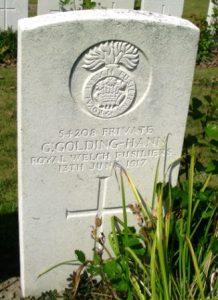
David Gore, Private, T4/216043, Royal Army Service Corps. David was born in 1886, the son of William Gore and Mary Gore (nee Williams), of 7, Cross Street, Brynmawr. He married Elizabeth May Colbourne on 26 July 1905 and the couple took over the running of the Belle Vue Inn at Brynmawr. David enlisted into the Army Service Corps on 25 August 1916 and was posted to Aldershot for training. David was then posted to Bulford Camp, before embarking at Devonport on 25 September 1916 for the Middle East, disembarking at Basra on 6 November. He was then posted from the MT Base Depot to the 724th Motor Transport Company, Royal Army Service Corps. David took ill after almost twelve months service in what was then called Mesopotamia and was hospitalised at the Isolation Hospital at Baghdad, where he died of cirrhosis on 8 December 1917. The 31-year-old is buried in Amara War Cemetery, Iraq.
Thomas John Gray, Private, 2558, Monmouthshire Regiment. Thomas was born in 1886, the son of Thomas Gray and Elizabeth Gray (nee Morgan), of 13, North Street, Beaufort. He moved to Brynmawr as a young man after gaining work there as a collier, and on 4 June 1906 married Joyce Vaughan, before the couple set up home together at 5, Brook Street, Brynmawr. Thomas enlisted at Abergavenny into the 1/3rd Battalion, Monmouthshire Regiment soon after the outbreak of war. The battalion mobilised at Abergavenny attached to the Welsh Border Brigade, Welsh Division, before moving to Pembroke Dock. On 10 August 1914 the Division moved to Oswestry before moving to Northampton, then spent Christmas at Bury St. Edmunds before moving to Cambridge. In February 1915 the 3rd Monmouth’s left the Welsh Division and landed in France on 14 February, before moving to the Ypres Salient. On 3 March 1915 the battalion joined 83 Brigade, 28th Division. On 8 April the 3rd Monmouth’s relieved a French Division in the sector east of the Polygon Wood to begin its first tour in the trenches. The battalion was relieved four days later, and marched to billets in Ypres, then on 17 April relieved the 5th King’s Own in the front line, to begin a spell which would last for 17 days without relief. On 22 April, just to the north, the Germans launched the first gas attack of the war upon French Colonial troops at Gravenstafel, heralding the opening of the Second Battle of Ypres. The fighting remained to the north of Polygon Wood until 3 May, when the Germans widened their attacks and the Polygon Wood sector was evacuated by the 28th Division, which fell back on the G.H.Q. line at Potijze. Over the coming days their new positions were shelled mercilessly, then on 8 May the Germans attacked. Despite heavy losses the Division held firm and later that day three Companies of the 3rd Monmouth’s moved back into billets at Vlamertinghe, leaving B Company in the line. By now casualties had become so severe that on 10 May a Composite Battalion was formed from remnants of 83 Brigade, under Lt Col Gough, and proceeded to the G.H.Q. line at Potijze. Over the coming days their new positions were shelled mercilessly, then on 8 May the Germans attacked. Despite heavy losses the Division held firm and later that day three Companies of the 3rd Monmouth’s moved back into billets at Vlamertinghe, leaving B Company in the line. By now casualties had become so severe that on 10 May a Composite Battalion was formed from remnants of 83 Brigade, under Lt Col Gough, and proceeded to the G.H.Q. line at Potijze. During the coming weeks, all three battalions of the Monmouth’s, which were all at Ypres, suffered such heavy losses that on 27 May they were merged together at Vlamertinghe in 84 Brigade, 28th Division. On 11 August 1915 the individual battalions resumed identity and the 3rd Monmouth’s re-joined 83 Brigade, before becoming the Pioneer Battalion to the 49th (West Riding) Division in September 1915. On 5 September the 3rd Monmouth’s moved to the Elverdinghe Chateau grounds and began work on trench improvements, road repairs and dugouts. Thomas was killed here whilst on a working party improving drainage in the area on 9 November 1915. The 29-year-old is buried in Bard Cottage Cemetery, Belgium.
Thomas Charles Griffiths, Private, 14927, South Wales Borderers. Thomas was born in 1873, the son of Thomas Griffiths and Elizabeth Griffiths (nee Rees), of 15, Worcester Buildings, Brynmawr. He married Martha Maggs in 1898 and the couple set up home at 81, Bailey Street, before moving to 50, Harwick Road, Brynmawr. Thomas worked as a coal miner prior to enlisting at Brynmawr into the South Wales Borderers soon after the outbreak of war. He was drafted to France on 2 May 1915 and was posted to the 1st Battalion, South Wales Borderers, which was in positions north-east of Bethune, near Richebourg attached to 3 Brigade, 1st Division. The 1st Division took part in its first major action of 1915 here on 9 May 1915, during the Battle of Aubers Ridge, when it attacked alongside the Meerut Division. The attack of the 2nd Welsh was held up by a flooded ditch, which the men forded, before being hit by heavy machine-gun fire, and a large number of casualties were suffered before the survivors withdrew. After the battle of Aubers, 3 Brigade took over a section of old French trenches, where it received drafts of reinforcements. On 20 May, the division was moved to the Cuinchy area, where it endured a great deal of bombing and rifle grenading, then at the latter end of June the Battalion moved to the Vermelles area, in preparation for the battle of Loos. The Battle of Loos was launched on 25 September 1915, following the release of large quantities of poison gas by the British. 3 Brigade moved off with the 2nd Munster’s on the right, the 2nd Welsh in echelon, to their left, and the 1st SWB in support. The gas had blown back over the British lines, so conditions during the advance were horrendous, then whilst advancing past the Vermelles-Hulluch Road the Brigade came under heavy machine-gun fire. Thomas was killed during heavy fighting on the following day, 26 September 1915. The 42-year-old has no known grave and is commemorated on the Loos Memorial, France.
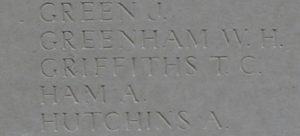
Frederick Grist, Private, 1518, Monmouthshire Regiment. Frederick was born in 1893, the son of Albert Edward Grist and Hannah Elizabeth Grist (nee Hoffman), of 5, Davies Street, Brynmawr. He worked as a coal miner prior to enlisting at Abergavenny into the 1/3rd Battalion, Monmouthshire Regiment soon after the outbreak of war. The battalion mobilised at Abergavenny attached to the Welsh Border Brigade, Welsh Division, before moving to Pembroke Dock. On 10 August 1914 the Division moved to Oswestry before moving to Northampton, then spent Christmas at Bury St. Edmunds before moving to Cambridge. In February 1915 the 3rd Monmouth’s left the Welsh Division and landed in France on 14 February, before moving to the Ypres Salient. On 3 March 1915 the battalion joined 83 Brigade, 28th Division. On 8 April the 3rd Monmouth’s relieved a French Division in the sector east of the Polygon Wood to begin its first tour in the trenches. The battalion was relieved four days later, and marched to billets in Ypres, then on 17 April relieved the 5th King’s Own in the front line, to begin a spell which would last for 17 days without relief. On 22 April, just to the north, the Germans launched the first gas attack of the war upon French Colonial troops at Gravenstafel, heralding the opening of the Second Battle of Ypres. The fighting remained to the north of Polygon Wood until 3 May, when the Germans widened their attacks and the Polygon Wood sector was evacuated by the 28th Division, which fell back on the G.H.Q. line at Potijze. Over the coming days their new positions were shelled mercilessly, then on 8 May the Germans attacked. Despite heavy losses the Division held firm and later that day three Companies of the 3rd Monmouth’s moved back into billets at Vlamertinghe, leaving B Company in the line. By now casualties had become so severe that on 10 May a Composite Battalion was formed from remnants of 83 Brigade, under Lt Col Gough, and proceeded to the G.H.Q. line at Potijze. Over the coming days their new positions were shelled mercilessly, then on 8 May the Germans attacked. Despite heavy losses the Division held firm and later that day three Companies of the 3rd Monmouth’s moved back into billets at Vlamertinghe, leaving B Company in the line. By now casualties had become so severe that on 10 May a Composite Battalion was formed from remnants of 83 Brigade, under Lt Col Gough, and proceeded to the G.H.Q. line at Potijze. During the coming weeks, all three battalions of the Monmouth’s, which were all at Ypres, suffered such heavy losses that on 27 May they were amalgamated together at Vlamertinghe in 84 Brigade, 28th Division. Frederick was killed in action on 26 June 1915, just after the amalgamated battalion moved into the line at Ridge Wood to begin a routine tour. The 22-year-old has no known grave and is commemorated on the Ypres (Menin Gate) Memorial, Belgium.
Moses Harding, Private, 30618, Welsh Regiment. Moses was born in 1885, the son of William Harding and Mary Harding (nee Arthurs), of Clydach Bridge, Brynmawr. He married Elizabeth Rhydderch on 3 February 1908 and the couple set up home at 6, Cemetery Road, Brynmawr. Moses worked as a coal miner hewer prior to enlisting at Brynmawr into the South Wales Borderers on 30 September 1914. He was discharged as medically unfit on 5 November 1914, but undeterred, re-enlisted into the Welsh Regiment and was drafted to France on 6 July 1915, joining the 1st Battalion, Welsh Regiment, which was at Dranoutre, attached to 84 Brigade, 28th Division. The Battalion had been seconded to the 5th Division, but within days of Richard’s arrival, moved to Ypres to re-join the 28th Division. The Division was holding a section of front line running from Wytschaete to the Ypres to Zandvoorde road. On 17 April the 1st Welsh marched up to relieve the 5th Fusiliers at Broodseinde, just beyond Zonnebeke, on the extreme point of the Ypres Salient. On 22 April the Germans launched a poison gas attack at Gravenstafel, the first such attack of the war, and broke the line which was being held by a French Colonial Division. The Canadians rushed in to plug the gap, but this heralded the opening phase of the Second Battle of Ypres and soon afterwards the 1st Welsh became dragged into the terrible fighting, suffering heavy casualties over the coming days. Following serious casualties at Ypres, a Composite Brigade was formed, composing of the 2nd Buffs, 2nd Cheshire’s, 1st Welsh, and the 1st York and Lancaster’s. It was dissolved on 19 May 1915, and the formation assumed its normal configuration, before moving south to join the Battle of Loos, which had opened on 25 September 1915. The 1st Welsh entered the fray on 29 September, taking up support positions at Vermelles, near where the 2nd Welsh had been almost wiped out days earlier. Two days later the 1st Welsh moved into the front-line and prepared to launch an assault on Little Willie trench. The battalion attacked at dawn on 1 October and became caught up in desperate fighting over the coming days. Moses was killed in action here on 2 October 1915. The 30-year-old has no known grave and is commemorated on the Loos Memorial, France.
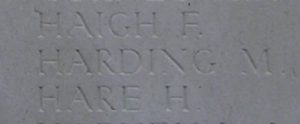
Walter James Harris, Corporal, 266162, Monmouthshire Regiment. Walter was born in 1894, the son of Thomas Harris and Paulina Harris (nee Lucas), of 20, King Edward Road, Brynmawr. He worked as a shop assistant prior to enlisting at Pontypool into the 2nd Battalion, Monmouthshire Regiment on 3 December 1915. Walter was posted to the 3/2nd Monmouth’s, a reserve battalion, which was stationed near Oswestry, at Gobowen. Walter served with the reserve battalion for over two years, but ill health and two spells in hospital prevented him from being drafted overseas to fight. It was this ill health that led to him being discharged from the army as medically unfit on 5 February 1918 and he returned home to Brynmawr after having been found to have a tumour. Walter died of cancer at home on 20 July 1918, aged 23. He is not commemorated as a war casualty by the CWGC.
Robert John Hayes, Private, 17516, Royal Welsh Fusiliers. Robert was born in 1887, the son of Edward Hayes and Catherine Ann Hayes, of Brynmawr. His parents died when he was young, so Robert was adopted by Robert and Mary Cunningham and was raised by them at 19, Boundary Street, Brynmawr. Robert married Rosa Jane Larkin in 1911 and the couple set up home with his foster parents at 19, Boundary Street. Robert worked as a coal hewer prior to enlisting at Newport into the Royal Welsh Fusiliers soon after the outbreak of war. He embarked for France on 25 May 1915 and was posted to the 1st Battalion, Royal Welsh Fusiliers, which was in Flanders attached to 22 Brigade, 7th Division. The battalion was in the process of rebuilding following heavy losses at the Battles of Neuve Chapelle, Festubert and at Aubers Ridge, which had just closed when Robert arrived. The 1st RWF spent the coming weeks billeted behind the lines, before moving back into support positions by 7 June. The divisions next major action was in the Battle of Loos, which opened on 25 September 1915. The Division moved to Vermelles that morning and took part in the initial assault north of the Vermelles-Hulluch road, facing the Quarries and a series of strong-points. Suffering badly from British gas, which had blown back across the British lines, the division was badly cut up by German machine gun fire and artillery, but nonetheless seized the Quarries and only failed to penetrate the third German line due to the relative weakness of the numbers of men that got through. The 1st RWF alone suffered over 400 casualties during the day but was not relieved until three days later. On 1 October the battalion took over the line at Cambrin and enjoyed a relatively peaceful three days there before being relieved and moved into billets at Le Preol. On 7 October 1915 the battalion moved back into the line east of the La Bassée canal at Cuinchy to begin another tour. Robert was killed in action on that day, 7 October 1915. The 28-year-old has no known grave and is commemorated on the Loos Memorial, France. Robert is not commemorated on the Brynmawr Cenotaph.
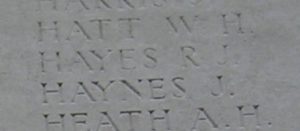
Alfred James Herbert, Staff Sergeant, 25540, Royal Army Medical Corps. Alfred was born in 1876, the son of Edwin Herbert and Mary Ann Herbert (nee Millard), of 169, King Street, Brynmawr. He married Sarah Jane Latcham in Bristol in 1900, and after several moves over the coming years, settled with her and their two sons at 13, Factory Road, Brynmawr. Alfred enlisted into the Royal Army Medical Corps on 2 September 1914 and was drafted to France on 19 December 1915. He served throughout the entire war, but after the Armistice his health began to deteriorate and Alfred was discharged from the army as medically unfit on 6 June 1919, returning home to Brynmawr. He was granted a pension, due to suffering from chronic inflammation of the stomach, as a result of active service. Alfred died of stomach cancer at Brynmawr on 31 March 1921, aged 45. He is not commemorated as a war casualty by the CWGC.
Philip George Herbert Howells, Second Lieutenant, North Staffordshire Regiment. Philip was born at Burton-on-Trent in 1897, the son of Phillip Henry Howells and Blanche Howells (nee Weeks). His mother was from Brynmawr, and by 1911 the family had moved back to her native home, to 16, Alma Street, Brynmawr. Philip was educated at Aberystwyth University where he became a member of the OTC, and before graduating enlisted into the army and was commissioned as Second Lieutenant into the 10th Battalion, North Staffordshire Regiment on 27 September 1915, joining the battalion at Darlington. In November 1915 the battalion moved to Rugeley, Cannock Chase to join the 1st Reserve Brigade. Philip was drafted to France on 3 September 1916, joining the 8th Battalion, North Staffordshire Regiment, which was in positions near Dranoutre, refitting following heavy losses on the Somme, and was attached to 57 Brigade, 19th (Western) Division. At the beginning of October the division, now fully rebuilt, moved back to the Somme sector, to take part in the latter phases of the Somme offensive, and by 20 October had reached Albert. The 8th North Staffs moved into the Stuff Redoubt trenches on 24 October and were not relieved until 1 November. The battalion had a relatively quiet next few weeks, before entering the line at Regina Trench on 18 November 1916 and launched an assault upon Desire Trench. Conditions were terrible, with fresh snow covering the ground, and the battalion suffered severe casualties before the survivors withdrew back to their own lines. Philip was posted as missing during the fighting that day and was later deemed to have been killed in action. The 20-year-old is buried in Grandcourt Road Cemetery, Grandcourt, France.
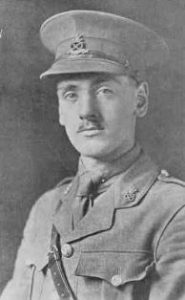
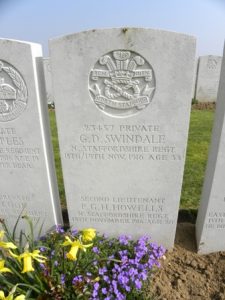
Ewart Huggins, Private, 36238, Welsh Regiment. Ewart was born in 1888, the son of Jacob Huggins and Isabella Ann Huggins (nee Carey), of 5, Dumfries Place, Brynmawr. He worked as a collier prior to the war. Ewart had enlisted into the Brecknockshire Battalion, South Wales Borderers at Brynmawr on 4 May 1908, soon after the formation of the Territorial Force and had attended the annual TA summer camp every year without fail, at Brecon; Porthcawl; Aberystwyth; and at Hereford, before being discharged in May 1913. Following the outbreak of war he enlisted into the Welsh Regiment. Ewart was drafted to France on 5 May 1915, joining the 1st Battalion, Welsh Regiment, which was in Flanders, attached to 84 Brigade, 28th Division. The division was in the process of rebuilding following heavy losses during the Second Battle of Ypres which had seen such terrible casualties that a Composite Brigade was formed, composing of the 2nd Buffs, 2nd Cheshire’s, 1st Welsh, and the 1st York and Lancaster’s. It was dissolved on 19 May 1915, and the formation assumed its normal configuration, before moving south to join the Battle of Loos, which had opened on 25 September 1915. The 1st Welsh entered the fray on 29 September, taking up support positions at Vermelles, near where the 2nd Welsh had been almost wiped out days earlier. Two days later the 1st Welsh moved into the front-line and prepared to launch an assault on Little Willie trench. The battalion attacked at dawn on 1 October and became caught up in desperate fighting over the coming days. Ewart was seriously wounded during the initial advance and was evacuated to the 33rd Casualty Clearing Station at Bethune, where he died of his wounds on the following day, 2 October 1915. The 27-year-old is buried in Bethune Town Cemetery, France.
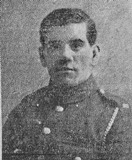
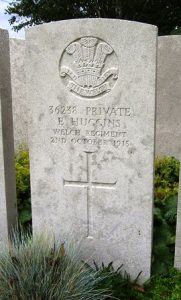
Hugh Arthur Hughes, Private, B/20193, Royal Fusiliers. Hugh was born in 1888, the son of John Henry Hughes and Elizabeth Hughes (nee Evans), of Tyddyngyrfa, Anglesey. He came to South Wales to work as a Bank Clerk for the London City and Midland Bank at Brynmawr prior to the war and lodged at 4, Beaufort Buildings, Brynmawr. Hugh enlisted at Wrexham into the 26th (Bankers) Battalion, Royal Fusiliers soon after the outbreak of war. The battalion was raised by the Lord Mayor and City of London in July 1915 from Bank Clerks and Accountants, then moved to Marlow before moving to Aldershot to join 124 Brigade, 41st Division. Hugh married Charlotte Hannah Williams, a schoolteacher from Brynmawr, at Aldershot whilst on leave on 2 February 1916. He embarked for France with the battalion on 4 April 1916 and the entire division moved to Flanders, to begin familiarisation with trench warfare in the areas of Ploegsteert and the Douve valley, south of Ypres. The division remained here until August 1916, when it moved to the Somme, and took part in the Battle of Flers-Courcelette from 15 September, the first time that tanks were ever used in action. The Division remained in the line throughout the duration of the battle, pushing on to Courcelette before coming out for a rest and re-fit. The division began moving back into the line by 2 October, to take part in the Battle of Le Transloy, taking over positions in Gird Support and Gird Trench, near Flers. Hugh was killed in action when the battalions positions were hit by German artillery fire on 4 October 1916. The 28-year-old is buried in A.I.F. Burial Ground, Flers, France.
William James, Private, 29112, South Wales Borderers. William was born in 1896, the son of William James and Sarah Jane James (nee Lewis), of 190, King Street, Brynmawr. He worked in his parents Grocers Shop prior to enlisting at Brynmawr into the South Wales Borderers. William was drafted to France in the early summer of 1917 and was posted to the 2nd South Wales Borderers, which was attached to 87 Brigade, 29th Division. The battalion had suffered heavy casualties during the Battle of Arras prior to William’s arrival, and refitted before moving to the Ypres Salient. It was in support of the 38th (Welsh) Divisions assault on the Pilckem Ridge on the opening day of the Third Battle of Ypres, then on the night of 14-15 August the 2nd SWB moved into the line facing Langemarck, ready to launch another offensive. On the following day the battalion reconnoitred the ground in front of them, and laid white tapes in No Man’s Land, to guide the attacking troops, and at dawn on 16 August 1917 the 2nd SWB launched an attack on Langemarck. The battalion successfully took its two objectives, but had suffered 163 casualties. The Division then had another period out of the line to rest and refit before taking part in further fighting near Poelcapelle. Early in November 1917 the Division was relieved from the line at Ypres, and moved south to the Bellacourt area, to prepare to take part in the forthcoming Battle of Cambrai. The Division entrained for Péronne on 17 November, marching to a camp four miles out of the town at Haut Allaines, then by midnight on 18 November had reached Fins. On the following day the Division received its battle stores and detailed orders for the forthcoming battle, marching off via Gouzeaucourt to its assembly positions at Marcoing. The assault began at dawn on 20 November, but the Division suffered terrible casualties whilst attacking Masnières, on the Hindenburg Line. The Germans launched a counterattack on 30 November and drove in the British lines, retaking most of the gains that the British had fought so hard for. The 2nd SWB, by now in trenches at Marcoing, moved forward into defensive positions around a bridgehead on the canal and received news that the Germans had broken to on their right flank. The battalion was then hit hard and over the coming days took part in a desperate defensive action, before being relieved on 3 December 1917. William was reported as missing just after the relief that day and was later deemed to have been killed in action. The 21-year-old has no known grave and is commemorated on the Cambrai Memorial, Louverval, France.
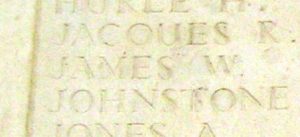
Jack Ronald Jenkins, Private, 2632, Monmouthshire Regiment. Jack was born in 1895, the son of Meyrick Jenkins and Mary Elizabeth Jenkins (nee Smith), of Garland Terrace, Llanfrechfa. His mother was from Brynmawr, and Jack was a regular visitor to family there even before his parents moved to Swindon, where his father worked for the Great Western Railway. Jack remained in Brynmawr, but left the town to enlist at Abergavenny into the 3rd Battalion, Monmouthshire Regiment soon after the outbreak of war. The battalion mobilised at Abergavenny attached to the Welsh Border Brigade, Welsh Division, before moving to Pembroke Dock. On 10 August 1914 the Division moved to Oswestry before moving to Northampton, then spent Christmas at Bury St. Edmunds before moving to Cambridge. In February 1915 the 3rd Monmouth’s left the Welsh Division and landed in France on 14 February, before moving to the Ypres Salient. On 3 March 1915 the battalion joined 83 Brigade, 28th Division. On 8 April the 3rd Monmouth’s relieved a French Division in the sector east of the Polygon Wood to begin its first tour in the trenches. The battalion was relieved four days later, and marched to billets in Ypres, then on 17 April relieved the 5th King’s Own in the front line, to begin a spell which would last for 17 days without relief. On 22 April, just to the north, the Germans launched the first gas attack of the war upon French Colonial troops at Gravenstafel, heralding the opening of the Second Battle of Ypres. The fighting remained to the north of Polygon Wood until 3 May, when the Germans widened their attacks and the Polygon Wood sector was evacuated by the 28th Division, which fell back on the G.H.Q. line at Potijze. Over the coming days their new positions were shelled mercilessly, and heavy casualties were suffered. Jack was killed in action here on 8 May 1915. The 19-year-old has no known grave and is commemorated on the Ypres (Menin Gate) Memorial, Belgium.
John Owen Jones, Lance Corporal, G/67398, London Regiment. John was the son of Philip and Margaret Jones, of Rhayader. He married Edith Evelyn Fowler, of Brynmawr, on 25 February 1907, and the couple set up home at 6, Dumphries Place, Brynmawr, where their two daughters were born. John enlisted into the Army Service Corps at Cardiff, but after completing his training was transferred to the 2/2nd Battalion, London Regiment (Royal Fusiliers), which was attached to 169 Brigade, 56th (London) Division. The Division moved to the Somme and fought at the diversionary attack on Gommecourt then at Ginchy, Flers and Morval, where it captured Combles. The Division wintered on the Somme, and followed the German retreat to the Hindenburg Line in March 1917 before fighting in the Battle of Arras. It then moved to Ypres, where they fought at Langemarck, then moved south and fought at the Battle of Cambrai in October 1917, remaining in the area for the winter, in positions near Bancourt, before moving to the Gavrelle sector in mid-February 1918. By 18 March 1918 it had become obvious that the Germans were preparing to launch an offensive, then at dawn on 21 March 1918 a massive artillery bombardment, along the section of front running from Croisilles to La Fère, broke the silence, hammering the British front and support lines. The bombardment was following by a wave of German shock troops, which hit the line, and ferocious, desperate, fighting erupted. The 56th Division, holding the Gavrelle sector, was hit hard, suffering severe casualties over the coming days. John was killed in action during the opening day of the offensive, 21 March 1918. The 33-year-old is buried in Chauny Communal Cemetery British Extension, France. John is not commemorated on the Brynmawr Cenotaph.
Lewis Jones, Private, 267477, Monmouthshire Regiment. Lewis was born in about 1884. His parents died when he was young and Lewis lived with his sister, Mary Ann Jones, at 48, Somerset Street, Brynmawr. He enlisted at Brynmawr into the Brecknockshire Battalion, South Wales Borderers on 12 October 1914 and was posted to the 2/1st Brecknockshire Battalion, which had formed at Brecon the previous month. The battalion left Brecon for Dale, in Pembrokeshire in April 1915 to join the Milford Haven garrison, then at the end of 1915 moved to Bedford to join the 68th (2nd Welsh) Division. Lewis embarked for France on 30 July 1916 and was posted from the Infantry Base Depot to the 1/2nd Battalion, Monmouthshire Regiment, which was the Divisional Pioneer Battalion to the 29th Division. The Division had suffered terrible casualties at Beaumont Hamel, during its assault on Y-Ravine on 1 July 1916 and, although severely depleted, the Division remained in the line here over the coming weeks, in trying conditions. On 27 July the Division entrained for Flanders, detraining at Proven before relieving the 6th Division at Ypres. The Division held the line here over the coming weeks as it rebuilt its strength and the 2nd Monmouth’s worked hard on improving trenches and digging new communications trenches. The battalion then worked on the Menin Road, erecting elephant shelters, then on 4 October the Division was relieved and entrained south for the Somme once more, moving to Trônes Wood, before joining the latter stages of the Somme offensive. The Division wintered on the Somme, with the 2nd Monmouth’s working on road repairs around Montauban, then at Ginchy, Flers and Morval. The 2nd Monmouth’s moved into reserve at the end of December and moved to Fourdrinoy, where the men trained in infantry assault manoeuvres. On 12 January 1917 the battalion began marching back into the battle area, taking over positions near Morval, and began supplying working parties around Montauban once more. The Division wintered on the Somme, taking part in the advance which followed the German withdrawal to the Hindenburg Line. At the beginning of April, the entire 29th Division moved out of the Somme sector to the Arras sector, and by 9 April took over a section of the line facing Monchy-le-Preux. The Division then began to prepare for the forthcoming Battle of Arras. At dawn on 23 April 1917, the Division launched an assault on Monchy-le-Preux. The division captured the front-line German trench and advanced some 300 yards beyond before consolidating its gains. After several more weeks fighting at Arras, the division moved further north to Ypres, initially to hold the line whilst other units had been withdrawn for specialist training, in readiness for the Third Battle of Ypres, which was to open on 31 July 1917. The 2nd Monmouth’s then began work improving the Canal Bank defences and Bard Causeway. Lewis was wounded when the Germans opened up an artillery barrage upon the Canal Bank on 10 July and was evacuated to the 88th Field Ambulance, where he died of his wounds on 11 July 1917. The 33-year-old was buried in Canada Farm Cemetery, Belgium.
Sydney Jones, Private, 58651, South Wales Borderers. Sydney was born on 30 January 1898, the son of John Jones and Rose Jones, of 14, Boundary Street, Brynmawr. His father died when he was a young boy and his mother remarried to Charles Davies. Sydney worked as a coal miner prior to enlisting at Brecon into the army and was drafted to France in the spring of 1918, joining the 10th Battalion, South Wales Borderers, which was attached to 115 Brigade, 38th (Welsh) Division. The Division had wintered in the Sailly-sur-la-Lys sector, and remained in the area over the winter before being moved to positions north of Albert, at Bouzincourt Ridge, at the end of March 1918, relieving the battered 2nd and 47th Divisions. It held this sector, again carrying out minor operations and trench raids, over the coming months, before taking part in the great offensive of 21 August 1918, and began its advance towards the Hindenburg Line. Over the coming days the division recaptured the old Somme battlefields of 1916 whilst heading towards the Hindenburg Line. Henry joined the 15th Welsh near Gouzeaucourt, just after its part in the capture of the heavily defended town, following a successful assault on Gauche Wood. The battalion then had a short spell in reserve north of Equancourt before moving to positions at Lechelles, a small village slightly north of Equancourt, and west of Havrincourt Wood. The Allies were by now in striking range of the Hindenburg Line and the 38th Division was put into reserve whilst the Australians and Americans assaulted the Hindenburg Line in their sector, near Bony. Following the breaching of the line on 29 September the 38th Division advanced through their tired Allies and continued the offensive, tasked with the clearing of Mortho Wood and the capture of Villers-Outréaux, both of which fell on 8 October after terrible fighting. The division maintained its advance over the coming days, advancing past Le Cateau and on 17 October launched an assault across the River Selle, before advancing to the village of Forest. Sydney was wounded when Forest was bombarded with gas shells on 28 October and died on the following day, 29 October 1918. The 20-year-old is buried in Forest Communal Cemetery, France.
James Joynson, Private, 37007, South Wales Borderers. James was born in 1894, the son of William Joynson and Elizabeth Joynson (nee Jones), of 10, Sunny Bank, Brynmawr. He worked as an assistant for a fish dealer prior to enlisting at Brynmawr into the South Wales Borderers in 1916. James was drafted to France late in 1916, joining the 11th Battalion, South Wales Borderers, which was attached to 115 Brigade, 38th (Welsh) Division. James probably joined the battalion after the division had been relieved following its assault on Mametz Wood in July. It then took over a section of the front at Hébuterne before moving to the Ypres Salient and taking over the Canal Bank sector at Boesinghe. The infantry battalions of the Division then began carrying out the normal pattern of rotation in the trenches, four days in the front, four in support and four in reserve, whilst also working on trench improvement, digging new trenches, and carrying out regular patrols and trench raids. On 31 July 1917 the Division launched its famous assault on the Pilckem Ridge, capturing Iron Cross and reaching its objective of the Steenbeek. James was killed in action during the assault that day. The 22-year-old has no known grave and is commemorated on the Ypres (Menin Gate) Memorial, Belgium.
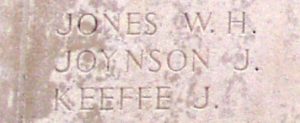
William Alfred Kelson, Gunner, 931264, Royal Field Artillery. William was born in 1892, the son of Henry Kelson and Annie Kelson (nee Price), of 29, Intermediate Road, Brynmawr. His mother died in 1900 and his father remarried to Martha Thomas in 1905, his third wife. William worked as a colliery overman prior to moving to Swansea to become an outfitter’s assistant and lodged at 1, The Promenade, Mumbles. He enlisted at Swansea into the 3/1st (Welsh) Howitzer Battery, Royal Field Artillery on 6 September 1915, being posted to their Depot for training. William was not drafted to France until 18 February 1918, when he was posted to the 317th Brigade, Royal Field Artillery. He had been in France less than a month when he suffered a badly lacerated finger when his hand got jammed in the breech of an 18-pounder field gun, and was evacuated to the 149th Field Ambulance, before being sent to the 3rd General Hospital at Le Treport. He returned to England aboard the Hospital Ship Antrim and after further medical treatment was posted to the Depot at Ripon, before embarking again for France on 2 September 1918, joining D Battery, 83rd Brigade, Royal Field Artillery. The battery was attached to the 18th (Eastern) Division and was in the process of crossing the old Somme battlefields of 1916, having taken part in the great Allied offensive which had launched on 21 August. William joined his new battery at Montauban, where it was resting prior to re-joining the offensive along the Somme canal. By the end of the month the division had reached the outer Hindenburg Line positions around Vendhuile and once the line had been smashed on 29 September, joined the great advance, reaching Le Catelet within days. The division saw heavy fighting around Villers Outréaux before continuing its advance and had reached Le Cateau by 17 October. William’s battery was in action, supporting another assault by the division, on 23 October 1918 when he was killed by German counter-battery fire. The 26-year-old is buried in Le Cateau Military Cemetery, France.
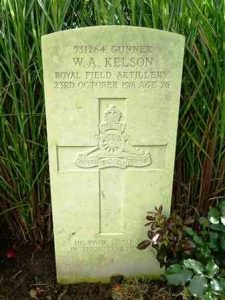
Arthur Lewis, Private, 1281, Monmouthshire Regiment. Arthur was born in 1887, the son of George Lewis and Selina Lewis (nee Clements), of 96, Worcester Street, Brynmawr. The family had moved to 283, King Street, Brynmawr by 1911 and Arthur was working as a coal hewer. He enlisted at Brynmawr into the 1.3rd Battalion, Monmouthshire Regiment soon after the outbreak of war. The battalion mobilised at Abergavenny attached to the Welsh Border Brigade, Welsh Division, before moving to Pembroke Dock. On 10 August 1914 the Division moved to Oswestry before moving to Northampton, then spent Christmas at Bury St. Edmunds before moving to Cambridge. In February 1915 the 3rd Monmouth’s left the Welsh Division and landed in France on 14 February, before moving to the Ypres Salient. On 3 March 1915 the battalion joined 83 Brigade, 28th Division. On 8 April the 3rd Monmouth’s relieved a French Division in the sector east of the Polygon Wood to begin its first tour in the trenches. The battalion was relieved four days later, and marched to billets in Ypres, then on 17 April relieved the 5th King’s Own in the front line, to begin a spell which would last for 17 days without relief. On 22 April, just to the north, the Germans launched the first gas attack of the war upon French Colonial troops at Gravenstafel, heralding the opening of the Second Battle of Ypres. Arthur was killed in action on 2 May 1915, on the day prior to the Germans attacking Polygon Wood. The 27-year-old has no known grave and is commemorated on the Ypres (Menin Gate) Memorial, Belgium.
Idris James Lewis, Sapper, 574582, Royal Engineers. Idris was born in 1891, the son of Thomas Roderick Lewis and Ann Lewis (nee Davies), of 55, Worcester Street, Brynmawr. He worked as a fitter prior to enlisting at Brynmawr into the Brecknockshire Battalion, South Wales Borderers soon after the outbreak of war. Idris was probably posted to the 2/1st Brecknockshire Battalion, which had formed at Brecon in September 1914. The battalion left Brecon for Dale, in Pembrokeshire in April 1915 to join the Milford Haven garrison, then at the end of 1915 moved to Bedford to join the 68th (2nd Welsh) Division. In November 1916 the battalion was absorbed by the 2/7th Battalion, Royal Welsh Fusiliers at Wrentham, near South Wold, and moved to Benacre Camp, Wrentham. Idris appears to have been deemed as unfit for infantry duty and was duly transferred to the Royal Engineers before being drafted to France. Idris survived the war and returned back to Chatham Depot, before coming home on demobilisation leave. Sadly, he took ill and died at 5, Cemetery Road, Brynmawr on 12 March 1919, aged 28. Nothing further is currently known of him, as he is not commemorated as a war casualty by the CWGC.
Thomas Mahoney, Private, 15268, South Wales Borderers. Thomas was born in 1880, the son of John Mahoney and Ellen Mahoney (nee Leary), of 5, Boundary Street, Brynmawr. He had left home to enlist into the army as a young man, but at some time prior to the war had returned to civilian life and was on the Army Reserve. Thomas was mobilised upon the outbreak of war and was drafted to France on 26 January 1915, before being posted to the 1st Battalion, South Wales Borderers, which was attached to 3 Brigade, 1st Division and was holding the line north-east of Bethune, near Richebourg. The 1st Division took part in its first major action of 1915 here on 9 May 1915, during the Battle of Aubers Ridge, when it attacked alongside the Meerut Division. The attack of 3 Brigade was held up by a flooded ditch, which the men forded, before being hit by heavy machine-gun fire, and a large number of casualties were suffered before the survivors withdrew. After the battle of Aubers, the brigade took over a section of old French trenches, where it received drafts of reinforcements. On 20 May, the division was moved to the Cuinchy area, where it endured a great deal of bombing and rifle grenading, then at the latter end of June moved to the Vermelles area, in preparation for the battle of Loos. The Battle of Loos was launched on 25 September 1915, following the release of large quantities of poison gas by the British. 3 Brigade moved off with the 2nd Munster’s on the right, the 2nd Welsh in echelon, to their left, and the 1st SWB in support. The gas had blown back over the British lines, so conditions during the advance were horrendous, then whilst advancing past the Vermelles-Hulluch Road the Brigade came under heavy machine-gun fire. Thomas was killed in action near Hulluch on the following day, 26 September 1915. The 34-year-old has no known grave and is commemorated on the Loos Memorial, France.
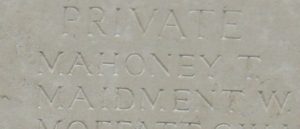
Herbert Percival Manuel, Able Seaman, R/6009, Royal Naval Volunteer Reserve. Herbert was born at Evershot, Dorset on 23 October 1893, the son of Frederick Manuel and Grace Susan Manuel (nee Lock). The family then moved to West Knowle Farm, Long Sutton, Langport, Somerset. Herbert was living at Brynmawr with his brother Ernest when war broke out. He enlisted into the army on 11 December 1915, but was transferred to the Royal Naval Volunteer Reserve, before being drafted to France on 31 December 1917, joining Howe Battalion, 63rd (Royal Naval) Division. The division had just taken part in very costly fighting at Cambrai, during the Action of Welch Ridge on 30 December, following the German counterattack, when Herbert arrived. Once the fighting eased, the division remained in the Villers-Plouich sector for the remainder of the winter and was hit hard following the launching of the German Spring Offensive on 21 March 1918, seeing heavy fighting as it was forced to retire from its positions near Havrincourt and four days later fought a defensive action near Thiepval which helped stem the German offensive. On 29 April 1918 Herbert was transferred to Anson Battalion, in the same division, but was hospitalised the same day after contracting influenza. He re-joined the battalion on 22 June 1918, by which time the Royal Naval Division was holding the line at Hérissart. On 21 August 1918 the Allies launched a great offensive along the Somme front, following the Australian and Canadian victory at Villers-Bretonneux weeks earlier, and the Royal Naval Division launched its assault from Ablainzeville towards Achiet-le-Grand. Within three days the division had crossed the Albert to Bapaume Road, reaching Thilloy soon afterwards. The division continued its advance over the coming weeks, crossing the Hindenburg line at the Escaut Canal following its fall on 29 September, and by 1 October had reached positions in front of Proville, near Cambrai. On 8 October 1918 Anson Battalion attacked from the direction of Anneuz and captured the village of Niergnies. Herbert was killed in action during the fighting that day. The 24-year-old is buried in Rumilly-en-Cambresis Communal Cemetery, France.
Charles Ellis Martin, Gunner, 57582, Royal Garrison Artillery. Charles was born in 1893, the son of Job Martin and Sarah Martin (nee Jones), of 30, Oakland Cottage, Llanddewi’r cwm, Brecon. He had served with the Brecknockshire Battalion, South Wales Borderers (Territorials) from 1908 until 1912 and had served as a Policeman at Brynmawr prior to the war. He enlisted there into the Royal Garrison Artillery alongside his friend and colleague PC Thomas Henry Pitman. Charles was posted to France early in 1916, joining ‘Y’ 34th Trench Mortar Battery, Royal Garrison Artillery. He served during the Somme offensive that summer, and towards the end of 1916 returned home to Brynmawr on two weeks leave. Charles had only been back in France a week when he was mortally wounded, and died on 16 January 1917 aged 23. He is buried in Hazebrouck Communal Cemetery, France.
Charles Mason, Private, 236598, Herefordshire Regiment. Charles was born in 1892, the son of George Mason and Mary Ann Mason (nee Pritchard), of Little Tarrington, near Hereford. He came to work at Brynmawr as a young man, but following the outbreak of war returned home to enlist at Hereford into the Herefordshire Regiment. Charles was drafted to Egypt in the summer of 1917, before moving into Palestine to join the 1/1st Battalion, Herefordshire Regiment, which was attached to the 53rd (Welsh) Division. The division had taken part in the disastrous First and Second Battles of Gaza earlier that year, then the EEF suffered a change in leadership, with Sir Edmund Allenby assuming command, before being re-organised, and a third offensive was launched against a wider front from Beersheba to Gaza on 31 October 1917. This time the Turkish defences were breached, and the road to Jerusalem now lay open and the EEF began to advance north. On 6 November 1917, 158 Brigade launched an attack on the Khuweilfeh Heights, and once secured, the EEF continued its advance into the Judean Hills, the 53rd Division capturing Hebron and Bethlehem, before securing the Jerusalem to Jericho Road. Allenby finally made his triumphant entry into Jerusalem on 11 December. The division continued its long advance north over the coming months, but by now the Turkish forces were in full retreat. Charles was killed in action on 3 May 1918. The 25-year-old is buried in Jerusalem War Cemetery, Israel.
Granville James Mitchell, Sub-Lieutenant, Royal Naval Volunteer Reserve. Granville was born on 4 March 1890, the son of James Philip Mitchell and Rhoda Jane Mitchell (nee Evans), of Wyncliffe, Hatherleigh Road, Abergavenny. On 22 March 1905 he came to Brynmawr to work as an apprentice clerk for the London and North Western Railway goods department. Granville enlisted into the 3rd Battalion, Monmouthshire Regiment soon after the outbreak of war, embarking for France to join the battalion on 27 June 1915. He was later transferred to the 9th Battalion, Royal Welsh Fusiliers, which was attached to 58 Brigade, 19th (Western) Division, where he gained the rank of Company Sergeant Major and probably saw action with the division during its assault at Loos later that year. During the following year the division saw heavy fighting during the Somme offensive, then from 7 June 1917 took part in the Battle of Messines Ridge. On 22 June 1917 Granville was discharged from the Royal Welsh Fusiliers to be commissioned as Sub-Lieutenant into the Royal Naval Division and after completing his officer training was posted back to France on 8 December 1917 and was posted to Hood Battalion, 63rd (Royal Naval) Division, which was holding a section of the line in the Cambrai sector. On 24 January 1918 Hood Battalion was relieved from the line and moved back to a rest camp at Barastre where a training scheme was carried out. The battalion moved back into the line on Welch Ridge on 14 February and carried out a five day spell in the line before being relieved and marched back to Trescault. Granville was supervising men working on shelters at Trescault on 26 February 1918 when the Germans shelled the area, and he was instantly killed. The 28-year-old is buried in Metz-En-Couture Communal Cemetery British Extension, France. Granville is not commemorated on the Brynmawr Cenotaph.
Ernest Alfred Moore, Gunner, W/2471, Royal Field Artillery. Ernest was born in 1890, the son of Edward Moore and Sarah Olivia Moore (nee Holley), of Gelly Velyn Crossing Cottage, Brynmawr. He worked as a coal hewer prior to enlisting at Cardiff into the Welsh Divisional Royal Field Artillery soon after the outbreak of war and was posted to North Wales for training. The newly raised Welsh Division had no artillery guns to start with, so the men trained with telegraph poles strapped onto farm carts, until their guns finally arrived. Once properly organised, Ernest joined C Battery, 122nd Brigade, Royal Field Artillery and the division was numbered to the 38th (Welsh) Division, before moving to Winchester in the summer of 1915 to complete its training. The Division began moving to France on 2 December 1915 and moved to the Nursery Sector near Fleurbaix for trench initiation alongside the Guards Division. The Division then held a sector of the line near Cuinchy before marching south to the Somme sector in June 1916 to take part in the assault on Mametz Wood. The first attack on the wood was launched on a two-battalion front on 7 July, but failed, and the Divisional Commander, Sir Ivor Philipps, was replaced before the Division attacked again on a two Brigade front on 10 July 1916. After two days of ferocious hand-to-hand fighting, the wood was cleared up to its northern edge, before the battered Division was relieved. It then took over a section of the front at Hébuterne before moving to the Ypres Salient, and taking over the Canal Bank sector at Boesinghe. The infantry battalions of the Division then began carrying out the normal pattern of rotation in the trenches, four days in the front, four in support and four in reserve, whilst also working on trench improvement, digging new trenches, and also carrying out regular patrols and trench raids. On 31 July 1917 the Division launched its famous assault on the Pilckem Ridge, capturing Iron Cross and reaching its objective of the Steenbeek, then played a supporting role in the Battle of Langemarck. The Division was transferred to the Sailly-sur-la-Lys sector in September, and remained in the area over the winter. At the end of March 1918 the division was transferred south to positions north of Albert, at Bouzincourt Ridge, relieving the battered 2nd and 47th Divisions, however the Divisional Artillery remained in Flanders, to counter the growing threat of a German offensive in the Lys Valley. The Germans then launched a great offensive here on 9 April 1918, smashing the Allied lines and beginning a lengthy spell of desperate fighting. The 38th Divisional artillery was still in the Sailly Sector when the Germans hit, and lay covering fire down on the Houplines Sector, whilst the Portuguese Division in front broke and fled, forcing the men to withdraw their guns back towards the river to Pont Nieppe. Heavy fighting continued on the following day whilst the artillery supported the 34th Division which was struggling to hold the line, and after the Germans captured Le Bizet, the guns were forced to withdraw again, to Neuve Eglise, where it began firing upon the Germans on the front between Steenwerck and Neuve Eglise. On the following morning, 11 April 1918, the guns were forced to withdraw again, moving behind Ravelsburg Hill, where it covered the withdraw of 88 Brigade, 29th Division. Ernest was killed in action here during the day. The 27-year-old has no known grave and is commemorated on the Ploegsteert Memorial, Belgium.
Edward Morgan, Private, 1719, Monmouthshire Regiment. Edward was born in 1891, the son of George Morgan and Annie Jane Morgan (nee Williams), of 2, Angel Buildings, Merthyr Tydfil. He came to Brynmawr prior to the war to work for the London and North Western Railway, as an under shunter in the traffic department. Edward enlisted at Blaina into the 1/3rd Battalion, Monmouthshire Regiment soon after the outbreak of war. The battalion mobilised at Abergavenny attached to the Welsh Border Brigade, Welsh Division, before moving to Pembroke Dock. On 10 August 1914 the Division moved to Oswestry before moving to Northampton, then spent Christmas at Bury St. Edmunds before moving to Cambridge. In February 1915 the 3rd Monmouth’s left the Welsh Division and landed in France on 14 February, before moving to the Ypres Salient. On 3 March 1915 the battalion joined 83 Brigade, 28th Division. On 8 April the 3rd Monmouth’s relieved a French Division in the sector east of the Polygon Wood to begin its first tour in the trenches. The battalion was relieved four days later, and marched to billets in Ypres, then on 17 April relieved the 5th King’s Own in the front line, to begin a spell which would last for 17 days without relief. On 22 April, just to the north, the Germans launched the first gas attack of the war upon French Colonial troops at Gravenstafel, heralding the opening of the Second Battle of Ypres. The fighting remained to the north of Polygon Wood until 3 May, when the Germans widened their attacks and the Polygon Wood sector was evacuated by the 28th Division, which fell back on the G.H.Q. line at Potijze. Over the coming days their new positions were shelled mercilessly, then on 8 May 1915 the Germans attacked. Despite heavy losses the Division held firm and later that day three Companies of the 3rd Monmouth’s moved back into billets at Vlamertinghe, leaving B Company in the line. Edward had been killed in action during the fighting that day. The 24-year-old has no known grave and is commemorated on the Ypres (Menin Gate) Memorial, Belgium.
Evan Morgan, Private, 204818, South Staffordshire Regiment. Evan was born in 1893, the son of Roger William Morgan and Rachel Morgan (nee Griffiths), of 118, Worcester Street, Brynmawr. He worked as a coal hewer prior to enlisting at Brecon into the 1/1st Brecknockshire Battalion, South Wales Borderers on 19 October 1914. The battalion was attached to the Welsh Division and moved to Pembroke Dock upon mobilisation. It was then withdrawn from the Division, entraining at Neyland, and on 29 October 1914 sailed from Southampton for Bombay aboard the SS Dilwari, where the battalion transhipped and sailed for Aden, arriving on 16 December 1914. The battalion endured a torrid time in the heat of Aden, losing several men to heatstroke. In August 1915 the battalion moved to India on garrison duties. On 27 March 1917 Evan volunteered to transfer to the Northumberland Fusiliers, then transferred again to the 1st (Garrison) Battalion, South Staffordshire Regiment, which was also in India. During the coming months his health began to deteriorate, and Evan was admitted to Calalice War Hospital on 10 February 1918 where he was found to have contracted tuberculosis. He was evacuated home aboard the Hospital Ship Kanowska on 28 March 1918 and was admitted to a British Red Cross Hospital upon returning to Britain. His health continued to wane, and Evan was sent to the Sanatorium at Newport, where he died of tuberculosis on 3 April 1919, aged 26. Nothing further is presently known of him, as he is not commemorated by the CWGC.
Llewellyn David Morgan, Private, 38523, Gloucestershire Regiment. Llewellyn was born in Nantyglo in 1899. He was adopted by Mary Louisa Morgan, a widow, after his birth and went to live with her at 9, Dumfries Place, Brynmawr. Llewellyn was educated at the Brynmawr County School and upon leaving school enlisted into the South Wales Borderers at Merthyr. Llewellyn was drafted to France in the late summer of 1917, joining the 8th Battalion, Gloucestershire Regiment, which was at Ypres, attached to 57 Brigade, 19th (Western) Division. The Division had seen heavy fighting during the Battle of Messines Ridge on 7 June 1917, which was famously preceded by the blowing of a series of 19 huge underground mines. The 19th Division saw heavy fighting during the battle, then enjoyed a short spell in reserve before moving back into the line on 11 September, taking over a section of trenches running from the Ypres-Comines Canal to Belgian Wood. On 20 September the division took part in an attack past Hollebeke Chateau, to Hessian Wood, suffering terrible casualties. Llewellyn probably arrived as the 8th Gloucester’s were in the process of refitting following this attack. The Division saw further fighting at Ypres, before moving south and wintered in the Cambrai sector, following the closure of the Battle of Cambrai, and held a section of the line in the Flesquières Salient. Llewellyn was wounded whilst the 8th Gloucester’s were undertaking a routine spell in the front line near Havrincourt Wood and was evacuated to a Casualty Clearing Station at Manancourt, where he died of his wounds on 30 January 1918. The 19-year-old is buried in Rocquigny-Equancourt Road British Cemetery, Manancourt, France.
William Morgan, Private, 36069, Welsh Regiment. William was born in 1873, the son of Evan Morgan and Elizabeth Morgan (nee Bevan), of 12, Worcester Buildings, Brynmawr. He worked as a coal hewer and had served with the 3rd Battalion, South Wales Borderers at some time prior to the war. William re-enlisted at Brynmawr and embarked for France on 5 May 1915, joining the 1st Battalion, Welsh Regiment, which was at Dranoutre, attached to 84 Brigade, 28th Division. The battalion had suffered terrible losses over the previous weeks, following the German gas attack at Gravenstafel on 22 April which heralded the opening of the Second Battle of Ypres. Following serious casualties at Ypres, a Composite Brigade was formed, composing of the 2nd Buffs, 2nd Cheshire’s, 1st Welsh, and the 1st York and Lancaster’s. It was dissolved on 19 May 1915, and the formation assumed its normal configuration. The 1st Welsh then marched to billets in farm buildings around Herzeele to enjoy a short rest, before marching back via Vlamertinghe to Ypres, taking over the trenches near Hooge on 22 May. The battalion was relieved two days later, moving back into support positions, but on 24 May the relieving battalion, the 11th Hussars, was attacked and lost ground, so the 1st Welsh had to rush forwards to their aid. Heavy fighting raged throughout the remainder of the day, whilst the line was restored, and on the following morning, 25 May 1915, the 1st Welsh launched a counter-attack but suffered heavy losses before reforming on the north of the Menin Road near Witte Poort Farm, before renewing the attack upon German positions at Bellewaarde. William was killed in action during the fighting that day. The 37-year-old has no known grave and is commemorated on the Ypres (Menin Gate) Memorial, Belgium.
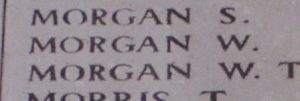
Evan Morris, Private, 2094, Monmouthshire Regiment. Evan was born at Blaenavon in 1888, the son of William Morris and Margaret Morris (nee Edwards). He came to Brynmawr to work as a coal hewer as a young man, and early in 1911 married Florence Agnes Taylor. The couple then lodged with her brother-in-law and her sister, Eli and Alice Spackman, at 61, Worcester Street, Brynmawr. Evan enlisted at Abergavenny into the 1/3rd Battalion, Monmouthshire Regiment soon after the outbreak of war. The battalion mobilised at Abergavenny attached to the Welsh Border Brigade, Welsh Division, before moving to Pembroke Dock. On 10 August 1914 the Division moved to Oswestry before moving to Northampton, then spent Christmas at Bury St. Edmunds before moving to Cambridge. In February 1915 the 3rd Monmouth’s left the Welsh Division and landed in France on 14 February, before moving to the Ypres Salient. On 3 March 1915 the battalion joined 83 Brigade, 28th Division. On 8 April the 3rd Monmouth’s relieved a French Division in the sector east of the Polygon Wood to begin its first tour in the trenches. The battalion was relieved four days later, and marched to billets in Ypres, then on 17 April relieved the 5th King’s Own in the front line, to begin a spell which would last for 17 days without relief. On 22 April, just to the north, the Germans launched the first gas attack of the war upon French Colonial troops at Gravenstafel, heralding the opening of the Second Battle of Ypres. The fighting remained to the north of Polygon Wood during the early days of the battle, so the Monmouth’s were left relatively unmolested, for now. Evan was killed by German artillery fire whilst the battalion was preparing to withdraw on 2 May 1915. The 27-year-old has no known grave and is commemorated on the Ypres (Menin Gate) Memorial, Belgium.
Timothy Murphy, Private, 15267, South Wales Borderers. Timothy was born in 1875, the son of James and Margaret Murphy, of 6, Miles Row, Brynmawr. He had served with the South Wales Borderers as a young man, so was an Army Reservist when war broke out. Timothy was drafted to France on 26 January 1916, joining the 1st Battalion, South Wales Borderers, which was holding the line in the Richebourg-L’avoue sector, attached to 3 Brigade, 1st Division. The 1st Division took part in its first major action of 1915 here on 9 May 1915, during the Battle of Aubers Ridge, when it attacked alongside the Meerut Division. The attack of the 2nd Welsh was held up by a flooded ditch, which the men forded, before being hit by heavy machine-gun fire, and a large number of casualties were suffered before the survivors withdrew. Timothy was killed in action during the fighting that day. The 40-year-old has no known grave and is commemorated on the Le Touret Memorial, Richebourg-L’avoue, France.
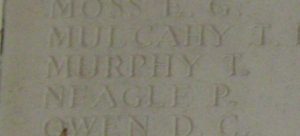
Samuel Morley Neat, Private, 29616, Royal Welsh Fusiliers. Samuel was born on 24 September 1896, the son of James Frank Neat and Elizabeth Margaret neat (nee Hope), of 70, King Street, Brynmawr. He won a scholarship at the Brynmawr County School, and, subsequently went to the Normal College, at Bangor, before gaining a position as a teacher Nantyglo Council School. Samuel enlisted at Bangor into the Royal Welsh Fusiliers on 21 January 1916 and was posted to the 21st Battalion, Royal Welsh Fusiliers at Kinmel Park for training. Samuel was drafted to France that summer, embarking at Folkestone aboard the SS Henrietta on 24 June 1916 and disembarked at Boulogne on the following day, before joining the 38th Infantry base Depot at Étaples. On 9 July 1916 he was posted to the 1st Battalion, Royal Welsh Fusiliers, which was on the Somme, attached to 22 Brigade, 7th Division. The Division had taken part in the opening assault of the Somme offensive on 1 July 1916, advancing from positions near Bois Francais, near Fricourt, and capturing the village of Mametz, one of the few successes of 1 July 1916. The battalion then took part in further attacks to push forwards, to the south of Mametz Wood, and upon being relieved, witnessed the troops of the 38th (Welsh) Division moving forward to launch its assault on Mametz Wood. On 14 July, with the wood taken, the 7th Division moved back into the line, with orders to capture Bazentin-le-Petit, before taking part in the terrible attacks on High Wood over the coming days. On 22 July the 1st RWF was relieved, moving back into reserve to rest and rebuild at La Chaussee. By 12 August the battalion had moved forwards to Dernancourt, and on 26 August marched further forward, to take part in the Divisions assault on Ginchy. The Division saw heavy fighting over the coming days, before the 1st RWF had another short break, but on 1 September the battalion received orders to push forwards again to launch a fresh assault on Ginchy from Montauban Alley. On 3 September 1916 the 1st RWF launched its assault, but suffered severe casualties, with over 200 officers and men killed, wounded or missing. Samuel was killed in action during the fighting that day. The 19-year-old has no known grave and is commemorated on the Thiepval Memorial, France.
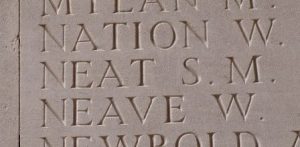
Frederick Nuth, Sergeant, SE/13769, Royal Army Veterinary Corps. Frederick was born in 1885, the son of Elijah Nuth, a grocer, and of Sarah Elizabeth Nuth (nee Hodges), of Brynmawr. His mother died when he was young, and his father remarried to her step-sister, Amelia Hammond, in 1887. Frederick enlisted at Woolwich into the Royal Army Service Corps soon after the outbreak of war and was drafted to France in 1916, joining the 8th Division Ammunition Column. His primary work was to care for the horses which the unit used to pull its transports. The division moved to the Somme in 1916, where it fought at the Battle of Albert. In March 1917 it followed the German Retreat to the Hindenburg Line, and later that year moved to Ypres, fighting at the Battle of Pilckem, and the Battle of Langemarck. In March 1918 the Division was on the southern end of the Somme, and was hit hard following the launching of the German Spring offensive of 21 March 1918. After weeks of desperate rearguard actions, the division was relieved and moved south to the more peaceful Aisne sector to rest and refit. However, on 27 May 1918 the Germans launched the third, and final, phase of their Spring offensive along the Chemin-des-Dames Ridge, launching the Third Battle of the Aisne, and the 8th Division was once again caught up in ferocious fighting. Frederick was badly wounded during the day and was evacuated to a French Hospital, where he died of his wounds two days later, on 29 May 1918. The 33-year-old is buried in Chateau-Thierry (Les Chesneaux) French National Cemetery, France.
James O’Brien, Rifleman, 20080, Royal Irish Rifles. James was born in Cardiff in 1895, the son of John O’Brien and Margaret O’Brien (nee Wallace). The family moved to 119, Worcester Street, Brynmawr prior to the war. James worked as a labourer prior to enlisting into the Royal Irish Rifles at Abertillery soon after the outbreak of war. He was drafted to France in the summer of 1916, joining the 1st Battalion, Royal Irish Rifles, which was attached to 25 Brigade, 8th Division. The division fought throughout the Somme offensive, attacking Ovillers on the opening day, 1 July 1916, where it suffered over 400 casualties. The battered division was swiftly relieved and moved to the Hohenzollern sector at loos to refit before moving back to the Somme at the end of October. In March 1917 the division followed the German Retreat to the Hindenburg Line, and later that year moved to Ypres, fighting at the Battle of Pilckem, and the Battle of Langemarck before wintering in the Goudberg sector. On 3 February 1918, following the reorganisation of the army, the 1st Royal Irish Rifles transferred to 107 Brigade, 36th (Ulster) Division and entrained at Hopoutre, before detraining at Ham and marched to join the division at Essigny, where it was facing the Hindenburg Line. At dawn on 21 March 1918 the division was hit hard following the launching of the German Spring offensive, and saw heavy fighting as it withdrew over the coming days. The division then moved back to the Loos area before moving further north into the Ypres Salient, taking over positions in front of the Canal Bank at Boesinghe. The division then enjoyed a relatively quiet time, as the Germans launched another offensive to the south, along the Lys Valley, and saw little action during the coming months. James was killed during a routine spell in the trenches near Hazebrouck on 6 August 1918. The 23-year-old has no known grave and is commemorated on the Ploegsteert Memorial, Belgium.
Horace Stanley Parsons, Private, 201306, South Wales Borderers. Horace was the son of William and Mary Ann Parsons, of Silver Lane, Crickhowell. He resided at Brynmawr prior to the war, where he worked as a grocer’s assistant, and played rugby for the Brynmawr Rugby Club. Horace enlisted into the 2/1st Brecknockshire Battalion, South Wales Borderers at Brecon at some time after the outbreak of war and was drafted out to India in 1916, joining the 1/1st Brecknockshire Battalion, which was on garrison duty at Mhow. Horace sadly became ill whilst in India and died of disease at Mhow on 17 October 1918, less than a month before the Armistice. The 35-year-old was buried in a mass grave in Mhow New Cemetery, Madhya Pradesh, so is commemorated on the Kirkee 1914-1918 Memorial, India. His nephew, Charles Parsons, died at home in 1918.
Arthur Plaster, Private, 33799, Royal Welsh Fusiliers. Arthur was born on 24 August 1895, the son of John Plaster and Elizabeth Plaster (nee Francis), of 10, Clock Row, Blaina. He worked as a collier as a young man and enlisted into the Royal Navy, but was discharged as medically unfit due to poor eyesight. Arthur returned home, then enlisted into the South Wales Borderers at Brecon on 29 January 1913, but was discharged as medically unfit again on 24 October 1913, before returning to live with his brother James and his family at 24, George Street, Brynmawr, where he gained work as a collier. He re-enlisted into the 3rd Battalion, South Wales Borderers at Brynmawr on 29 September 1914 and was posted to Pembroke Dock, before being posted to Gibraltar to join the 1st (Garrison) Battalion, South Wales Borderers. On 8 May 1916 Arthur was drafted to France on 14 May 1916 and was transferred from the 38th Infantry Base Depot at Étaples to the 10th Battalion, Royal Welsh Fusiliers, which was attached to 76 Brigade, 3rd Division. By the middle of June the Division had moved out of the Ypres Salient to billets around Eperlecques, where intense training was carried out prior to moving to the Somme sector by 2 July. The main Somme offensive had opened on the previous day, and the 3rd Division was ready to enter the fray, bivouacking at Bronfay Farm by 9 July and on 13 July moved into the captured German lines at Montauban Alley. The 10th RWF took part in heavy fighting over the coming days, and on 19 July received orders for an assault on Delville Wood. Just after midnight the following day the battalion moved forwards and became caught in in terrible fighting within the wood, the fighting of such severity that two men of the battalion were awarded the Victoria Cross. Arthur was initially posted as missing after the terrible fighting of 20 July 1916 and was later deemed to have been killed in action on that date. The 20-year-old has no known grave and is commemorated on the Thiepval Memorial, France.
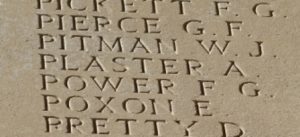
Sidney Price, Lance Corporal, 2567, South Wales Borderers. Sidney was born in Bromyard, Herefordshire in 1869, the son of William Price and Jane Price (nee Farmer). He married Catherine Ann Jennings in 1889 and by 1896 the couple had settled at 26, Somerset Street, Brynmawr, where Sidney found work as a chimney sweep. Sidney was a long serving part-time soldier, having enlisted into the 1st Herefordshire Rifle Volunteer Corps on 23 March 1886 and served continuously before moving to Brynmawr. He then transferred into the 4th Volunteer Battalion, South Wales Borderers on 1 March 1896 and again served continuously over the coming years. On 7 April 1908, following the formation of the Territorial Force, he attested into the newly formed Brecknockshire Battalion, South Wales Borderers, attending very annual TA Summer Camp until being discharged as time expired on 6 April 1914, having gained the award of the Long Service Good Conduct Medal. When war erupted, Sidney felt the urge to serve again and on 13 October 1914 re-enlisted at Brynmawr into the 2/1st Brecknockshire Battalion, South Wales Borderers. He was granted the rank of Lance Corporal and was posted to the 3/1st Brecknocks upon its formation in April 1915. The battalion was stationed at Pembroke Dock and Dale and formed part of the Milford Haven defences. By now Sidney’s health had started to fail and he was discharged from the army as medically unfit on 21 August 1916. He returned home to Brynmawr, where he died on 13 November 1916, aged 47. Despite almost 30 years’ service as a part time soldier, Sidney is not commemorated as a war casualty by the CWGC. He is not even commemorated on the Brynmawr Cenotaph.
Jonah Pritchard, Sapper, 79418, Royal Engineers. Jonah was born in 1886, the son of William Pritchard and Mary Pritchard (nee Thompson), of 2, Glamorgan Square, Brynmawr. He worked as a coal hewer prior to enlisting at Abertridwr into the South Wales Borderers soon after the outbreak of war. Jonah embarked for France on 3 May 1915, initially to join the 1st Battalion, South Wales Borderers, but as a skilled miner, transferred to the 173rd Tunnelling Company, Royal Engineers. The company had formed in March 1915 and served under the Second Army in the Ypres Salient, digging mines and tunnels in the Hill 60 sector, before moving into the Fauquissart area near Laventie in northern France to begin work around Aubers Ridge and then in Cuinchy, a notoriously dangerous sector, where mining and counter-mining was prevalent. In January 1916, the 173rd Tunnelling Company moved to the Hulluch-Loos area and began driving shafts and galleries to counter enemy mining at various levels in the Hill 70 – Copse – Double Crassier area of Loos. On 8 March 1916 Jonah was among a party of men opening a new drive, No 15 mine, when a German shell hit them, killing him and fourteen of his comrades. The 28-year-old is buried in what is really a mass grave in Noeux-Les-Mines Communal Cemetery, France. His brother, William, had been killed at Gallipoli in 1915.
William Hammond Pritchard, Private, 11097, South Wales Borderers. William was born in 1893, the son of William Pritchard and Mary Pritchard (nee Thompson), of 2, Glamorgan Square, Brynmawr. He worked as a coal hewer prior to enlisting at Brecon into the South Wales Borderers just before the war. He embarked for France on 20 September 1914, joining the 1st Battalion, South Wales Borderers, which was on the Aisne, attached to 3 Brigade, 1st Division. The Division had taken part in the epic retreat from Mons to the Marne, where the Germans were stopped. The Germans then withdrew north and took up defensive positions north of the River Aisne, along the Chemin des Dames Ridge and the BEF advanced before launching a frontal attack upon the German positions. The battle ended in a stalemate and both sides dug-in, beginning the line of trenches which was to become known as the Western Front. The BEF then began moving to Flanders on 17 October, before advancing from Poperinghe past endless numbers of refugees and took up positions guarding the strategically vital city of Ypres, the 1st Division taking up positions near Langemarck by 21 October. Later that day the division was attacked by hordes of Germans, mainly young student-soldiers, who were mown down by the highly trained British soldiers. The Germans maintained their attacks over the coming days but were held at bay, sustaining terrible losses, and the line here stabilised, so by 27 October the 1st Division moved to positions near Zandvoorde, guarding the Menin Road. On 31 October 1914 the 1st Division faced its sternest test so far, when the Germans attacked its positions on the Menin Road, behind a fearsome artillery bombardment. William was wounded at Ypres at some time and was evacuated home. He returned home to Brynmawr on leave in February 1915, and was arrested for being drunk and disorderly. As soon as he had recovered his fitness, William was posted to Rugby to join the 2nd Battalion, South Wales Borderers, which had just returned from service in China and was attached to 87 Brigade, 29th Division. On 17 March 1915 the battalion sailed from Avonmouth with the Division, arriving at Alexandria on 29 March, before moving to Mudros. On 25 April 1915 the Division landed at Cape Helles, Gallipoli, as part of the original landing force which had been despatched to try and seize the Dardanelles Straits and force Turkey out of the war. The invasion forces failed to break the Turkish defences and the campaign became bogged down. William was killed in action during fighting at Turkey Trench on 11 June 1915. The 22-year-old is buried in Twelve Tree Copse Cemetery, Gallipoli. His brother, Jonah, was killed in France in 1916.
Thomas John Prout, Private, 1840, South Wales Borderers. Thomas was born in 1879, the son of William Prout and Leah Prout (nee Jenkins), of 114, King Street, Brynmawr. He married Emily Vaughan in 1905 and the couple lived at 65, King Street, Brynmawr. Thomas worked as a coal hewer for many years prior to enlisting at Brynmawr into the Brecknockshire Battalion, South Wales Borderers. The battalion was attached to the Welsh Division and moved to Pembroke Dock upon mobilisation. It was then withdrawn from the Division, entraining at Neyland, and on 29 October 1914 sailed from Southampton for Bombay aboard the SS Dilwari, where the battalion transhipped and sailed for Aden, arriving on 16 December 1914. The climate in Aden was fearsome, with scorching heat during the day, and with little to do, the men spent much of their free time playing football. Thomas took ill whilst at Aden and was evacuated aboard HM Transport Neuralia. He died of pneumonia aboard ship on 10 March 1915 and was buried at sea. The 35-year-old is commemorated on the Chatby Memorial, Alexandria, Egypt. One of his sons, William Alfred Vaughan, was killed in Italy in 1943.
Henry Richards, Private, 14901, South Wales Borderers. Henry was born in 1881, the son of Henry Richards and Frances Richards (nee Smith), of Ross-on-Wye. He enlisted into the 4th Battalion, King’s Shropshire Light Infantry and served for several years before coming to Brynmawr to work as a collier and in 1905 married Louisa Warburton, of 8, Miles Row, Brynmawr. The couple had moved to 21, River Row, Blaina by 1911 and Henry worked as a colliery labourer. Henry enlisted at Brynmawr into the South Wales Borderers soon after the outbreak of war and was drafted to France on 10 December 1914, joining the 1st Battalion, South Wales Borderers, which was attached to 3 Brigade, 1st Division and had moved from Ypres to billets at Outtersteene to rebuild following heavy losses over the preceding weeks. On 20 December the now rebuilt 1st SWB left for Merris, before the 1st Division took up new positions in the line at Festubert, a wet marshy area. On Christmas Day the men were in the trenches, cold and wet, when they were presented with their Princess Mary gift tins, which contained cards and gifts on behalf of the Royal Family. The line was relatively quiet over this period, but the trenches were flooded and in a terrible state. On 4 January 1915 the 1st SWB were relieved and moved back to Bethune, where the men were allowed to bathe and received issues of clean clothes, before moving back into the Festubert trenches four days later. The battalion remained in the line here until 14 January when it relieved the Black Watch at Givenchy. At dawn on 25 January 1915 the Germans hit their lines with an intensive artillery bombardment, before launching an infantry assault, breaking through 100 yards of trench and reaching Givenchy village. Heavy fighting raged throughout the day as the Germans were driven back and the line regained. During July 1916 the Division moved south, to join the great Somme offensive, and the 1st SWB reached Albert by 10 July, taking up billets in the town. On the morning of 15 July the 1st SWB received orders to proceed via the recently captured Mametz Wood to the new front line, taking over support positions behind the 2nd Welsh near Bazentin-le-Petit Wood and remained in reserve whilst 3 Brigade launched an assault against Bazentin Ridge. On 18 July the 1st SWB withdrew to the old German front line near Lozenge Wood before moving back to Albert via Becourt Wood where the men enjoyed a cold bath in the river Ancre. The 1st SWB then endured another short spell in the line before moving back to Millencourt on 26 July to rest and did not proceed into the battle zone again until 15 August, when the battalion marched via Becourt Wood and on 20 August moved back into the front line at Bazentin-le-Petit Wood, when 3 Brigade relieved 1 and 2 Brigades. The brigade endured a terrible time here over the coming days, being almost incessantly shelled by German artillery. Henry was killed in action near Bazentin-le-Petit on 21 August 1916. The 34-year-old is buried in Peake Wood Cemetery, Fricourt, France. (The Brynmawr Cenotaph shows J. Richards, SWB, but that must be an error).
John Sinclair, Private, 267535, Monmouthshire Regiment. John was born at Tipton, Staffordshire in 1887, the son of William Sinclair and Sarah Sinclair (nee Hunter). The family was residing at 5, Rhasfach, Brynmawr by 1911, and John was working as a coal hewer. He enlisted into the 2nd Battalion, Monmouthshire Regiment on 15 June 1914, prior to the war. John did not embark for France until 1916. He was reported as having died of wounds in a casualty list in April 1917, but had actually been wounded and was alive, suffering gunshot wounds to his right forearm. He may well have been wounded and taken prisoner, hence the mix-up, but nonetheless, John survived and was discharged from the army as medically unfit on 20 April 1918 due to his wounds. He returned to Brynmawr at some time, as by 1921 he was resident back there again, and died in 1927, aged 40.
George South, Private, 43886, Welsh Regiment. George was born at Birmingham in 1896, the son of Philip South and Emma South (nee Tedstone). His father served during the Boer War of 1899-1901 and upon his return home moved his young family to Brynteg, Llanarth, near Raglan. Prior to the outbreak of war the family had moved again to 17, Warwick Road, Brynmawr. George’s father re-enlisted as soon as war erupted, whilst George, who was working at the Ebbw Vale Steelworks, enlisted in November 1914 into the Welsh Regiment. He was drafted to Mesopotamia in September 1916, joining the 8th Battalion, Welsh Regiment, which was attached to the 13th (Western) Division. The division had been evacuated to Egypt from Gallipoli on 8 January 1916, concentrating at Port Said, where it held forward posts in the Suez Canal defences. On 12 February 1916 the Division began to move to Mesopotamia, to strengthen the force being assembled for the relief of the besieged garrison at Kut al Amara. By 27 March, the Division had assembled near Sheikh Saad and came under orders of the Tigris Corps, and then took part in the attempts to relieve Kut. However, after these efforts failed and Kut fell, the British force in the theatre was built up and reorganised. The Division then fought at the Battle of Kut al Amara, then at the capture of the Hai Salient and the capture of Dahra Bend. They took part in the passage of the Diyala, in the pursuit of the enemy towards Baghdad. George was wounded during the advance on Baghdad and died of his wounds on 25 February 1917. The 21-year-old is buried in Amara War Cemetery, Iraq.
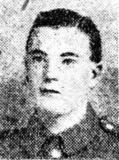
John George Alex Sutherland, Gunner, 48224, Royal Garrison Artillery. John was born in 1897, the son of John Alex Sutherland and Georgina Sutherland, of 116, Worcester Street, Brynmawr. His parents were both from Caithness, in Scotland, but had moved to Brynmawr due to his fathers work as a draper. John enlisted at Brynmawr into the Royal Garrison Artillery and was drafted to France early in 1916, being posted to the 61st Trench Mortar Battery, Royal Garrison Artillery. John was badly wounded soon after joining the battery and was evacuated to the 13th General Hospital at Boulogne, where he died of his wounds on 22 March 1916. The 20-year-old is buried in Boulogne Eastern Cemetery, France.
Donald McDonald Taylor, Lance Corporal, PS/3299, Royal Fusiliers. Donald was born in 1896, the son of William McDonald Taylor, JP, and Florence Melissa Taylor (nee Evans), of Latheron, Brynmawr. He was educated at Brynmawr County School and then at Cardiff University, but left University to enlist at Cardiff into the 21st (4th Public Schools) Battalion, Royal Fusiliers. The battalion was raised at Epsom on 11 September 1914 by the Public Schools and University Men’s’ Force, before moving to Ashstead, where it remained until March 1915, becoming attached to 98 Brigade, 33rd Division. On 14 November 1915 the battalion embarked for France with the division, moving to positions at Beuvry, in Northern France, for trench initiation. The sector had been the scene of the bloody Battle of Loos over the previous weeks, so was not an ideal place to initiate a fresh division, nonetheless, its infantry battalions spent the coming weeks rotating between duty in the trenches before moving to the L’Epinette and Festubert sector, then returned to the Annequin South sector. Donald’s battalion was in the front line on 11 January 1916 when Donald was killed by enemy shellfire. The 19-year-old is buried in Cambrin Churchyard Extension, France.
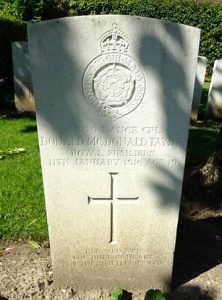
George Watson Taylor, Rifleman, 301743, London Regiment (London Rifle Brigade). George was born on 7 October 1895, the son of William Robert Taylor and Jemima Young Taylor (nee Watson), of Richmond Villa, Brynmawr. His father had come to Brynmawr from Scotland to set up his own Drapery business by 1891. George was educated at Brynmawr County School before becoming a clerk at the Admiralty, and was attached to their Intelligence department. He enlisted in London into the London Rifle Brigade on 10 August 1915 and was posted to the 2/5th Battalion, London Regiment (London Rifle Brigade). The battalion had formed in London in September 1914, before moving to Hayward’s Heath to join 174 Brigade, 58th (London) Division, the completed its training in the Ipswich area before embarking for France on 25 January 1917, landing at Le Havre where the battalion entrained for Abbeville, then travelled on to Auxi-le-Chateau. Upon detraining, the men marched to billets at Rougefay, then over the coming days marched into the Somme sector, reaching Foncquevillers by 2 February. By the time that the division was ready to move into the line, the Germans had begun Operation Alberich, a strategic withdrawal to the shorter Hindenburg Line, to allow them to free up men to send to the Eastern front. As a result, the 58th Division began to follow up the German withdrawal, pushing forward from its reserve positions near Serre towards Boisleux-St-Marc and Mory towards Bullecourt, in the Arras Sector. On 9 April 1917 the Allies launched a great offensive in this Arras Sector, aimed at breaking the Hindenburg Line. On 15 May the 2/5th London Rifles moved forwards into positions southwest of Bullecourt, in readiness to attack on the following morning. At dawn on 16 May 1917 the battalion moved into its attack positions, but soon received orders that their assault would be delayed by 24 hours. George was killed in action during the day. The 21-year-old was originally buried by the roadside in Bullecourt, but the location of is grave was later lost, so he is commemorated on the Arras Memorial, France.
Arthur Emrys Thomas, Private, 71984, Royal Army Medical Corps. Arthur was born in Cwmtillery in 1894, the youngest child of Thomas Thomas and Mary Thomas (nee Evans). He was raised with his brother Philip Thomas and sister-in-law Fanny Elizabeth Thomas (nee Witch) at Waterfall Cottage, Gilwern, then by 1911 Arthur was lodging with another older brother at Blackrock, Clydach, where he was working as a coal miner. He enlisted into the 38th (Welsh) Division, Royal Army Medical Corps at Brynmawr on 25 October 1915 and was posted to Brecon for his medical before entraining to Aldershot for training. Arthur was drafted to Egypt on 3 February 1916 and upon his arrival was attached to the 1/6th Battalion, Essex Regiment, which was attached to 161 Brigade, 54th (East Anglian) Division. The Division had been evacuated from Gallipoli just over a month before Arthur arrived in Egypt, then took part in the campaign against the Senussi tribesmen when it moved into positions to guard the coast railway from Alexandria to Da’aba. The Essex battalions were relieved on 4 March 1916 and moved into the Southern Section of the Suez Canal Defences. During the remainder of 1916, the units of the 54th Division were steadily brought up to strength and in January 1917 began assembling for the opening of the Palestine Campaign before advancing across the Sinai Desert in readiness to take part in the First Battle of Gaza. The battle opened on 26 March 1917, with the 53rd (Welsh) Division leading the way and 161 Brigade followed in support before taking Green Hill. Due to poor communication, the 53rd Division withdrew during the night, leaving 161 Brigade isolated before it too was forced to withdraw, suffering heavy casualties. Arthur was wounded during the battle and was evacuated to hospital at Deir el Belah, where he died of his wounds on 29 March 1917. The 23-year-old is buried in Deir El Belah War Cemetery, Israel.
Henry Idris Thomas, Private, 29043, South Wales Borderers. Henry was born in 1896, the son of Reverend David Thomas, and of Jane Elizabeth Thomas, of Tyr Onnen, 9, Alma Street, Brynmawr. His father was pastor of Bailey Street Presbyterian Church, Brynmawr. Henry was educated at Brynmawr County School before gaining a position as an assistant chemist at Ebbw Vale. He enlisted into the South Wales Borderers in January 1917 and was drafted to France in May, being posted to the 5th Battalion, South Wales Borderers, which was the Pioneer Battalion to the 19th (Western) Division. Henry joined the battalion at Ypres, where it was under the command of Courtney Vow Trower, a well-regarded officer. The battalion was hard at work constructing tramways and digging trenches in preparation for the forthcoming assault on Messines Ridge. Two main tramways were under construction by the 5th SWB: the Lille Gate tramway and the Zillebeke tramway, and the battalion was enduring a tough time, constantly losing men through German artillery fire. The Battle of Messines Ridge opened at dawn on 7 June 1917, heralded by the blowing of some 21 vast underground mines, which obliterated the German lines. The British then launched a massed infantry assault, supported by large numbers of tanks, upon the shattered German defenders who survived. The men of the 5th SWB followed up the infantry assault, consolidating the freshly gained ground and constructing mule-ways and cart tracks, to enable the front-line to be supplied. Henry was killed in action whilst carrying out this vital work that day. The 20-year-old is buried in Voormezeele Enclosure No. 3, Belgium.
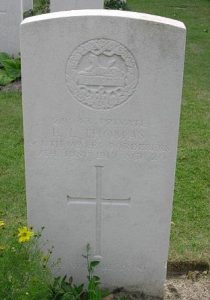
Thomas Tuck, Private, 8510, South Wales Borderers. Thomas was born in 1874, the son of William Tuck and Elizabeth Tuck (nee Cooper), of 5, Garn Cross, Nantyglo. He married Harriet Ann Evans in 1895 and the couple set up home at 17, Stone Houses, Blaina. Thomas worked as a collier prior to enlisting into the South Wales Borderers under the alias of John Buckley at Blaina on 9 August 1904, leaving his wife and their young son behind. He left the army and moved to Alma Street, Brynmawr after marrying Martha Selina Timson in Bristol in 1913. Thomas then worked as a surface fireman for Silvanus Jones at the California Colliery at Nantyglo. As a former soldier, Thomas was on the Army Reserve and was mobilised in August 1914, joining the 1st Battalion, South Wales Borderers. He embarked for France with the battalion and disembarked at Le Havre on 13 August 1914. The battalion was attached to 3 Brigade, 1st Division and entrained for the Belgian frontier, near the town of Mons. The Division then took part in the Battle of Mons on 23 August, following the German invasion of the low countries, and in the epic withdrawal from Mons to the River Marne, where the German drive on Paris was halted. The Germans then withdrew north and took up defensive positions north of the River Aisne, along the Chemin des Dames Ridge and the BEF advanced before launching a frontal attack upon the German positions. The battle ended in a stalemate and both sides dug-in, beginning the line of trenches which was to become known as the Western Front. The BEF then began moving to Flanders on 17 October, before advancing from Poperinghe past endless numbers of refugees and took up positions guarding the strategically vital city of Ypres, the 1st Division taking up positions near Langemarck by 21 October. Later that day the division was attacked by hordes of Germans, mainly young student-soldiers, who were mown down by the highly trained British soldiers. The Germans maintained their attacks over the coming days but were held at bay, sustaining terrible losses, and the line here stabilised, so by 27 October the 1st Division moved to positions near Zandvoorde, guarding the Menin Road. On 31 October 1914 the 1st Division faced its sternest test so far, when the Germans attacked its positions on the Menin Road, behind a fearsome artillery bombardment. Thomas was killed in action during the epic action at Gheluvelt that day. The 40-year-old has no known grave and is commemorated on the Ypres (Menin Gate) Memorial, Belgium.
Wilfred Thomas Turner, Sergeant, 1010, Monmouthshire Regiment. Wilfred was born in 1890, the son of Thomas Turner and Mary Ann Turner (nee Pugh), of 4, Chapel Street, Brynmawr. He worked as a haulier prior to the war and lived at 25, Church Street, Blaina. Wilfred married Catherine Maud Poulton, of 53, Bourneville, Blaina on 7 October 1912 and she moved in with him at Church Street. Wilfred had enlisted into the 1/3rd Battalion, Monmouthshire Regiment some time prior to the war. The battalion mobilised at Abergavenny attached to the Welsh Border Brigade, Welsh Division, before moving to Pembroke Dock. On 10 August 1914 the Division moved to Oswestry before moving to Northampton, then spent Christmas at Bury St. Edmunds before moving to Cambridge. In February 1915 the 3rd Monmouth’s left the Welsh Division and landed in France on 14 February, before moving to the Ypres Salient. On 3 March 1915 the battalion joined 83 Brigade, 28th Division. On 8 April the 3rd Monmouth’s relieved a French Division in the sector east of the Polygon Wood to begin its first tour in the trenches. The battalion was relieved four days later, and marched to billets in Ypres, then on 17 April relieved the 5th King’s Own in the front line, to begin a spell which would last for 17 days without relief. On 22 April, just to the north, the Germans launched the first gas attack of the war upon French Colonial troops at Gravenstafel, heralding the opening of the Second Battle of Ypres. The fighting remained to the north of Polygon Wood until 3 May, when the Germans widened their attacks and the Polygon Wood sector was evacuated by the 28th Division, which fell back on the G.H.Q. line at Potijze. Over the coming days their new positions were shelled mercilessly, then on 8 May the Germans attacked. Despite heavy losses the Division held firm and later that day three Companies of the 3rd Monmouth’s moved back into billets at Vlamertinghe, leaving B Company in the line. By now casualties had become so severe that on 10 May a Composite Battalion was formed from remnants of 83 Brigade, under Lt Col Gough, and proceeded to the G.H.Q. line at Potijze. Wilfred was killed beside his younger brother William on 11 May 1915. The 24-year-old has no known grave and is commemorated on the Ypres (Menin Gate) Memorial, Belgium.
William James Turner, Lance Corporal, 1304, Monmouthshire Regiment. William was born in 1893, the son of Thomas Turner and Mary Ann Turner (nee Pugh), of 4, Chapel Street, Brynmawr. He worked as a coal hewer prior to the war. William, like his elder brother Wilfred, had enlisted into the 1/3rd Battalion, Monmouthshire Regiment some time prior to the war. The battalion mobilised at Abergavenny attached to the Welsh Border Brigade, Welsh Division, before moving to Pembroke Dock. On 10 August 1914 the Division moved to Oswestry before moving to Northampton, then spent Christmas at Bury St. Edmunds before moving to Cambridge. In February 1915 the 3rd Monmouth’s left the Welsh Division and landed in France on 14 February, before moving to the Ypres Salient. On 3 March 1915 the battalion joined 83 Brigade, 28th Division. On 8 April the 3rd Monmouth’s relieved a French Division in the sector east of the Polygon Wood to begin its first tour in the trenches. The battalion was relieved four days later, and marched to billets in Ypres, then on 17 April relieved the 5th King’s Own in the front line, to begin a spell which would last for 17 days without relief. On 22 April, just to the north, the Germans launched the first gas attack of the war upon French Colonial troops at Gravenstafel, heralding the opening of the Second Battle of Ypres. The fighting remained to the north of Polygon Wood until 3 May, when the Germans widened their attacks and the Polygon Wood sector was evacuated by the 28th Division, which fell back on the G.H.Q. line at Potijze. Over the coming days their new positions were shelled mercilessly, then on 8 May the Germans attacked. Despite heavy losses the Division held firm and later that day three Companies of the 3rd Monmouth’s moved back into billets at Vlamertinghe, leaving B Company in the line. By now casualties had become so severe that on 10 May a Composite Battalion was formed from remnants of 83 Brigade, under Lt Col Gough, and proceeded to the G.H.Q. line at Potijze. Wilfred was killed beside his elder brother Wilfred on 11 May 1915. The 22-year-old has no known grave and is commemorated on the Ypres (Menin Gate) Memorial, Belgium. (The Brynmawr Cenotaph shows ‘SERGT. TURNER, W. J. MONS’ This appears to be a mix up between the two brothers, showing the initials of one and the rank of the other. Also, only one brother is commemorated on the cenotaph!
Albert James Vaughan, Private, 267547, Monmouthshire Regiment. Albert was born in 1887, the son of William Vaughan and Mary Ann Vaughan (nee Thomas), of 3, Brook Street, Brynmawr. He worked as a coal hewer prior to enlisting at Brynmawr into the Monmouthshire Regiment. Albert was drafted to France in the summer of 1916, joining the 1/2nd Battalion, Monmouthshire Regiment, which was, by then, the Pioneer Battalion to the 29th Division. The Division had suffered terrible casualties at Beaumont Hamel, during its assault on Y-Ravine on 1 July 1916 and, although severely depleted, the Division remained in the line here over the coming weeks, in trying conditions. On 27 July the Division entrained for Flanders, detraining at Proven before relieving the 6th Division at Ypres. The Division held the line here over the coming weeks as it rebuilt its strength and the 2nd Monmouth’s worked hard on improving trenches and digging new communications trenches. The battalion then worked on the Menin Road, erecting elephant shelters, then on 4 October the Division was relieved and entrained south for the Somme once more, moving to Trônes Wood, before joining the latter stages of the Somme offensive. The Division wintered on the Somme, with the 2nd Monmouth’s working on road repairs around Montauban, then at Ginchy, Flers and Morval. The 2nd Monmouth’s moved into reserve at the end of December and moved to Fourdrinoy, where the men trained in infantry assault manoeuvres. On 12 January 1917 the battalion began marching back into the battle area, taking over positions near Morval, and began supplying working parties around Montauban once more. The Division then received orders to mount an attack, so at dawn on 27 January 1917 the 2nd Monmouth’s began work on two new communication trenches to connect the old front line to the new objectives. The 2nd Monmouth’s then enjoyed a spell out of the line at Méaulte where the men carried out a strict training regimen, which included several mock attacks and rifle shooting, before returning to the Hardecourt area and began work again around Wedgewood and Sailly Saillisel. Soon afterwards, the Germans launched Operation Alberich, a strategic withdrawal to the shorter Hindenburg Line, to allow them to free up men to send to the Eastern front. The 29th Division was then relieved and moved to positions in front of Arras, facing Monchy-le-Preux. The Division then began to prepare for the forthcoming Battle of Arras. At dawn on 23 April 1917, the Division launched an assault on Monchy-le-Preux. The 2nd SWB captured the front-line German trench and advanced some 300 yards beyond before consolidating its gains. Albert was killed in action at some time during the day. The 29-year-old is buried in Vis-En-Artois British Cemetery, Haucourt, France.
Charles Graham Vaughan, Private, 61464, Royal Welsh Fusiliers. Charles was born in 1898. He was adopted by William and Emma Skilling, of 138, Worcester Street, Brynmawr soon after his birth, and the couple raised him as their own son. Charles enlisted at Brecon into the army and was posted to Kinmel Park for training, before being drafted to France in the summer of 1916, joining the 14th Battalion, Royal Welsh Fusiliers. The battalion was attached to 113 Brigade, 38th (Welsh) Division and had taken part in the famous assault on Mametz Wood on 10 July 1916. After two days of ferocious hand-to-hand fighting, the wood was cleared up to its northern edge, before the battered Division was relieved. It then took over a section of the front at Hébuterne before moving to the Ypres Salient, and taking over the Canal Bank sector at Boesinghe. The infantry battalions of the Division then began carrying out the normal pattern of rotation in the trenches, four days in the front, four in support and four in reserve, whilst also working on trench improvement, digging new trenches, and also carrying out regular patrols and trench raids. On 31 July 1917 the Division launched its famous assault on the Pilckem Ridge, capturing Iron Cross and reaching its objective of the Steenbeek, then played a supporting role in the Battle of Langemarck. The Division was transferred to the Sailly-sur-la-Lys sector in September, and remained in the area over the winter. On 29 December Charles was in billets with the battalion at Rue de la Dormiore, when a large German artillery shell struck one of the buildings housing the men, causing eleven casualties. Seven men were killed instantly, whilst Charles and three others were rushed to a Casualty Clearing Station at Éstaires. Charles died there of his wounds on the following day, 30 December 1917. The 19-year-old is buried in Éstaires Communal Cemetery and Extension, France.
Edward Thomas Watkins, Private, 26225, South Wales Borderers. Edward was born in Llanelly in 1879. He had married in 1905 and lodged with his wife Ellen Watkins at Foundry House, Alma Road, Brynmawr. Edward worked as a labourer prior to enlisting into the South Wales Borderers at Brynmawr in 1915. He was drafted to France in the spring of 1916 and was posted to the 1st Battalion, South Wales Borderers, which was at Loos attached to 3 Brigade, 1st Division. During July 1916 the Division moved south, to join the great Somme offensive, and the 1st SWB reached Albert by 10 July, taking up billets in the town. On the morning of 15 July, the 1st SWB received orders to proceed via the recently captured Mametz Wood to the new front line, taking over support positions behind the 2nd Welsh near Bazentin-le-Petit Wood and remained in reserve whilst 3 Brigade launched an assault against Bazentin Ridge. On 18 July the 1st SWB withdrew to the old German front line near Lozenge Wood before moving back to Albert via Becourt Wood where the men enjoyed a cold bath in the river Ancre. The 1st SWB then endured another short spell in the line before moving back to Millencourt on 26 July to rest and did not proceed into the battle zone again until 15 August, when the battalion marched via Becourt Wood and on 20 August moved back into the front line at Bazentin-le-Petit Wood, when 3 Brigade relieved 1 and 2 Brigades. The division then saw further heavy fighting on the flank of the Australian Corps during the Battle of Pozieres, then saw further fighting during the Battles of Flers-Courcelette and Morval. After wintering on the Somme, the division followed the German withdrawal to the Hindenburg Line in early 1917, before being briefed for an operation on the Flanders Coast and moved there during the summer of 1917. The operation, Operation Hush, was a planned offensive along the coast if the Passchendaele offensive was successful but was called off when the troops at Passchendaele became bogged down in the mud and the 1st Division was instead transferred to Ypres in October 1917. The Division took up positions near Valour Farm, on the lower edge of the ridge, by 9 November and prepared to launch an assault on the following morning. The objectives were a series of ruined farms which had been fortified by the Germans and at dawn on 10 November 1917 the Division launched its assault. The men arose from the trenches and began to advance through thick mud, but the men got caught up in their own artillery barrage. Edward was killed in action during this assault on Passchendaele Ridge on 10 November 1917. The 38-year-old has no known grave and is commemorated on the Tyne Cot Memorial, Belgium.
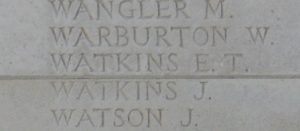
William John Watkins, Private, 17968, South Wales Borderers. William was born in 1884, the son of Thomas Watkins and Mary Ann Watkins (nee Williams), of 48, Somerset Street, Brynmawr. He worked as a coal hewer prior to enlisting at Brynmawr into the 5th Battalion, South Wales Borderers. The battalion formed at Brecon in September 1914, before moving to Park House Camp, near Tidworth to join 58 Brigade, 19th (Western) Division. In December 1914 the battalion moved to Basingstoke in billets, then on 10 January 1915 became converted to the Pioneer Battalion for the 19th Division. The Division completed its training at Bulford and Perham Down, before embarking for France and landing at Le Havre on 16 July 1915. The entire 19th Division then moved to the Nursery Sector at Calonne for trench initiation alongside the Dehra Dun Brigade. The infantry battalions of the division then began carrying out the usual routines of rotating in the trenches: four days in the front line; four in support; and four in reserve, interspersed with training regimes and carrying out working parties and trench raids. Just south, the British launched a great offensive around the town of Loos on 25 September 1915, and the 19th Division was ordered to attack from its positions at the same time, to attempt to draw enemy attention away from the main battle area. The assault was a disaster, and heavy casualties were suffered by the 19th Division for no gain. The following year the Division moved to the Somme, where it took part in the second wave of the attack on Ovillers-La Boiselle on 1 July, capturing the village at heavy cost. It then fought through the Battle of Poziéres. William was wounded whilst the 5th SWB was at work around Mametz Wood at the end of July and was evacuated to hospital at Rouen, where he died of his wounds on 7 August 1916. The 32-year-old is buried in St. Sever Cemetery, Rouen, France.
Christopher James Weale, Private, 26582, South Wales Borderers. Christopher was born in 1893, the son of Christopher Weale and Elizabeth Weale (nee Gregory), of 7, George Street, Brynmawr. He left Brynmawr to become a Drapers assistant at Newport as a young man, then set up his own Drapery at Ebbw Vale prior to the war. Christopher enlisted at Ebbw Vale into the South Wales Borderers in the spring of 1915 and was drafted to Egypt early in 1916, joining the 4th Battalion, South Wales Borderers, which was attached to 40 Brigade, 13th (Western) Division. The division had been evacuated from Gallipoli to Mudros on 8 January 1916 before moving to Egypt, then on 15 February 1916 embarked at Suez, arriving at Basra on 4 March to join the forces being assembled to attempt to relieve the besieged garrison of Kut-al-Amara. Unfortunately, the relief failed, and Kut fell to the Turks. The Division then took part in the advance through Mesopotamia, which was to successfully liberate the country from 100’s of years of Ottoman rule. By 28 May 1918, Divisional HQ had moved to Dawalib, and it remained here until the end of the war, with many working parties being supplied for work on maintaining roads. On 18 October the 4th SWB left Kifri and began a march north towards Kirkuk, together with two artillery batteries and the 40th Brigade Machine Gun Corps. The column, known as Lewins Column, continued its march over the coming days in hard conditions and on 24 October 1918 the column came in contact with the enemy, who opened up an artillery barrage upon it. Christopher was killed during this advance to Kirkuk on 24 October 1918, the sole man killed that day. The 25-year-old has no known grave and is commemorated on the Basra Memorial, Iraq.
Arthur George Weaver, Private, 25542, South Wales Borderers. Arthur was born in 1881, the son of William George Weaver and Caroline Weaver (nee Watkins), of Shetton, Mansel Lacy, Hereford. He married Sibbynah Jones, a schoolteacher from Nantyglo, in 1911 and the couple set up home at 3, Osborne Road, Brynmawr. Arthur enlisted into the South Wales Borderers in the spring of 1915 and was posted to the 12th Battalion, South Wales Borderers. The battalion was raised at Newport by the Welsh National Executive Committee in March 1915 as a bantam Battalion, then in July 1915 moved to Prees Heath to join the Welsh Bantam Brigade. During September 1915 the Brigade moved to Aldershot and became 119 Brigade, in the 40th (Bantam) Division. In December 1915 the Division moved to Blackdown to complete its training before embarking for France and landing at Le Havre on 2 June 1916. The Division moved to positions around Lillers before taking over the North Maroc Sector, near Loos, for trench initiation and once acclimatised was left to hold the sector itself over the coming months. The infantry battalions of the Division then began the usual routines of rotating for duty in the trenches: normally four days in the front line; four in support and four in reserve. Late in 1916 the Division moved south to the Somme, and fought at the Battle of the Ancre, before remaining in the sector over the winter. In March 1917 the Germans withdrew to their shortened line, called the Hindenburg Line, and the 40th Division was among the units which followed the withdrawal. Later in the year the Division took part in the Battle of Cambrai and launched an attack on Bourlon Wood on 23 November 1917. The attack was carried out by 119 Brigade, led by the 12th SWB and 19th RWF. The 17th Welsh was in support for the initial assault, but was soon ordered to advance, to support the two attacking battalions. Heavy fighting raged within the wood over the coming days, with the 18th Welsh also being thrown forwards into the fight, and the Division suffered terribly. Arthur was badly wounded during the battle and was evacuated to a nearby Field Ambulance, where he died of his wounds on 26 November 1917. The 37-year-old is buried in Rocquigny-Equancourt Road British Cemetery, Manancourt, France. His brother, Frederick Weaver, was killed at Arras on 3 May 1917.
Joseph Webb, Private, 11523, South Wales Borderers. Joseph was born in 1895, the son of John Webb and Catherine Webb, of the Back of the Black Lion Inn, Brynmawr. The family moved to 84, Glandwr Street, Abertillery prior to the war, but Joseph left home as a young man to enlist at Brecon into the South Wales Borderers. Joseph embarked for France on 11 January 1915 and was posted to the 1st Battalion, South Wales Borderers, which was attached to 3 Brigade, 1st Division. The division had suffered terrible casualties during its vital actions during the defence of Ypres the previous weeks, and had just moved to new positions near Outtersteene to rebuild. On 20 December the now rebuilt 1st SWB left for Merris, before the 1st Division took up new positions in the line at Festubert, a wet marshy area. On Christmas Day the men were in the trenches, cold and wet, when they were presented with their Princess Mary gift tins, which contained cards and gifts on behalf of the Royal Family. The line was relatively quiet over this period, but the trenches were flooded and in a terrible state. On 4 January 1915 the 1st SWB were relieved and moved back to Bethune, where the men were allowed to bathe and received issues of clean clothes, before moving back into the Festubert trenches four days later. The battalion remained in the line here until 14 January when it relieved the Black Watch at Givenchy. At dawn on 25 January 1915 the Germans hit their lines with an intensive artillery bombardment, before launching an infantry assault, breaking through 100 yards of trench and reaching Givenchy village. Heavy fighting raged throughout the day as the Germans were driven back and the line regained. Over the coming weeks, the infantry battalions of the division rotated for duty in the front line, support, and reserve trenches, in horrendous conditions. Joseph was one of three men wounded during a routine spell in the front line at Richebourg on 19 April and was evacuated to No 3 Field Ambulance, where he died of his wounds on the following day, 20 April 1915. The 19-year-old is buried in Bethune Town Cemetery, France.
Henry Russell Weeks, Captain, Welsh Regiment. Henry was born in Brynmawr in 1895, the son of Alfred Weeks and Ada Florence Weeks (nee Williams). The family moved to 75, Connaught Road, Cardiff by 1901 and then to The Lawn, 6, St. Stephen’s Avenue, Ealing, London. Henry received his education firstly at Cardiff High School and then at Llandovery College, from 1908 until 1912. After leaving Llandovery, he entered University College, Cardiff, and he was a member of Radyr Golf Club, Cardiff. Henry enlisted in the Army at the outbreak of War, joining the University and Public Schools Battalion, Royal Fusiliers. In January 1915, he was commissioned into the Welsh Regiment, and was posted to its 12th Battalion, which was attached to 104 Brigade, 35th Division. In April the Battalion became a Training Reserve Battalion, and Henry was posted to another (unknown) Battalion of the Welsh, which was on the Western Front. Henry served in France for some 18 months before being wounded, and returned to England for treatment. Upon his recovery, he was promoted Captain, and posted to the 1st Battalion, Welsh Regiment, which was attached to 84 Brigade, 28th Division. The Battalion was in Salonika, and Henry arrived at Salonika in the June of 1918. On 18 September 1918 Henry took part in the British advance against the Bulgarians in the Struma Valley, where he was severely wounded. Henry died of his wounds on 23 September 1918. The 24-year-old was buried in Doiran Military Cemetery, Greece. His brother Herbert also died during the Great War. Neither man is commemorated on the Brynmawr Cenotaph.
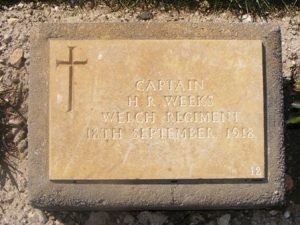
Herbert Ward Meredith Weeks, Lieutenant, South Wales Borderers. Herbert was born in Brynmawr in 1892, the son of Alfred Weeks and Ada Florence Weeks (nee Williams). The family moved to 75, Connaught Road, Cardiff by 1901 and then to The Lawn, 6, St. Stephen’s Avenue, Ealing, London. Herbert was educated at Cardiff High School and later at Llandovery College between 1907 and 1911. After leaving Llandovery, Herbert entered Queen’s College, Oxford, where he read Mathematics. In 1914 he is recorded as being Secretary of ‘The Cambrian’. On 23 February 1915 Herbert was commissioned into the 2nd Battalion South Wales Borderers, which was attached to 87 Brigade, 29th Division. The Division moved to Gallipoli via Egypt, landing on 25 April 1915. They remained here until evacuation to Egypt on 11 January 1916 and then moved to the Western Front on 15 March. The Division took part in its first major action in France during the 1916 Somme Offensive, and fought at the Battles of Albert and Le Transloy, suffering heavy casualties. In the Spring of 1917 they fought at the Battle of the Scarpe, which was part of the Arras Offensive, and then moved further north to Ypres. Here they fought at the Battle of Langemarck, and then at the Battles of the Menin Road, Polygon Wood, Broodseinde and Poelcapelle, before moving to Cambrai. During November 1917, Herbert was in command of ‘A’ Company of the 2nd Battalion during the Battle of Cambrai. On 23 November 1917 Herbert was badly wounded by enemy machine-gun fire during the advance to the Hindenburg Line, while crossing a river near Marcoing Lock. He died later that day from his wounds aged 25, and was buried in Tincourt New British Cemetery, France. His brother Henry also died during the Great War. Neither man is commemorated on the Brynmawr Cenotaph.
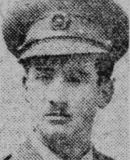
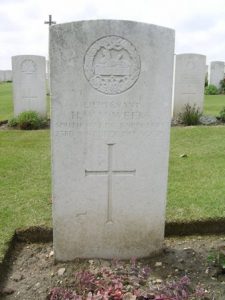
Robert Percival Weeks, Private, 3949, Australian Infantry. Robert was born in 1890, the son of William Weeks and Jane Weeks (nee Rees), of 49, Bailey Street, Brynmawr. His mother died when he was just five years old and his father remarried to Jane Ann Samuel. Robert was educated at Brynmawr County School and at Monkton School at Cardiff prior to emigrating to Australia, where he found work as a cattle dealer and meat salesman at Sydney. He enlisted at Holdsworthy, New South Wales into the 9th Reinforcement Draft for the 19th Battalion, Australian Infantry on 26 October 1915 and embarked at Sydney with the draft aboard HMAT Runic on 20 January 1916. The ship formed part of a convoy which sailed through the Suez Canal for Alexandria, where the men joined the 19th Battalion. The battalion then spent several weeks training and reorganising before embarking for Marseilles on 18 March, then entrained for Northern France as part of the 5th Brigade, 2nd Australian Division. The division carried out a period in the line in the Fleurbaix sector before moving south in July to take part in the Somme offensive. The 2nd Division saw its first major offensive around Pozieres between late July and the end of August 1916, before the Australians were relieved and moved back to Flanders. After a spell in a quieter sector of the front in Belgium, the 2nd Division came south again in October and the 19th Battalion attacked near Flers between 14 and 16 November, in conditions described as the worst ever encountered by the AIF during the entire war. In 1917, the 19th Battalion took part in the great advance which followed the German withdrawal to the Hindenburg Line, and was one of four battalions to defeat a counter-attack by the Germans at Lagnicourt. The 2nd Division then took part in the bloody Battle of Bullecourt in May 1917 before the Australians moved north into the Ypres Salient later that summer, to join the great push for Passchendaele Ridge. The 2nd Division moved into the line north of the Menin Road and on 20 September 1917 launched an assault along an 8-mile front, together with ten other divisions. The 2nd Division advanced over 1,000 yards and had just attained its objectives when Robert was blown up with a shell, together with several of his comrades. The 27-year-old has no known grave and is commemorated on the Ypres (Menin Gate) Memorial, Belgium. Two of his cousins, the brothers Herbert Ward Meredith Weeks and Henry Russell Weeks, both born in Brynmawr, were also killed during the war. Both men are commemorated on the Llandovery College war memorial, but not on the Brynmawr Cenotaph.
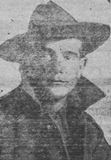
Sydney Weir, Private, 10258, Australian Army Medical Corps. Sydney was born in Brynmawr in 1876, the son of Robert Weir and Agnes Margaret Weir (nee Swain). His father was a Draper, originally from Ayrshire, and his mother was from an old Brynmawr family. In October 1878 the family embarked at London to start a new life in Australia, settling at Black Hill, Ballarat. Sydney became a schoolteacher at Ballarat after leaving school himself. He married Alice Mary Gibson in about 1908 and in 1910 the couple had a daughter, Elaine. Alice tragically died on 19 March 1915, and on 29 December Sydney left his post at Ballarat to enlist at Brownhill into the Australian Army Medical Corps, leaving his daughter with his elderly parents. He was posted to Blackboy Hill for training prior to embarking aboard HMAT Shropshire on 31 March 1916 as part of the 1st Reinforcement draft for the Al Hayat Convalescent Depot in Egypt. Once he arrived in Alexandria, he joined the 12th Field Ambulance and embarked for France on 4 June 1916, before disembarking at Marseilles seven days later, entraining for Northern France to join the Australian Corps, which was by now on the Somme. The 12th Australian Field Ambulance then set up at Vadencourt, to receive casualties from the planned assault on the village of Pozieres. The assault began at dawn on 23 July 1916 when the 1st Australian Division assaulted the village in conjunction with assaults by the British 1st and 48th Divisions. Pozieres was captured within the day, at heavy cost, then was counter-attacked by the Germans, causing terrible casualties. Fighting raged for weeks as the Australians began to press towards the strongly defended ruins of Mouquet Farm, to the north. Sydney was recommended for a gallantry award for his coolness in collecting and rescuing wounded men under heavy fire during the early fighting for Mouquet Farm, but the award was never granted. On 3 September 1916 Sydney was going forward to the Aid Post at the Quarry next to Mouquet Farm when he was shot through the heart by a German sniper and instantly killed. The 40-year-old was carried away by his comrades and was buried in a small battlefield cemetery near Mouquet Farm, some 500 yards WNW of Contalmaison and 3 ½ miles ENE of Albert, but his grave was lost during further fighting in the area and he is today commemorated on the Villers-Bretonneux Memorial, France. Sydney is not commemorated on the Brynmawr Cenotaph.
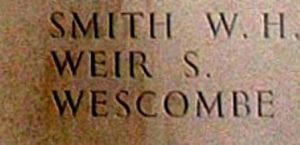
Alfred Werrett, Private, 2344, Monmouthshire Regiment. Alfred was born in 1895, the son of George Werrett and Mary Ann Werrett (nee Firmston), of The Back of the Black Lion Inn, Brynmawr. He worked as a coal miner prior to enlisting at Abergavenny into the 3rd Battalion, Monmouthshire Regiment. The battalion mobilised at Abergavenny attached to the Welsh Border Brigade, Welsh Division, before moving to Pembroke Dock. On 10 August 1914 the Division moved to Oswestry before moving to Northampton, then spent Christmas at Bury St. Edmunds before moving to Cambridge. In February 1915 the 3rd Monmouth’s left the Welsh Division and landed in France on 14 February, before moving to the Ypres Salient. On 3 March 1915 the battalion joined 83 Brigade, 28th Division. On 8 April the 3rd Monmouth’s relieved a French Division in the sector east of the Polygon Wood to begin its first tour in the trenches. The battalion was relieved four days later, and marched to billets in Ypres, then on 17 April relieved the 5th King’s Own in the front line, to begin a spell which would last for 17 days without relief. On 22 April, just to the north, the Germans launched the first gas attack of the war upon French Colonial troops at Gravenstafel, heralding the opening of the Second Battle of Ypres. The main fighting remained to the north of Polygon Wood for now, but Alfred was killed near Polygon Wood on 2 May 1915 as the battalion was carrying trench stores back to the rear, in readiness for a planned withdrawal. The 21-year-old has no known grave and is commemorated on the Ypres (Menin Gate) Memorial, Belgium.
William John White, Private, 6521, King’s Shropshire Light Infantry. William was born in 1896, the son of William White and Elizabeth Ann White (nee Thomas). His mother was from Brynmawr, but after marrying his father, the family had moved to 9, Humphrey’s Houses, Nantyglo. William had enlisted at Hereford into the King’s Shropshire Light Infantry as a young man, and was a Special Reservist when war erupted. He was mobilised following the outbreak of war and was posted to Winchester to join D Company of the 2nd Battalion, King’s Shropshire Light Infantry, which had just returned from India. The battalion joined 80 Brigade, 27th Division at Winchester and on 21 December 1914 embarked for France, landing at Le Havre. The division then entrained for the Aire area, before moving to Blaringhem, where Christmas was celebrated. The division then proceeded via Strazeele to Voormezeele, taking over the trenches in front of the village by 9 January 1915. The infantry battalions of the division then began to rotate for duty in the front line, support and reserve trenches, from their billets at Dickebusch, until the end of February, when the Division moved to the St. Eloi Sector to take part in a counter-attack following a German assault on the sector which had seen the 28th Division suffer heavy losses. Following the fighting, the 2nd KSLI moved to new billets at Ypres, as the 27th Division had taken over positions at Polygon Wood. On 22 April, just to the north, the Germans launched the first gas attack of the war upon French Colonial troops at Gravenstafel, heralding the opening of the Second Battle of Ypres. Fighting raged to the north of Polygon Wood, but by 3 May the British began to withdraw to better positions and the 2nd KSLI moved into reserve at Bellewaarde Wood. William was killed in action here on 5 May 1915 when the wood was heavily bombarded with German gas shells. The 19-year-old has no known grave and is commemorated on the Ypres (Menin Gate) Memorial, Belgium.
Alfred Aaron Williams, Private, 11443, South Wales Borderers. Alfred was born in 1896, the son of John Aaron Williams and Sarah Ann Williams (nee Owen), of Hope Cottage, King Street, Brynmawr. He worked as a coal hewer prior to enlisting at Brecon into the South Wales Borderers soon after the outbreak of war. Alfred embarked for France on 13 November 1914 and joined the 1st Battalion, South Wales Borderers, which was attached to 3 Brigade, 1st Division. The division had suffered terrible casualties during its vital actions during the defence of Ypres the previous weeks, and had just moved to new positions near Outtersteene to rebuild. On 20 December the now rebuilt 1st SWB left for Merris, before the 1st Division took up new positions in the line at Festubert, a wet marshy area. On Christmas Day the men were in the trenches, cold and wet, when they were presented with their Princess Mary gift tins, which contained cards and gifts on behalf of the Royal Family. The line was relatively quiet over this period, but the trenches were flooded and in a terrible state. On 4 January 1915 the 1st SWB were relieved and moved back to Bethune, where the men were allowed to bathe and received issues of clean clothes, before moving back into the Festubert trenches four days later. The battalion remained in the line here until 14 January when it relieved the Black Watch at Givenchy. At dawn on 25 January 1915 the Germans hit their lines with an intensive artillery bombardment, before launching an infantry assault, breaking through 100 yards of trench and reaching Givenchy village. Heavy fighting raged throughout the day as the Germans were driven back and the line regained. A relatively quiet spell then followed, before the 1st Division took part in the Battle of Aubers Ridge on 9 May 1915, when it attacked alongside the Meerut Division. The attack of 3 Brigade was held up by a flooded ditch, which the men forded, before being hit by heavy machine-gun fire, and a large number of casualties were suffered before the survivors withdrew. After the battle of Aubers, the Division took over a section of old French trenches, where it received drafts of reinforcements. On 20 May, the Division was moved to the Cuinchy area, where it endured a great deal of bombing and rifle grenading, in a very hostile sector. The 1st SWB had enjoyed a brief rest in billets at Bethune at the beginning of June, then on 16 June 1915 relieved the 2nd Welsh in the line near Beuvry. Alfred was killed in action just after the relief that day. The 19-year-old is buried in Cambrin Military Cemetery, France. His brother, Joseph Williams, was killed nearby at Loos, just three months later.
Daniel Williams, Private, 2338, Monmouthshire Regiment. Daniel was born in 1893, the son of Alfred Williams and Bridget Williams (nee O’Connell), of 24, Worcester Street, Brynmawr. He worked as a collier at the Stones Slope Colliery at Nantyglo prior to the war. Daniel enlisted at Abergavenny into the 3rd Battalion, Monmouthshire Regiment on 14 September 1914. The battalion mobilised at Abergavenny attached to the Welsh Border Brigade, Welsh Division, before moving to Pembroke Dock. On 10 August 1914 the Division moved to Oswestry before moving to Northampton, then spent Christmas at Bury St. Edmunds before moving to Cambridge. In February 1915 the 3rd Monmouth’s left the Welsh Division and landed in France on 14 February, before moving to the Ypres Salient. On 3 March 1915 the battalion joined 83 Brigade, 28th Division. On 8 April the 3rd Monmouth’s relieved a French Division in the sector east of the Polygon Wood to begin its first tour in the trenches. The battalion was relieved four days later, and marched to billets in Ypres, then on 17 April relieved the 5th King’s Own in the front line, to begin a spell which would last for 17 days without relief. On 22 April, just to the north, the Germans launched the first gas attack of the war upon French Colonial troops at Gravenstafel, heralding the opening of the Second Battle of Ypres. The fighting remained to the north of Polygon Wood until 3 May, when the Germans widened their attacks and the Polygon Wood sector was evacuated by the 28th Division, which fell back on the G.H.Q. line at Potijze. Daniel had been killed on the previous day, 2 May 1915, whilst the 3rd Monmouth’s were carrying trench stores back from the trenches in anticipation of this evacuation. The 21-year-old has no known grave and is commemorated on the Ypres (Menin Gate) Memorial, Belgium.
David Jenkin Williams, Second Lieutenant, King’s Shropshire Light Infantry. David was born in 1890, the son of Reverend William Williams, Minister of Capel Sion, Pontygwaith, and of Elizabeth Williams, of 5, Llewellyn Street, Pontygwaith. He was educated at Pontygwaith and at Porth County School before obtaining his BA at Cardiff University. David then became a schoolteacher at Ystalyfera County School, before leaving to take up a position as assistant master at Brynmawr County School. He enlisted into the Inns of Court Officer Training Corps and was commissioned from the OTC as Second Lieutenant into the 1st Battalion, Monmouthshire Regiment in 1916. David embarked for France on 11 January 1917 and was posted to the 6th Battalion, King’s Shropshire Light Infantry, which was attached to 60 Brigade, 20th (Light) Division. The division was on the Somme, holding the line in the Morval sector, when David arrived. On the night of 13 March the Germans evacuated their trenches in front of the division, and began their withdrawal to the Hindenburg Line, so the 20th Division was among the units which followed the withdrawal. The advance ended around Havrincourt Wood, where the 20th Division settled into new positions facing the Hindenburg Line and on the following month launched several assaults, as part of the Battle of Arras. The division remained here until the middle of June when it was relieved and began moving north into the Ypres Salient. The 20th Division was in support to the 38th (Welsh) Division when the Passchendaele offensive opened on 31 July 1917 and on 6 August relieved the battered Welshmen in their new positions facing Langemarck. On 16 August the 20th Division assaulted the village, successfully capturing the ruined village whilst under ferocious artillery fire. The 6th KSLI withdrew to camp at Proven after the assault and had a brief rest before returning to the action around Langemarck. On the morning of 20 September 1917 the 6th KSLI launched an assault against Eagle Trench from its new positions at Langemarck, but upon reaching White Trench were beaten back by a German counter-attack. David was badly wounded during the initial fighting and was evacuated back to a nearby Field Ambulance where he died of his wounds that same day. The 27-year-old is buried in Cement House Cemetery, Belgium.
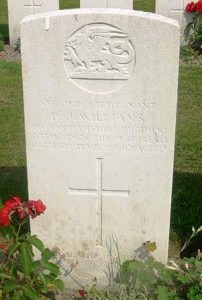
Williams, J. J., Lance Corporal, Monmouthshire Regiment. This man cannot presently be identified. His name is an addition to the cenotaph.
Joseph Aaron Williams, Private, 11385, South Wales Borderers. Joseph was born in 1894, the son of John Aaron Williams and Sarah Ann Williams (nee Owen), of Hope Cottage, King Street, Brynmawr. He worked as a coal hewer prior to enlisting at Brecon into the South Wales Borderers soon after the outbreak of war. Joseph embarked for France on 26 January 1915 and joined the 1st Battalion, South Wales Borderers, which was attached to 3 Brigade, 1st Division. The division was holding a sector of the line near Givenchy when Joseph arrived, joining his brother, Alfred who had been with the battalion for two months. A relatively quiet spell then followed, before the 1st Division took part in the Battle of Aubers Ridge on 9 May 1915, when it attacked alongside the Meerut Division. The attack of 3 Brigade was held up by a flooded ditch, which the men forded, before being hit by heavy machine-gun fire, and a large number of casualties were suffered before the survivors withdrew. After the battle of Aubers, the Division took over a section of old French trenches, where it received drafts of reinforcements. On 20 May, the division was moved to the Cuinchy area, where it endured a great deal of bombing and rifle grenading, then at the latter end of June it moved to the Vermelles area, in preparation for the battle of Loos. The Battle of Loos was launched on 25 September 1915, following the release of large quantities of poison gas by the British. 3 Brigade moved off with the 2nd Munster’s on the right, the 2nd Welsh in echelon, to their left, and the 1st SWB in support. The gas had blown back over the British lines, so conditions during the advance were horrendous, then whilst advancing past the Vermelles-Hulluch Road the Brigade came under heavy machine-gun fire. Joseph was killed in action during the assault that day. The 22-year-old has no known grave and is commemorated on the Loos Memorial, France. His brother, Alfred Aaron Williams, had been killed nearby just three months previously.
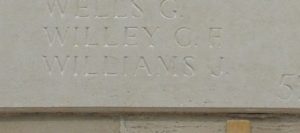
Joseph Wills, Private, 2072, Welsh Guards. Joseph was born in 1884, the son of John Wills and Jane Wills (nee Jones), of Six Bells. By 1901 the family had moved to the Rock and Fountain Inn, 84, Worcester Street, Brynmawr, where Jane was the Innkeeper. Joseph found work as a coal hewer, and in 1904 married Polly Havard. The couple then settled at 22, Clarence Street, Brynmawr, where three daughters were born over the coming years. Joseph enlisted at Brynmawr into the Welsh Guards in the spring of 1915. The Regiment had been raised by Royal Warrant of 26 February 1915, at White City, before landing at Le Havre on 18 August 1915, becoming attached to 3rd Guards Brigade, Guards Division. The Division saw its first major action during the Battle of Loos, which began on 25 September 1915, before also taking part in the Action of the Hohenzollern Redoubt. The Division had a brief rest in the Calais area, before moving to the Ypres Salient, and held the line at Potijze for several months. At the end of July 1916, the Division withdrew from Ypres and moved to the Somme, before holding the line north of the Ancre for a short period. By 25 August the Guards Division had moved slightly south, and had marched passed Corbie, to Mericourt-L’Abbe. By 9 September the Guards had passed Ginchy, and moved into positions at Guillemont, prior to taking part in the Battle of Flers-Courcelette, the first-time tanks were ever used in action. The battle began on 15 September and the Guards Division attacked behind three tanks, reaching the Ginchy to Lesbœufs road before the tanks either broke down or became bogged down. The Welsh Guards, in reserve, joined the fray on the following day, suffering heavy casualties during its assault on Lesbœufs. The battalion was relieved that night and had a short rest in bivouacs at Trônes Wood before returning into the line during the evening of 22 September 1916, relieving the 4th Grenadier Guards. Joseph was killed in action during the relief that night. The 31-year-old has no known grave and is commemorated on the Thiepval Memorial, France.
Albert Wilson, Private, 14788, South Wales Borderers. Albert was born in 1890, the son of John Wilson and Pamela Jane Wilson (nee Price), of 108, King’s Street, Beaufort. By 1911 he was living with his elder brother, John Henry Wilson, and his family at 48, Somerset Street, Brynmawr and was working as a coal hewer for the Ebbw Vale Company. Albert had served with the 1st Volunteer Battalion, South Wales Borderers as a young man, then enlisted into the Brecknockshire Battalion, South Wales Borderers, a Territorial Army unit, on 4 May 1908, and had attended every annual TA summer camp over the coming years: at Brecon; Porthcawl; Aberystwyth; Haverfordwest and Hereford. As a result, he was a member of the Special Reserve and was mobilised at the outbreak of war, joining the South Wales Borderers at Brecon. Albert was drafted out to the Mediterranean in May 1915 and landed at Gallipoli on 25 May 1915, joining the 2nd Battalion, South Wales Borderers, which was attached to 87 Brigade, 29th Division. The battalion was holding Turkey Trench, in Gully Ravine, in the Helles Sector when Albert arrived and had taken part in the original landings at Cape Helles on 25 April. Gully Ravine led up to Geoghegan’s Bluff, with Turkey Trench branching off to the east and was a particularly hostile sector. On 28 June 1915 the battalion supported an assault by the Border Regiment against Boomerang Trench, advancing through a hail of shrapnel, taking their objectives before digging in. Albert was killed in action during the fighting that day. The 25-year-old has no known grave and is commemorated on the Helles Memorial, Gallipoli. His brother, John Henry Wilson, died in France in April 1916.
George William Wilson, Private, 39397, South Wales Borderers. George was born in Kingsland, London on 30 August 1895, the son of Thomas Walter Wilson and Elizabeth Jane Wilson (nee Glover). His father died in 1900, so George and his siblings were sent away within the coming years, and by 1911 George was lodging with Mary Jane Lawrence, at 41, Church Street, Blaina, where he worked as an assistant boot repairer. He then moved to Brynmawr, where he remained until enlisting at Abertillery into the Monmouthshire Regiment in the spring of 1915. George was drafted to France in the spring of 1916, joining the 5th Battalion, South Wales Borderers, which was the Pioneer Battalion for the 19th Division. The Division completed its training at Bulford and Perham Down, before embarking for France and landing at Le Havre on 16 July 1915. The entire 19th Division then moved to the Nursery Sector at Calonne for trench initiation alongside the Dehra Dun Brigade. The infantry battalions of the division then began carrying out the usual routines of rotating in the trenches: four days in the front line; four in support; and four in reserve, interspersed with training regimes and carrying out working parties and trench raids. Just south, the British launched a great offensive around the town of Loos on 25 September 1915, and the 19th Division was ordered to attack from its positions at the same time, to attempt to draw enemy attention away from the main battle area. The assault was a disaster, and heavy casualties were suffered by the 19th Division for no gain. The following year the Division moved to the Somme, where it took part in the second wave of the attack on Ovillers-La Boiselle on 1 July, capturing the village at heavy cost. It then fought through the Somme Battles of Pozieres and the Ancre in 1916, wintering on the Somme, in terrible conditions. The 5th SWB were worked hard during this period, repairing roads, tracks and trenches in the Hébuterne Sector, as well as laying light railway tracks. George was badly wounded whilst at work in this area and died of his wounds that same day, on 16 February 1917. The 22-year-old is buried in Varennes Military Cemetery, France.
John Henry Wilson, Private, 14919, South Wales Borderers. John was born in 1882, the son of John Wilson and Pamela Jane Wilson (nee Price), of 108, King’s Street, Beaufort. He married Emma Rosina Sage in 1902 and the couple set up home at 48, Somerset Street, Brynmawr. John worked as a coal hewer for the Ebbw Vale Company prior to the war. Like his younger brother, Albert, John had served with the 1st Volunteer Battalion, South Wales Borderers as a young man, then enlisted into the Brecknockshire Battalion, South Wales Borderers, a Territorial Army unit, on 4 May 1908, and had attended every annual TA summer camp over the coming years: at Brecon; Porthcawl; Aberystwyth; Haverfordwest and Hereford. As a result, he was a member of the Special Reserve and was mobilised at the outbreak of war, joining the South Wales Borderers at Brecon. He was drafted to the Mediterranean in the summer of 1915, joining the 2nd Battalion, South Wales Borderers, which was attached to 87 Brigade, 29th Division, and was holding positions at Turkey Trench, part of the Geoghegan’s Bluff sector of trenches. Despite several large scale offensives, the invasion forces failed to break the Turkish defences and the campaign became bogged down, so after an arduous eight months on the Peninsula the 29th Division was evacuated to Egypt on 11 January 1916, before being transferred to the Western Front, landing at Marseilles on 15 March and entraining for the Somme sector, taking up positions near Beaumont Hamel, facing Y-Ravine. John took ill whilst aboard ship, so never left Marseilles, as he was taken to the hospital there for treatment when the battalion disembarked. He died in hospital of catarrh on 3 April 1916. The 34-year-old was buried in Mazargues War Cemetery, Marseilles, France. His brother, Albert, had been killed at Gallipoli just prior to John joining the 2nd SWB there.
World War Two, 1939-1945
Thomas Oswald Baker, Private, 3911178, Monmouthshire Regiment. Thomas was born on 7 September 1915, the son of Gabriel Thomas Baker and Ethel Jane Baker (nee Davies), of 202, King Street, Brynmawr. His father had served with the South Wales Borderers during the Great War but was killed during a coal mining accident in 1929. Thomas worked as a labourer in a steel rolling mill prior to enlisting into the 2nd Battalion, Monmouthshire Regiment after the outbreak of war. The battalion, a Territorial Army unit, was mobilised for war as part of the 53rd (Welsh) Division and moved to Northern Ireland to begin garrison duties. The Division then moved to Pembroke Dock, before moving again to the south of England, where it trained in readiness for the D-Day Landings. At the end of June 1944, the division left England for Normandy, and landed at La Riviere near Ver Sur Mer. The 2nd Monmouth’s moved into battle positions near the river Odon by 30 June 1944 and came under artillery fire almost immediately upon their arrival. Thomas was killed in action during that first day in the line. The 28-year-old was originally buried on the battlefield, near Les Saulletts, but in June 1945 his grave was exhumed, and he was re-interred in Ryes War Cemetery, Bazenville, France.
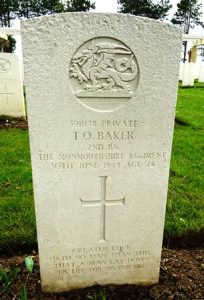
Arthur John Ballinger, Leading Aircraftman, 539653, Royal Air Force. Arthur was born in 1920, the son of Arthur Ballinger and Mary Elizabeth Ballinger (nee Jones), of Brynmawr. His father died in 1919, so his mother had to raise their two surviving children alone. Arthur enlisted into the Royal Air Force soon after the outbreak of war and at the end of June 1941 embarked at Gourock aboard the requisitioned troopship HMT Anselm for Freetown, together with some 1210 RAF personnel. On 5 July 1941, Anselm, sailing with five other ships, was spotted by the German submarine U-96 some 300 miles north of the Azores, which fired a spread of torpedoes at the convoy, two of which struck Anselm. The ship sank within 22 minutes, with the loss of some 254 lives. Arthur was 21 years old when he was drowned in the sinking that day and is commemorated on the Runnymede Memorial, Surrey.
Frederick William Barnes, Engineman, LT/KX 110465, Royal Naval Patrol Service. Frederick was born in Canning Town, Essex on 16 March 1911, the son of John Richard Barnes and Louisa Jane Barnes (nee Ford). He married Susan Ellis at Poplar on 25 December 1933. Frederick was already a member of the Royal Naval Reserve when war broke out and upon being mobilised, was posted to the Royal Naval Patrol Service, at Lowestoft. He was posted aboard HM Trawler Bedfordshire, a requisitioned trawler which had been converted for anti-submarine duties. Following her conversion in December 1940, Bedfordshire undertook anti-submarine patrols and escort duty off the southwest coast of England and in the Bristol Channel, but following the Japanese attack on Pearl Harbour on 11 December 1941, Bedfordshire was among 24 converted trawlers that crossed the Atlantic to be loaned to the US Navy. Bedfordshire then began anti-submarine patrols off the east coast of America, as part of the Fifth Naval District, headquartered at Naval Station Norfolk, she operated out of Morehead City, North Carolina. On 10 May 1942, Bedfordshire and HMT St Zeno departed Morehead City to escort a convoy to Hatteras, arriving safely just before midnight. During the night, Bedfordshire and HMT St Loman were dispatched from Morehead City to search for a U-boat believed to be in the vicinity of Ocracoke Island. The ships were spotted by the German submarine U-558, which fired a spread of torpedoes at them. The ships evaded the torpedoes and began to search for the U-Boat, but during the morning of 11 May 1942, Bedfordshire was torpedoed by the Germans and sank immediately with the loss of all 37 of her crew. Over the coming days and weeks, the bodies of most of the men were washed ashore and buried in what became known as the British Cemetery, at Ocracoke Island. Frederick, who was 31 years old when he was killed, was never identified from the bodies recovered, so is commemorated on the Lowestoft Naval Memorial, Suffolk. Following his death, his widow Susan moved to Brynmawr to live and in 1942 she married Reginald George Albert Sleigh there. Frederick is not commemorated on the Brynmawr Cenotaph.
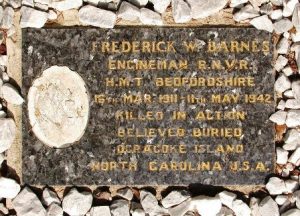
Albert William Booth, Sergeant, 1424526, Royal Air Force Volunteer Reserve. Albert was born in 1913, the son of Richard Booth and Beatrice Booth (nee Saunders), of Brynmawr. He enlisted into the Royal Air Force Volunteer Reserve and trained as an Air Gunner, before being posted to 10 Squadron, Royal Air Force, which was a heavy bomber unit, based at RAF Melbourne, in Yorkshire. On the night of 28 June 1943, Albert took off from Melbourne aboard a Handley Page Halifax II, Serial HR697, which joined a large bomber force of some 608 aircraft sent to hit targets in Cologne. Conditions were not ideal for carpet bombing, with low cloud masking the targets, but despite this, the main force delivered Cologne’s worst attack of the war with 43 industrial, six military and 6,368 other buildings completely destroyed, while the cathedral was seriously damaged, and many lives were lost. Albert was killed when his Halifax was shot down by a night-fighter on the morning of 29 June 1943 and crashed between Kaberg and Maastricht, Holland, with the loss of all seven of her crew. Albert was 20 years old when he was killed that morning and was buried besides his fellow crewmen in Venlo Military Cemetery. In November 1947 their graves were exhumed, and the seven men were buried together in Jonkerbos War Cemetery, Netherlands. His uncle, Joseph Booth, of Brynmawr, had been killed in France during the Great War.
George Bunn, Private, 3957679, Welch Regiment. George was born in 1913, the son of James Bunn and Elsie Gladys Bunn (nee Mills), of 28, King Street, Brynmawr. His father served throughout the Great War with the Brecknocks, whilst his brother Richard was killed whilst working at a colliery in Tredegar in 1925. George enlisted into the army and was posted to the 5th Battalion, Welch Regiment. The battalion was the Glamorgan Territorial Army infantry battalion and was attached to the 160th Brigade, 53rd (Welsh) Division. The battalion was mobilised at the outbreak of war, when the Division moved to Northern Ireland to begin garrison duties. The Division then moved to Pembroke Dock, before moving again to the south of England, where it trained in readiness for the D-Day Landings. On 24 June 1944 the 5th Welch embarked at Newhaven and sailed for Normandy, landing on Jig Beach at La Riviere near Ver Sur Mer and the 5th Welch assembled near the village of Subles by 28 June, resting on the following day before entering the battle for Normandy. The 5th Welch moved forward to Bronay on 30 June 1944, taking up positions facing the Germans. George was killed during the day. The 31-year-old was originally buried near Colleville, but in October 1945 the war graves in the area were exhumed and re-interred in St. Manvieu War Cemetery, Cheux, France.
Ronald Carpenter, Lieutenant, 315019, South Staffordshire Regiment. Ronald was born in 1919, the son of Charles Carpenter and Mary Ann Carpenter (nee Harris), of 12, Brynmill Terrace, Swansea. He married Dorothy Jean Powell in Swansea in 1943. Ronald had enlisted into the army soon after the outbreak of war and was commissioned as Second Lieutenant into the South Staffordshire Regiment in May 1944. Ronald was then posted to the Far East to join the 6th Battalion, South Wales Borderers. The battalion was taking part in the arduous campaign in Burma, and by the time that Ronald arrived, the Japanese army was in retreat and the monsoon season had hit. Ronald must either have been taken ill or wounded towards the end of the monsoon season, as he died in Gauhati, India on 29 October 1944. The 25-year-old is buried in Gauhati War Cemetery, India. Ronald is not commemorated on the Brynmawr Cenotaph, although his widow, Dorothy, lived there.
John Idris Cheese, Serjeant, 7917480, Royal Tank Regiment. John was born in 1910, the son of James Cheese and Hannah Cheese (nee Williams), of 9, Chapel Road, Nantyglo. The family later resided at 6, Greenland Road, Brynmawr. John enlisted into the army soon after the outbreak of war and was posted to the Royal Armoured Corps. He married Joan Walkling, of Wool, in Dorset on 3 December 1939, whilst based at Salisbury Plain. John was then posted to the 50th Royal Tank Regiment, RAC, which joined the 23rd Armoured Brigade upon its formation in November 1940, before embarking for North Africa in July 1942. The Eighth Army was regrouping when the 50th Royal Tank Regiment arrived in Egypt, then Bernard Montgomery took command before the Germans launched an offensive, the Battle of Alam el Halfa, south of El Alamein, on 30 August. Rommel attacked to the south of the Allies minefields, in an attempt to encircle the British at El Alamein, but Montgomery had received Ultra intelligence of the offensive and was ready. John was killed in action when his tank got destroyed towards the end of the battle, on 4 September 1942. The 31-year-old was originally buried with the remains of his fellow crewmen, and those of another tank crew, on the battlefield, but in August 1943 their graves were exhumed, and the men were re-interred in El Alamein War Cemetery, Egypt.
William James Cheese, Corporal, 3910622, Durham Light Infantry. William was born on 20 May 1918, the son of John Henry Cheese and Mary Elizabeth Cheese (nee Allen), of 6, Greenland Road, Brynmawr. His mother died in 1924, and his father remarried to Frances. William married Alma Alice Bourton of Ebbw Vale in 1943. He had already enlisted into the army and was serving with the 9th Battalion, Durham Light Infantry. The battalion was attached to the 151st Brigade, 50th (Northumbrian) Infantry Division and had been in France with the BEF in 1940, before being evacuated from Dunkirk. It then remained in Britain until embarking for North Africa in June 1941, taking part in the campaign in the Western Desert. In July 1943 the division took part in the landings in Sicily and later fought at Salerno, before returning to Britain to prepare for the invasion of occupied Europe, landing on D-Day, 6 June 1944. The division then took part in the heavy fighting for Normandy and following the break-out, took part in the great advance through Northern France into Belgium and Holland. The 9th Durham Light Infantry then transferred to the 131st Brigade of the 7th Armoured Division in December 1944. In January 1945 the division, with the 8th Armoured and 155th Infantry Brigades, took part in Operation Blackcock to clear the Roer Triangle. William was killed during heavy fighting near Montfort on 18 January 1945. The 26-year-old was originally buried on the battlefield near Buchten, but in February 1947 the war graves in the area were exhumed and re-interred in Nederweert War Cemetery, Netherlands.
Owen Commins, Stoker 1st Class, C/KX 526285, Royal Navy. Owen was born on 16 March 1925, the son of Augustine Patrick Commins and Florence Beatrice Commins (nee Page), of 44, Warwick Road, Brynmawr. He enlisted into the Royal Navy as soon as he turned eighteen and served towards the end of the war. After the Armistice, Owen remained in the Royal Navy and was based in the Indian Ocean aboard HM Landing Craft Tank (LCT) 7020. On 17 October 1945 Owen was aboard HM LCT 7020 when she capsized and sank in the Indian Ocean, with the loss of thirteen lives. The 20-year-old has no known grave and is commemorated on the Chatham Naval Memorial, Kent.
Thomas George Craddock, Gunner, 1492336, Royal Artillery. Thomas was born on 27 June 1918, the son of Harry Craddock and Alice Edith Craddock (nee Hoffman), of 10, Croesyceiliog, Nantyglo. His father had served during the Great War and died on 7 November 1921 as a result of sickness contracted during the conflict. The family then moved to 24, King Street, Brynmawr, near Alice’s parents. Thomas worked as a lorry driver prior to the war, then enlisted into the Royal Artillery. He was posted to Kinmel Park to join the 217th Training Unit, Royal Artillery soon after the outbreak of war, before embarking for the Far East to join the 8th Coast Regiment, Royal Artillery, which formed part of the Hong Kong Defences. The regiment was based at Stanley Barracks and operated three Mark VII 9.2-inch coastal defence guns. On the same morning as the attack on Pearl Harbour on 7 December 1941, Japanese forces attacked the British colony of Hong Kong, without declaring war, in conjunction with assaults into Burma and Malaya. At 06.00 on 8 December, Hong Kong time, the Japanese attacked the colony, so the British blew a series of key bridges to stem their advance. Fighting raged over the coming days, until the garrison was forced to surrender to the Japanese on Christmas Day. Thomas was then taken into captivity, together with other survivors from the 8th Coast Regiment. On 27 September 1942, Thomas was among some 1,816 prisoners hoarded aboard the Japanese Hellship, SS Lisbon Maru at Hong Kong, to be shipped to work camps in Shanghai. On 1 October 1942, Lisbon Maru was steaming six miles from Tung Fusham Island, off the China coast when she was torpedoed by the American submarine USS Grouper, whose captain thought he was attacking a Japanese troopship. Lisbon Maru was seriously crippled and taking water, so was put in tow by a Japanese destroyer. The prisoners rebelled against their captors the following day, but many were machine-gunned and killed, whilst those trapped below decks drowned as the doomed ship sank, with the loss of 828 prisoners of war. Thomas was 24 years old when he died in the tragic sinking of Lisbon Maru. He has no known grave so is commemorated on the Sai Wan Memorial, China.
William Arnold Danter, Second Lieutenant, 154552, Royal Artillery. William was born at Neath on 11 April 1890, the son of John Samuel Danter and Louisa Danter (nee Lewis). He married Margaret Gwenland in 1910 and the couple had three children over the coming years. William enlisted into the Army Service Corps soon after the outbreak of the Great War and served overseas for over three years before being demobilised. He then became an auctioneer at Aberavon before training as a dentist and started his own practise in Brynmawr, moving with his family to 47, Worcester Street, Brynmawr. William volunteered to serve again following the outbreak of the Second World War and gained a commission as Second Lieutenant into the Royal Artillery. He was based in Hampshire during the early months of 1941, but was admitted to the Military Hospital at Basingstoke, where he died on 24 March 1941. The remains of the 50-year-old were conveyed back home, and he was buried in St. Mary Church Burial Ground, Brynmawr.
Joseph Emrys Davies, Private, 14640590, Worcestershire Regiment. Joseph was born in 1914, the son of Reuben Davies and Beatrice Davies (nee Woods), of 15, Well Street, Brynmawr. He left home as a young man to work as a carpenter in London and in 1936 married Emmie Elizabeth Dorothy Stone. The couple then set up home at 50A Goldsboro Road, Lambeth. Joseph enlisted into the army following the outbreak of war and was posted to the 1st Battalion, Worcestershire Regiment following its reformation from the 11th Worcester’s on 1 January 1943. The original battalion had been captured during the fall of Tobruk, necessitating this re-organisation. The reformed 1st Battalion transferred, in September 1943, to the 214th Infantry Brigade, 43rd (Wessex) Infantry Division, and began training in earnest for the forthcoming landings in occupied Europe. The 1st Worcester’s landed in Normandy, as part of Operation Overlord, on 24 June 1944, and took part in its first major action during Operation Epsom, the battle for the ground around the river Odon. The division then saw heavy fighting around Hill 112, and during the fighting for Mont Pinçon as part of Operation Bluecoat. The division then crossed the Noireau on 15 August by a broken railway bridge, before engineers from the division set up a Bailey bridge. Joseph was killed in action during the following day, 16 August 1944. The 30-year-old was originally buried on the battlefield near Berjou, but in January 1946 the war graves in the area were exhumed and re-interred in Banneville-La-Campagne War Cemetery, France.
William Edmund Davies, Gunner, 926615, Royal Artillery. William was born on 11 September 1914, the son of William Edmund Davies and Susannah Davies (nee Edwards), of 37, King Street, Brynmawr. He married Phyllis Pugh, of Brynmawr, in 1938. William enlisted into the Royal Artillery soon after the outbreak of war and was posted to the 8th Super Heavy Battery, Royal Artillery, a unit that was equipped with obsolete WW1 era 9.2” and larger guns. The battery played a vital role in guarding the British coast in case of a German invasion during the early stages of the war. William died on active service on 28 September 1941. The remains of the 27-year-old were brought home and he was buried in Brynmawr Cemetery.
Edwards, W G, Private. Royal Pioneer Corps. This man cannot presently be identified.
David Charles Evans, Driver, T/140293, Royal Army Service Corps. David was born on 9 March 1918, the son of Benjamin Charles Evans and Gertrude Evans (nee Lewis), of 98, Bailey Street, Brynmawr. He worked as a shop assistant for his father’s grocery business prior to the war. David enlisted into the Royal Army Service Corps and trained as a driver. David had not been in the army long when he died near Mansfield on 26 May 1940. The remains of the 22-year-old were brought home and he was buried in Brynmawr Cemetery.
Willy Oswald George, MBE, Major, 48261, Pioneer Corps. Willy was born in 1888, the son of John Evan George and Phoebe Ann George (nee Davies), of 9, Vaynor Villas, Vaynor. He was already serving with the 5th Battalion, Welsh Regiment, a Territorial Army battalion, when war erupted and embarked for Gallipoli with the battalion, serving as Company Sergeant Major, alongside his father who was the Company Quartermaster Sergeant with the battalion. Willy was commissioned as Second Lieutenant as soon as the battalion landed at Gallipoli but was wounded during the campaign and was evacuated back to Britain. He continued to serve for the duration of the war, reaching the rank of Major by the Armistice. He was awarded the MBE (Member of the British Empire) on 1 January 1919, in the New Year’s Honours List, for his services during the war and returned to civilian life afterwards, working as an electrical engineer. Willy had married Elsie May Williams, the daughter of Reverend John Williams, at Abercrave on 3 April 1918 and the couple then settled at Brynmawr. Following the outbreak of the Second World War, Willy volunteered his services again, but instead of re-joining the Welch Regiment, was granted a commission into the Pioneer Corps and was posted to Liverpool. He died at Liverpool on 14 December 1940. The 52-year-old was buried in St. Michael’s Churchyard, Huyton. Willy is not commemorated on the Brynmawr Cenotaph.
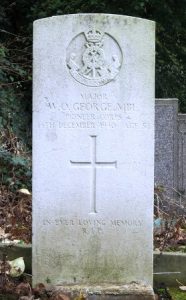
Tom Gould, Private, 14662367, South Staffordshire Regiment. Tom was born in 1925, the son of Thomas Gould and Blodwen Gould (nee Pritchard), of 4, Miles Row, Brynmawr. He enlisted into the army, joining the South Staffordshire Regiment and was selected for parachute training, before joining the 2nd (Airborne) Battalion, South Staffordshire Regiment. The battalion had begun the war as a normal infantry unit, but in 1941 was converted to a glider infantry role, becoming attached to the 1st Airlanding Brigade, 1st Airborne Division. The brigade landed in Sicily in 1943, suffering heavy casualties during the disastrous Operation Ladbroke, and then took part in Operation Slapstick, the invasion of mainland Italy. The brigade was then withdrawn to England to prepare for the invasion of France. The 1st Airborne Division did not take part in the D-Day landings, but began to prepare for a bold operation, code-named Market Garden, aimed at securing the crossings over the Rhine and ultimately shortening the war. By the end of August, the 2nd South Staffs were at RAF Brize Norton, ready to be airlifted to Holland. The operation was postponed twice over the coming days due to poor weather over the landing areas, then just after midday on 5 June 1944 the battalion began taking off for RAF Manston in their gliders. Here the men waited again, as further postponements followed, before finally the battalion left Manston aboard their gliders on the morning of 17 September, landing in open fields on the outskirts of Arnhem. On the following morning, the battalion carefully through Wolfhezen into Arnhem, to relieve the 1st Para Battalion at the Arnhem Bridge but became held up for a few hours north of Oosterbeek where they engaged the enemy. The battalion then became fragmented and on the following morning continued to move towards the bridge along the riverbank, before coming into contact with German tanks and a furious fight ensued before the battalion was forced to withdraw, suffering heavy casualties and began to pull back towards Oosterbeek Church. Tom was killed in action during further fighting near the Church on 21 September 1944. The 20-year-old was originally buried 50 yards south of the Church in Oosterbeek, together with two of his comrades, but in June 1946 their graves were exhumed, and the men were buried together in Arnhem Oosterbeek War Cemetery, Netherlands. The battalion had gained the award of the Victoria Cross to two of its members during the fighting around Arnhem.
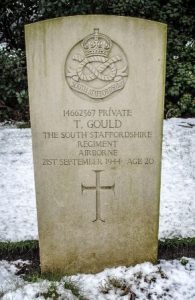
Alfred Henry Gregg, Sapper, 14234949, Royal Engineers. Alfred was born in 1922, the son of Alfred Gregg and Mary Ann Gregg (nee Weeks), of 15, Well Street, Brynmawr. He married Annie May Hale, of Nantyglo, in 1941. Alfred enlisted into the Royal Engineers and was posted to 1026 Docks Operating Company, Royal Engineers. Alfred landed with his company on the Normandy beaches at some time after D-Day, 6 June 1944 and would probably have worked on one of the vast manmade Mulberry Harbours, the pre-cast concrete casements which had been towed from the South coast and anchored off the Normandy beaches to be used as docks for the many troopships and supply vessels ferrying vital supplies and manpower to the fight. Alfred was killed in Normandy on 4 July 1944. The 22-year-old was originally buried at Asnelles-sur-Mer, but in December 1944 his grave was exhumed, and he was re-interred in Bayeux War Cemetery, France.
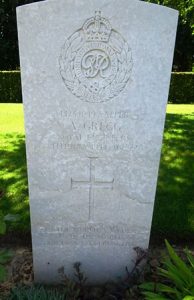
Bertram Beresford Griffiths, Private, 14513597, Cheshire Regiment. Bertram was born in 1924, the son of Isaac James Griffiths and Minnie Mary Griffiths (nee Cunvin), of 7, Somerset Street, Brynmawr. He enlisted into the army after his eighteenth birthday and was posted to the 1st Battalion, Cheshire Regiment. The battalion had taken part in the campaign in the Western Desert before returning to Britain to join the fight for occupied Europe and took part in the Rhine Crossings in 1945. The battalion remained in Germany as part of the BAOR after the war. Bertram remained in Germany with the battalion and died at the 29th (Hanover) British Military Hospital on 22 February 1947. The 22-year-old is buried in Hanover War Cemetery, Germany. Bertram is not commemorated on the Brynmawr Cenotaph.
Ronald Harding, Private, 3913695, South Wales Borderers. Ronald was born on 6 June 1911, the son of Moses Harding and Elizabeth Harding (nee Rhydderch), of 6, Cemetery Road, Brynmawr. His father was killed at Loos on 2 October 1915, so Ronald and his two siblings were raised solely by their mother. The family was residing at 1, Alma Street, Brynmawr by 1939 and Ronald was working as a builders labourer. He left home to enlist into the South Wales Borderers, but whilst on leave in 1940 married Annie Irene Denning, of Brynmawr. Ronald survived the war but died at Brynmawr on 7 October 1945. The 34-year-old is buried in Brynmawr Cemetery.
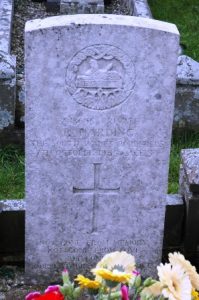
Frederick Charles Harris, Private, 3913532, South Wales Borderers. Frederick was born on 16 April 1911, the son of Ernest Harrys and Mary Elizabeth Harris (nee Player), of 64, Clydach Street, Brynmawr. He worked as a navvy prior to enlisting into the South Wales Borderers and was posted to the 6th Battalion, South Wales Borderers. The battalion was raised in Glanusk Park in July 1940 and trained as an infantry regiment until April 1942, when it became a tank unit, the 158th Regiment Royal Armoured Corps. The battalion sailed for Bombay in October 1942, then in March 1943 it was reconverted to infantry and trained as an amphibious assault unit. The battalion then moved to Calcutta to attack Akyab, but this move was cancelled, and the battalion was sent to Burma to fight in the Arakan. Once the battalion had moved into position it launched an assault on the Mayu Tunnels, two strategically important tunnels which carried the road and railway through the Mayu hills, taking part in ferocious hand to hand fighting over the course of two days, capturing both tunnels. By July 1944, the Japanese army in Burma was under intense pressure from the east by the 14th Army from Manipur, by an American and Chinese force in the north and by the Chinese from Yunan. On 4 July 1944, the 6th SWB was sent to Ledo to reinforce the American Chinese forces operating in North Burma and was flown to the Myitkina area before marching towards Mogaung, being supplied along the way by air. Once the battalion reached Mogaung, on the Myitkina-Mandalay-Rangoon Railway, it began a nine-month march along the railway. The battalions first encounter with the Japanese along the way came on the morning of 5 August 1944, when it attacked the village of Sahmaw Chaung. Frederick was killed in action during the ferocious fighting that day. The 33-year-old was originally buried in Sahmaw Christian War Cemetery, but in June 1954 the war graves in the cemetery were exhumed and re-interred in Taukkyan War Cemetery, Myanmar.
Alfred Francis Heley, Private, 3906591, Queen’s Own Royal West Kent Regiment. Alfred was born in 1905, the son of James Bevan Heley and Helen Heley. He married Elizabeth Olwen Jones at Brynmawr in 1938. Alfred enlisted into the Dorsetshire Regiment prior to the war, before being transferred to the 5th Battalion, Queen’s Own Royal West Kent Regiment, a Territorial Army unit. The battalion mobilised at the outbreak of war as part of the 132nd Infantry Brigade of the Home Counties Division and on 2 April 1940 moved to France to join the BEF. The Germans launched their Blitzkrieg on the low countries on 10 May 1940, with simultaneous invasions of Belgium, Luxembourg and the Netherlands, and the BEF was forced to withdraw towards the Channel Coast, to prevent being encircled. The 132nd Brigade withdrew towards the St Omer–La Bassée towards Dunkirk and saw heavy fighting here over the coming days. Alfred was killed at some time between 10 May and 23 June 1940. The35-year-old has no known grave and is commemorated on the Dunkirk Memorial, France.
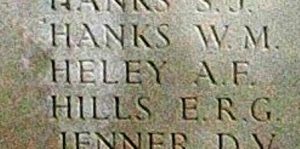
William James Highfield, Driver, 2324839, Royal Engineers. William was born in 1902, the son of George Highfield and Ada Highfield (nee White), of 17, Alma Street, Brynmawr. He married Doris Doreen Jones in Brynmawr in 1924, and the couple moved to Carpender’s Park, Watford. William had enlisted into the Royal Engineers prior to the war and was posted to North Africa with the 801st Road Construction Company, Royal Engineers. He died in Egypt on 5 August 1941. The 39-year-old is buried in Ismailia War Memorial Cemetery, Egypt.
David James, Private, 3913545, South Wales Borderers. David was born in 1920, the son of John Francis James and Margaret Jane James (nee Williams), of 6, Back of Orchard Street, Brynmawr. He enlisted into the South Wales Borderers and was posted to the 6th Battalion, South Wales Borderers. The battalion was raised in Glanusk Park in July 1940 and trained as an infantry regiment until April 1942, when it became a tank unit, the 158th Regiment Royal Armoured Corps. The battalion sailed for Bombay in October 1942, then in March 1943 it was reconverted to infantry and trained as an amphibious assault unit. The battalion then moved to Calcutta to attack Akyab, but this move was cancelled, and the battalion was sent to Burma to fight in the Arakan. Once the battalion had moved into position it launched an assault on the Mayu Tunnels, two strategically important tunnels which carried the road and railway through the Mayu hills, taking part in ferocious hand to hand fighting over the course of two days, capturing both tunnels. By July 1944, the Japanese army in Burma was under intense pressure from the east by the 14th Army from Manipur, by an American and Chinese force in the north and by the Chinese from Yunan. On 4 July 1944, the 6th SWB was sent to Ledo to reinforce the American Chinese forces operating in North Burma and was flown to the Myitkina area before marching towards Mogaung, being supplied along the way by air. Once the battalion reached Mogaung, on the Myitkina-Mandalay-Rangoon Railway, it began a nine-month march along the railway. The battalions first encounter with the Japanese along the way came on the morning of 5 August 1944, when it attacked the village of Sahmaw Chaung. David was killed in action during the ferocious fighting that day. The 24-year-old was originally buried in Sahmaw Christian War Cemetery, but in June 1954 the war graves in the cemetery were exhumed and re-interred in Taukkyan War Cemetery, Myanmar.
Francis Parry James, Driver, T/3911936, Royal Army Service Corps. Francis was born on 20 January 1920, the son of David William James and Margaret James (nee Edwards), of 100, Worcester Street, Brynmawr. He enlisted into the Royal Army Service Corps, before being attached to the 48th Light Anti-Aircraft Regiment, Royal Artillery. The regiment was equipped with three batteries, armed with Bofors guns and sailed from Gourock on the river Clyde the day Japan declared war, 7 December 1941 aboard the SS Duchess of Athol. The ship, sailing in convoy, stopped at Freetown, then on to Durban where the regiment trans-shipped aboard the HMT Dunera, originally destined for Singapore, but with the garrison under heavy attack, the convoy was diverted to Batavia, Java, and docked at Tanjong Priok harbour. The three batteries then disembarked and set up around airfields on the island where they soon came under attack by Japanese aircraft. The Japanese then invaded Java on 28 February 1942 and after a brief but ferocious fight, the island fell on 12 March. Francis and the survivors of his regiment were then marched into captivity at Boei Glodak Jail. He was later transferred to another camp at Kuching where he remained for almost three years. Francis died of a tropical ulcer at Kuching on 11 May 1945. The 25-year-old was originally buried in Lintang Cemetery, Kuching, but the war graves from the cemetery were exhumed in November 1947 and re-interred in Labuan War Cemetery, Malaysia.
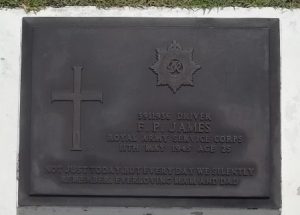
Stanley James, Private, 4034013, King’s Shropshire Light Infantry. Stanley was born in 1919, the son of Alfred James and Margaret James (nee Bevan), of 290, King Street, Brynmawr. His father was originally from the small village of Nevern, in Pembrokeshire. Stanley enlisted into the army and was posted to the 2nd Battalion, King’s Shropshire Light Infantry. The battalion had begun the war in Jamaica, with a company detached to the Bermuda Garrison, before returning to Britain to join the 185th Infantry Brigade, 79th Armoured Division. The brigade then transferred to the 3rd Infantry Division in April 1943; however, it was replaced by the 1st Canadian Infantry Division. The 185th Brigade then took part in the D-Day landings of 6 June 1944, landing at Sword Beach, and joined the great fight to break out of the beaches before heading for Caen. The brigade initially failed to capture Caen due to the presence of the 21st Panzer Division, but gallantly fought in the successful Operation Goodwood, which saw Caen fall. Stanley was killed during Operation Goodwood on 18 July 1944. The 25-year-old was buried in Ranville War Cemetery, France.
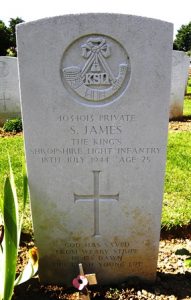
Aneurin Jones, Leading Aircraftman, 1124465, Royal Air Force Volunteer Reserve. Aneurin was born on 22 March 1907, the son of Hugh Wesley Jones and Georgina Jones (nee Presdee), of 46, Bailey Street, Brynmawr. He married Mabel Thomas in 1931 and the couple set up home at 21, Bwlfa Road, Aberdare, where Aneurin worked as a colliery labourer. He enlisted into the Royal Air Force Volunteer Reserve soon after the outbreak of war and was posted to RAF Fairwood Common, near Swansea. Aneurin took ill early in 1943 and was admitted to the Princess Royal Hospital at Swansea, where he died of pulmonary tuberculosis on 2 March 1943. The body of the 36-year-old was brought home to Brynmawr, and he was buried in Brynmawr Cemetery.
Edwin Kershaw, Ordinary Seaman, D/JX 399986, Royal Navy. Edwin was born on 3 January 1924, the son of Edwin Oliver Kershaw and Mary Elizabeth Kershaw (nee Williams), of Brynmawr. He enlisted into the Royal Navy as a young man and was posted aboard the aircraft carrier HMS Attacker. She was an American built vessel which had been transferred to the Royal Navy as part of the Lend-Lease agreement and was used as an escort carrier, to protect convoys. After completing her sea trials in November 1942, she began escort duties in the Atlantic, before transferring to the Mediterranean on 7 September 1943. Edwin was badly injured when he accidentally walked into a spinning aircraft propellor during a very busy operational period on 10 September 1943 and died that same day. The 19-year-old was buried at sea, so is commemorated on the Plymouth Naval Memorial, Devon.
Albert Edward Anderson Matthews, DFC, Flight Lieutenant, 156039, Royal Air Force Volunteer Reserve. Albert was born on 8 August 1913, the son of Albert Edward Matthews and Gertrude Sarah Matthews (nee Anderson), of 1, Davies Terrace, Brynmawr. He was educated at Christ College before running his own grocery at Brecon and married Edith Mary Prosser at Brecon in 1937. Albert enlisted into the Royal Air Force Volunteer Reserve soon after the outbreak of war and after training as a Flight Engineer was posted to 49 Squadron, Royal Air Force, which was an RAF Bomber Command unit, based at RAF Fiskerton, in Lincolnshire. On 21 June 1944 Albert took off from Fiskerton aboard Avro Lancaster I, Serial LL900, as part of a large force of 130 bombers despatched to hit the synthetic oil plant at Wesseling. Aboard the aircraft was the BBC War Correspondent, Kent Stephenson. Albert and the crew were all killed when the Lancaster was intercepted and shot down by a German night fighter on the following morning, 22 June 1944. All of the crew of seven, and the BBC correspondent, were originally buried in Welldorff Cemetery, Germany, but in June 1947 their graves were exhumed, and the men were buried together in Rheinberg War Cemetery, Germany. Albert had been awarded the Distinguished Flying Cross during the war.
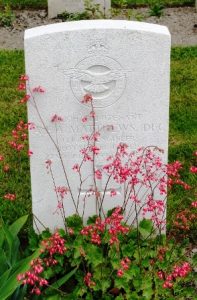
Stewart John Miles, Flight Sergeant, 751786, Royal Air Force Volunteer Reserve. Stewart was born at Swansea on 16 April 1920, the son of William George Miles and Catherine Miles (nee John). The family later moved to 22a, Greenland Road, Brynmawr. Stewart enlisted into the Royal Air Force Volunteer Reserve soon after the outbreak of war and after training as an Observer was posted to the Far East to join 31 Squadron, Royal Air Force. The squadron had spent the early part of the war stationed at the North-West Frontier, then in April 1941, the Squadron started to be equipped with Douglas DC-2s and began flying support missions to RAF Habbaniya during the Iraqi uprising and in the ensuing Anglo-Iraqi War. The squadron then returned to India, re-equipping with the Douglas Dakota Mk. I, and began operations dropping supplies for the 14th Army from its base at Lahore. On 24 July 1942 Stewart was flying in a DC-2 when it crashed into a Hill in the Nandi Forest in thick cloud, killing him and three other crewmen. The 22-year-old is buried in Madras War Cemetery, Chennai, India.
Edward Lewis Morgan, Gunner, 1605307, Royal Artillery. Edward was born on 10 December 1912, the son of Edward Morgan and Hannah Morgan (nee Lewis), of 10, Rhyd Clydach, Brynmawr. He worked as a labourer prior to the war. Edward enlisted into the Royal Artillery and was posted to the Far East, joining the 3rd Heavy Anti-Aircraft Regiment, Royal Artillery, which formed part of the vast Singapore Garrison. The regiment was made up of three batteries: 11 Battery, at Ayer Hitam, was equipped with 6 x 3.7-inch guns; whilst 29 and 30 Batteries at Singapore City were equipped with 8 x 3.7-inch guns each. Singapore was the foremost British military base and economic port in South–East Asia and was known as the ‘Gibraltar of the East’. It was strongly garrisoned and was thought to be impregnable. On 8 December 1941 the Japanese launched a series of simultaneous attacks against Pearl Harbour, Malaya, Thailand and the Pacific Islands. The Japanese had a force of some 30,000 troops involved in the Malayan invasion but soon reached the outer defences of Singapore following a short period of intense fighting. General Percival, commanding a garrison of some 85,000 troops in Singapore was ordered by Winston Churchill to fight to the last man, however, on 15 February 1942 he surrendered, and 80,000 troops were marched into captivity. Edward and his surviving comrades were incarcerated in appalling conditions at Changi Jail after their surrender but were then sent to camp M-616 in Thailand to work on the Thai-Burma railway. Edward died in captivity on 24 March 1943. The 30-year-old was originally buried in Kanburi Paper Mill Cemetery, but in January 1946 the graves within the cemetery were exhumed and re-interred in Kanchanaburi War Cemetery, Thailand.
Owen Glyn Morris, Private, 4619671, East Yorkshire Regiment. Owen was born in 1916, the son of Tudor John Morris and Jennet Maggie Morris (nee Williams), of 10, Windsor Road, Brynmawr. He enlisted into the army and was posted to the 5th Battalion, East Yorkshire Regiment. The battalion was attached to the 69th Infantry Brigade, 23rd (Northumbrian) Division and had been in France with the BEF in 1940, before being evacuated from Dunkirk. Upon its return to England, the 5th East Yorks transferred to the 50th (Northumbrian) Division and embarked for North Africa, serving through the Western Desert, Tunisian and Sicily campaigns before being recalled to Britain to prepare for the invasion of occupied Europe. The battalion landed with the division among the first wave on Gold Beach on D-Day, 6 June 1944, taking part in the heavy fighting to break out from the Normandy Beaches. The division then fought in the Battle for Caen, before breaking out of Normandy and joined the great drive through Northern France into Belgium and Holland over the coming weeks. The division then took part in Operation Market Garden, Montgomery’s audacious plan to seize the Rhine crossings in an attempt to shorten the war. The operation was launched on 17 September 1943 and the division joined the great advance towards Arnhem over the coming days, seeing heavy fighting at Valkenswaard and Nijmegen. Owen was killed during heavy fighting around Bemmel on 25 September 1944. The 28-year-old was originally buried in a temporary battlefield cemetery near Lent, but in September 1945 all of the graves were exhumed and re-interred in Arnhem Oosterbeek War Cemetery, Netherlands.
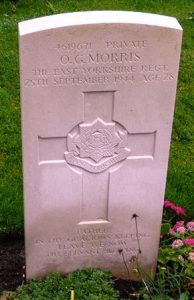
Cyril Overton, Private, 3913098, South Staffordshire Regiment. Cyril was born on 4 March 1915, the son of Thomas Henry Overton and Elizabeth Ann Overton (nee Jones), of 74, Worcester Street, Brynmawr. He worked as a builder’s labourer prior to the war. Cyril enlisted into the army and was posted to the South Staffordshire Regiment and was selected for parachute training, before joining the 2nd (Airborne) Battalion, South Staffordshire Regiment. The battalion had begun the war as a normal infantry unit, but in 1941 was converted to a glider infantry role, becoming attached to the 1st Airlanding Brigade, 1st Airborne Division. The 1st Airborne Division left England for North Africa in June 1943 and was based in the Oran area on the Algerian coast, joining the Eighth Army. The division then began training for the Allied invasion of Sicily, code-named Operation Husky. The 1st Parachute Brigade was assigned to Operation Fustian with orders to seize and hold the Primosole Bridge over the River Simeto, whilst the 1st Airlanding Brigade was to take part in Operation Ladbroke, a glider assault on the Ponte Grande bridge across the Anapo river south of Syracuse, ordered to hold the bridge until relieved. On 9 July 1943 over 2,000 men of the 1st Airlanding Brigade boarded their gliders in Tunisia and took off at 18.00 bound for Sicily. Some gliders were released too early and 65 of them crashed into the sea, drowning around 252 men, whilst only 12 landed at the correct landing-zones. Several gliders were shot down, and 59 landed too far from their target, whilst some failed to release, so returned to Tunisia. For the men who reached the bridge a swift firefight saw the bridge captured and the survivors dug in. Altogether during the landings in Sicily, the losses by the 1st Airlanding Brigade were the worst of all the British units involved, with some 313 killed and 174 missing or wounded. Cyril was killed at some time during the day. The 28-year-old has no known grave and is commemorated on the Cassino Memorial, Italy.
William J. Pearce, Steward, D/LX. 721947, Royal Navy. William was born in 1925, the son of William Pearce and Blodwen Pearce (nee Woods), of 12, Henderson Road, Brynmawr. He married Glenys George, of Brynmawr, in 1944. William had served throughout the latter part of the war with the Royal Navy. He survived the war but died on 31 January 1947. The 21-year-old is buried in Brynmawr Cemetery.
Reginald Charles Pritchard, Private, 13069866, Pioneer Corps. Reginald was born in 1919, the son of Abraham James Pritchard and Beatrice Louisa Pritchard (nee Sheen), of 115, King Street, Brynmawr. He enlisted into the army soon after the outbreak of war and was posted to the Pioneer Corps. Reginald died in Swansea on 28 April 1943, just two days after an air raid on the town. The remains of the 24-year-old were brought home and he was buried in St. Mary’s Church Burial Ground, Brynmawr.
William Alfred Prout, Private, 13082033, Pioneer Corps. William was born on 20 November 1914, the son of Thomas Prout and Emily Prout (nee Vaughan), of 65, King Street, Brynmawr. His father died whilst en-route for Aden in 1915 whilst serving with the Brecknockshire Battalion, South Wales Borderers. His mother remarried to Thomas Webber in 1921, and the couple moved to Oakdale, Blackwood with William and his brother David. William enlisted into the army and was posted to the Pioneer Corps, embarking for North Africa to join the 204th Company, Pioneer Corps. Following the capitulation of the Afrika Korps the Allies turned their attention to liberating Italy, so on 9 July 1943 launched an invasion of Sicily, which was to be used as a jumping board to land on mainland Italy. William was killed on Sicily together with five other men from is unit on 17 July 1943. The 29-year-old was originally buried beside his comrades on the battlefield but in December 1943 their graves were exhumed, and he was re-interred in Syracuse War Cemetery, Sicily, Italy. William is not commemorated on the Brynmawr Cenotaph.
Terence Ransome, Serjeant, 3910641, Monmouthshire Regiment. Terence was born in 1919, the son of William James Ransome and Blodwen Ransome (nee Lewis), of 126, King Street, Brynmawr. He enlisted into the army and was posted to the 3rd Battalion, Monmouthshire Regiment. The battalion, a Territorial Army unit, was mobilised for war as part of the 53rd (Welsh) Division and moved to Northern Ireland to begin garrison duties. The Division then moved to Pembroke Dock, before moving again to the south of England, where it trained in readiness for the D-Day Landings. In the summer of 1942, the 3rd Monmouth’s transferred to the 11th Armoured Division and began training as a mechanised unit, equipped with Valentine and Crusader tanks. Most of the 11th Armoured Division landed on Juno Beach on 13 June 1944 and saw its first major action during Operation Epsom on 26 June, where it assisted the 15th (Scottish) Division alongside the 159th Brigade, which had been attached to it from the 53rd (Welsh) Division. Terence was killed in action on 28 June 1944, on the second day of the battle. The 24-year-old was buried with several other men of the battalion on the battlefield near Mouen, but in April 1946 their graves were exhumed and re-interred in Banneville-La-Campagne War Cemetery, France.
Aneurin Roberts, Able Seaman, C/JX 208663, Royal Navy. Aneurin was born on 29 February 1916, the son of Oswald Roberts and Ellen Roberts (nee Lewis), of 159, King Street, Brynmawr. He enlisted into the Royal Navy and was posted to HMS President III, before being posted aboard the oil tanker MV Anadara. The tanker left Heysham on 9 February 1942 in ballast, for the Clyde, then joined Convoy ONS-67 to sail across the Atlantic via Halifax for Curacao. At 09.50 on 24 February 1942, Anadara, straggling behind the main convoy, was torpedoed by the German submarine U-558 and was hit by one torpedo, which exploded, ripping a hole in her side. The submarine then surfaced to finish the stricken tanker with her deck gun, and Anadara went down with the loss of 61 lives. Aneurin was 26 years old when he was killed that day. He has no known grave so is commemorated on the Chatham Naval Memorial, Kent.
Evan George Smart, Private, 3966212, Welch Regiment. Evan was born on 4 November 1917, the son of George Smart and Mary Ann Smart (nee Meredith), of 29, Worcester Street, Brynmawr. He worked as a steel shutterer prior to the war. Evan enlisted into the army and was posted to the 4th Battalion, Welch Regiment, a Territorial Army battalion, raised in Carmarthenshire, which was attached to the 160th Brigade, 53rd (Welsh) Division. The battalion was mobilised at the outbreak of war, when the Division moved to Northern Ireland to begin garrison duties. The Division then moved to Pembroke Dock, before moving again to the south of England, where it trained in readiness for the D-Day Landings. On 24 June 1944 the division began leaving England for Normandy, and landed at La Riviere near Ver Sur Mer. The Division then took part in heavy fighting over the coming weeks, as part of the effort to break-out of the Normandy beachhead, seeing heavy fighting at Évrecy, before starting the epic advance through Northern France into Belgium and Holland. On 15 September the Division forced the crossing of the Junction Canal North of Lommel, and continued to push westwards towards Elst, between Nijmegen and Arnhem, during Operation Market Garden. On 22 October the Division launched its famous assault on ‘s-Hertogenbosch, before continuing its advance to the German frontier. Between December 1944 and January 1945, the Division took part in the Battle of the Bulge, helping in the counterattack which helped save the Americans, who were under heavy pressure, then after the German offensive was broken, took part in heavy fighting to enter the Rhineland, taking part in Operation Plunder, the Rhine Crossings, in March 1945. Evan was killed here on 7 March 1945, during an assault by the 4th Welch on the high ground near the village of Alpon. The 27-year-old was originally buried near Issum, but in March 1947 his grave was exhumed, and he was re-interred in Reichswald Forest War Cemetery, Germany.
Cyril George Smith, Private, 14574533, Monmouthshire Regiment. Cyril was born in 1924, the son of Albert Smith and Elvira Smith (nee Williams), of Glen View, Clydach Street, Brynmawr. He enlisted into the army and was posted to the 2nd Battalion, Monmouthshire Regiment, a Territorial Army unit. The battalion mobilised at the outbreak of war attached to the 160th Infantry Brigade, 53rd (Welsh) Division. The battalion was mobilised at the outbreak of war, when the Division moved to Northern Ireland to begin garrison duties. The Division then moved to Pembroke Dock, before moving again to the south of England, where it trained in readiness for the D-Day Landings. On 23 June 1944 the division began leaving England for Normandy, and landed at La Riviere near Ver Sur Mer. The Division then took part in heavy fighting over the coming weeks, as part of the effort to break-out of the Normandy beachhead, seeing heavy fighting during Operation Epsom. Cyril was killed near Hill 112 on 7 July 1944. The 19-year-old was originally buried near Grainville-sur-Odon, but in December 1945 his grave was exhumed, and he was re-interred in St. Manvieu War Cemetery, Cheux, France.
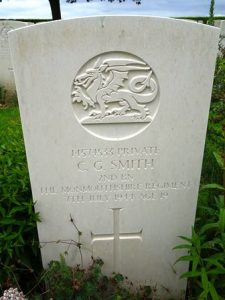
Vernon Frank Evans Treherne, DFM, Flying Officer, 44980, Royal Air Force. Vernon was born in Abergavenny in 1920, the son of Frank Treherne and Emily Treherne (nee Evans). He married Mary Wheeler at Brynmawr in 1941. Vernon enlisted into the Royal Air Force and after training as an observer was posted to 139 Squadron, Royal Air Force, which was an elite unit, equipped with the De Havilland Mosquito. On 2 July 1942, Vernon took off from RAF Horsham St Faith, in Norfolk aboard a Mosquito Biv, Serial DK294, on a raid on the U-Boat yards at Flensburg, together with five other Mosquitos. Vernon was killed when his Mosquito was intercepted by a German Focke Wolfe 190 and crashed into the North Sea, killing him and his pilot, A. R. Oakshott. Vernon was just 22 years old when he was killed. He has no known grave and is commemorated on the Runnymede Memorial, Surrey. Vernon is not commemorated on the Brynmawr Cenotaph.
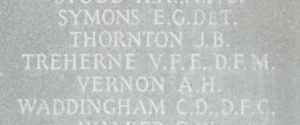
Alfred Mervyn Turner, Schoolmaster Warrant Officer, Royal Navy. Alfred was born in Newport on 8 February 1913, the son of Frederick John Turner and Gwenllian Carthew Turner (nee Oates). He was educated at Newport High School, before becoming a schoolmaster at Brynmawr, and lived at Penoyre, Alma Street, Brynmawr prior to the war. Alfred enlisted into the Royal Navy soon after the outbreak of war and was posted aboard the County-class cruiser HMS Shropshire, in the capacity of Schoolmaster. After the outbreak of war, Shropshire was reassigned to the South Atlantic for trade protection patrols. Shropshire returned to Britain for a refit in early 1940, before proceeding to the Indian Ocean, where she was employed on convoy duties and then took part in the campaign against Italian Somaliland then underwent a refit at Simon’s Town between March and June 1941, before coming back to Britain for a major refit. Alfred took ill upon his return to Britain and was admitted to Cefn Mably Hospital, at Llanfedw, where he died of pulmonary tuberculosis on 19 December 1941. The 28-year-old was buried in St. Woolos Cemetery, Newport.
Thomas Henry Vaughan, Gunner, 1737955, Royal Artillery. Thomas was born on 27 April 1909, the son of Thomas Henry Vaughan and Mary Jane Vaughan (nee Prisk), of 91, Worcester Street, Brynmawr. He worked as a plumber and married Margaret Morgan, of Brynmawr, in 1940. Thomas enlisted into the Royal Artillery and was posted to the 333rd Battery, 101st Light Anti-Tank Regiment, Royal Artillery, which formed in December 1941 from the 12th Battalion, King’s (Liverpool) Regiment. After initial training the regiment joined Anti-Aircraft Command, then moved to East Anglia, before embarking for North Africa in early February 1943, joining the 8th Anti-Aircraft Brigade at El Tahag in Egypt. Thomas died in Egypt on 2 October 1943, just prior to the regiments move to Italy. The 33-year-old is buried in Tel El Kebir War Memorial Cemetery, Egypt.
Wilfred John Vaughan, Driver, 1922313, Royal Engineers. Wilfred was born on 1 October 1917, the son of Alfred Ernest Vaughan and Mary Jane Vaughan (nee Evans), of 4, Clydach Dingle, Brynmawr. He worked as a motor lorry driver prior to the war. Wilfred enlisted into the Royal Engineers and was posted to 282 Field Company, Royal Engineers as a driver. The battalion was attached to the 53rd (Welsh) Division and moved to Northern Ireland on garrison duties soon after the outbreak of war. Wilfred married Jeane whilst based in Armagh, Northern Ireland. The Division then moved to Pembroke Dock, before moving again to the south of England, where it trained in readiness for the D-Day Landings. On 23 June 1944 the division began leaving England for Normandy, and landed at La Riviere near Ver Sur Mer. The Division then took part in heavy fighting over the coming weeks, as part of the effort to break-out of the Normandy beachhead, seeing heavy fighting at Évrecy, before starting the epic advance through Northern France into Belgium and Holland. On 15 September the Division forced the crossing of the Junction Canal North of Lommel, and continued to push westwards towards Elst, between Nijmegen and Arnhem, during Operation Market Garden. On 22 October the Division launched its famous assault on ‘s-Hertogenbosch, before continuing its advance to the German frontier. Wilfred died near Groesbeek on 2 December 1944. The 26-year-old is buried in Groesbeek Canadian War Cemetery, Netherlands.
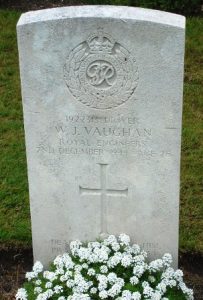
Samuel Max Watkins, Private, 3913651, Welch Regiment. Samuel was born on 22 February 1912, the son of Urbine Watkins and Margaret Diana Watkins (nee Caddick), of 173, King Street, Brynmawr. He was residing at 7, Kenilworth Road, Willesden, Middlesex by 1939 and worked as a house painter. Samuel enlisted into the army and was posted to the 2nd Battalion, Welch Regiment. The battalion was stationed at Agra, India when war broke out, then moved to Bombay before moving again to Bangalore. Following the Japanese invasion of Burma and Malaya in December 1941, the 2nd Welch began preparing to move, arriving at Calcutta in February 1942 to join the 62nd Indian Infantry Brigade, 19th Indian Division. Frustratingly for the men, the division did not join the fight against the Japanese for another two years before moving from India to Burma in October 1944, moving to a camp on the Imphal to Kohima Road, to join the Fourteenth Army. From October the division concentrated on the Imphal plain under IV Corps and from November began operations on the Chindwin River advancing to establish contact with the 36th Infantry Division. The combined divisions then concentrated at Sinlamaung under the command of the Indian XXXIII Corps and played the major role in the capture of Mandalay which was completed on 20 March 1945. The 19th Indian Division then transferred to IV Corps and guarded the Fourteenth Army’s lines of communication before launching an offensive towards Mawchi, in the Kayah State. In May 1945 the division crossed the Sittang to begin operations east of Toungou and met with a spirited Japanese resistance as they slowly advanced. Samuel was killed near Toungou on 28 July 1945 when a convoy he was travelling in was ambushed by Japanese troops. The 33-year-old was originally buried in Toungou Military Cemetery, but in October 1946 the war graves within the cemetery were exhumed and re-interred in Rangoon War Cemetery, Myanmar.
Clifford Wilcox, Corporal, 5255688, Royal Hampshire Regiment. Clifford was the son of George Henry Wilcox and Sarah Ann Wilcox (nee Bevan), of Beaufort. He married Edyth Date, of 5, Bryngwyn Road, Beaufort, in 1943. Clifford enlisted into the army and was posted to the 2nd Battalion, Royal Hampshire Regiment. The battalion was a regular army unit which had fought in France with the BEF in 1940 and saw heavy fighting on the Maginot Line before withdrawing to Dunkirk for evacuation. The battalion then spent two years on home defence, training and preparing for a potential German invasion. In November 1942, the battalion sailed for North Africa attached to the 1st Guards Brigade, 78th Infantry Division, to take part in Operation Torch. After disembarking at Algiers on 21 November to join the First Army, the 2nd Hampshire’s moved to Tebourba where it undertook a prolonged period of heavy fighting, during a rear-guard action which saw Major Wallace Le Patourel of the battalion awarded the Victoria Cross for his gallantry in leading counterattacks against the enemy. After the fall of Tunis on 13 May 1943, the 2nd Hampshire’s joined the 128th (Hampshire) Brigade, 46th Infantry Division and took part in the invasion of mainland Italy, landing at Salerno in September 1943. Clifford was killed during the attacks on the Gothic Line on 30 August 1944. The 29-year-old is buried in Montecchio War Cemetery, Italy.
Albert Henry Williams, Warrant Officer, 7591807, Royal Army Ordnance Corps. Albert was the husband of Marie Williams (nee Morgan), of 6, Market Square, Brynmawr. He enlisted into the Royal Army Ordnance Corps and was posted to a military base in Yorkshire. Albert died on active service in Yorkshire on 22 January 1942. The remains of the 38-year-old were brought home and he was buried in St. Mary’s Church Burial ground, Brynmawr.
Hugh John Williams, Flight Sergeant, 956899, Royal Air Force Volunteer Reserve. Hugh was born in 1918, the soon of Caleb Williams and Elizabeth Ann Williams (nee Phillips), of 9, Lower Bailey Street, Brynmawr. He enlisted into the Royal Air Force Volunteer Reserve and after training as a pilot was posted to the 20th Advanced (Pilots) Flying Unit, which was based at RAF Kidlington, in Oxfordshire. The unit was used to train freshly qualified pilots on twin engine aircraft. Hugh was flying an Airspeed Oxford I, Serial MP473 from Kidlington on 3 January 1945 when he became lost in low cloud and crashed into the ground at Wickhambrook, some six miles North of Clare, in Suffolk. The body of the 26-year-old was recovered from the wreckage and brought back home for burial in Brynmawr Cemetery.
Idris Williams, Gunner, 818190, Royal Artillery. Idris was born on 9 November 1912, the son of Daniel Williams and Emily Jane Williams (nee James), of 49, King Street, Brynmawr. He married Eileen Mary Walker at Peterborough in 1932 and the couple set up home at Leicester, where Idris had gone to work as a bricklayer’s labourer. Idris enlisted into the Royal Artillery soon after the outbreak of war. Idris died at Oxford on 30 June 1940. The remains of the 27-year-old were brought back to Brynmawr, and he was buried in St. Mary’s Church Burial ground, Brynmawr. Idris is not commemorated on the Brynmawr Cenotaph.
Thomas Williams, Fusilier, 4208440, Royal Welch Fusiliers. Thomas was born in 1922, the son of Thomas Williams and Elsie May Williams (nee Hughes), of 29, Lansbury Road, Brynmawr. He enlisted into the army and was posted to the 2nd Battalion, Royal Welch Fusiliers. The Battalion was part of the 29th Independent Infantry Brigade and in 1942, it fought in the Battle of Madagascar, before being transferred to the South-East Asian Theatre. In 1944, the brigade became part of the 36th Infantry Division and trained in amphibious assault operations before entering Burma on 12 February 1944. The Division returned to India in June 1944 before flying into North Burma in August 1944 and advancing south to Mandalay. Thomas was killed soon afterwards, on 26 August 1944. The 22-year-old was originally buried in Sahmaw Christian War Cemetery, but in June 1954 the war graves in the cemetery were exhumed and re-interred in Taukkyan War Cemetery, Myanmar.
Verdun Thomas Williams, Marine, EX/724, Royal Marines. Verdun was born in Walthamstow on 9 September 1918, the son of Thomas Charles Williams and Annie Grace Williams (nee Brennan). He was baptised at Blaina the following month, then the family moved to Brynmawr. Verdun enlisted into the Royal Marines and after completing his training was posted to the 11th Royal Marine Landing and Maintenance Unit, Mobile Naval Base Defence Organisation 1. Verdun was taken prisoners by the Germans during the early stages of the war and was incarcerated in Germany. He became ill in captivity and died of tuberculosis at Konigswartha, Germany on 18 April 1942, whilst a prisoner of war. The 23-year-old was originally buried in Konigswartha Cemetery, but in June 1947 the Commonwealth burials within the cemetery were exhumed and re-interred in Berlin 1939-1945 War Cemetery, Germany.
David William Wyatt, Flight Sergeant, 512841, Royal Air Force. David was born in Devonport in 1912, the son of George Walter Wyatt and Ada Wyatt (nee O’Connell). He married Marie Louise Danter in 1938 and the couple had two sons born over the coming years. David enlisted into the Royal Air Force and trained as a Wireless Operator/Air Gunner before being posted to 21 Squadron, Royal Air Force, which was based at RAF Manston. On 18 July 1941, David took off from Manston aboard a Bristol Blenheim IV, Serial Z7502 on an anti-shipping patrol in the English Channel. The Blenheim was shot down by a German Flak Ship off Cap Gris-Nez and crashed into the sea off Dunkirk, killing David. His pilot and observer survived and were taken prisoner by the Germans. David was 29 years old when he lost his life that day. He has no known grave and is commemorated on the Runnymede Memorial, Surrey. His widow, Marie, lived in Brynmawr after his death, but David is not commemorated on the Brynmawr Cenotaph.
